HLT54115 Diploma of Nursing.
VerifiedAdded on 2022/10/19
|32
|12593
|13
AI Summary
Contribute Materials
Your contribution can guide someone’s learning journey. Share your
documents today.
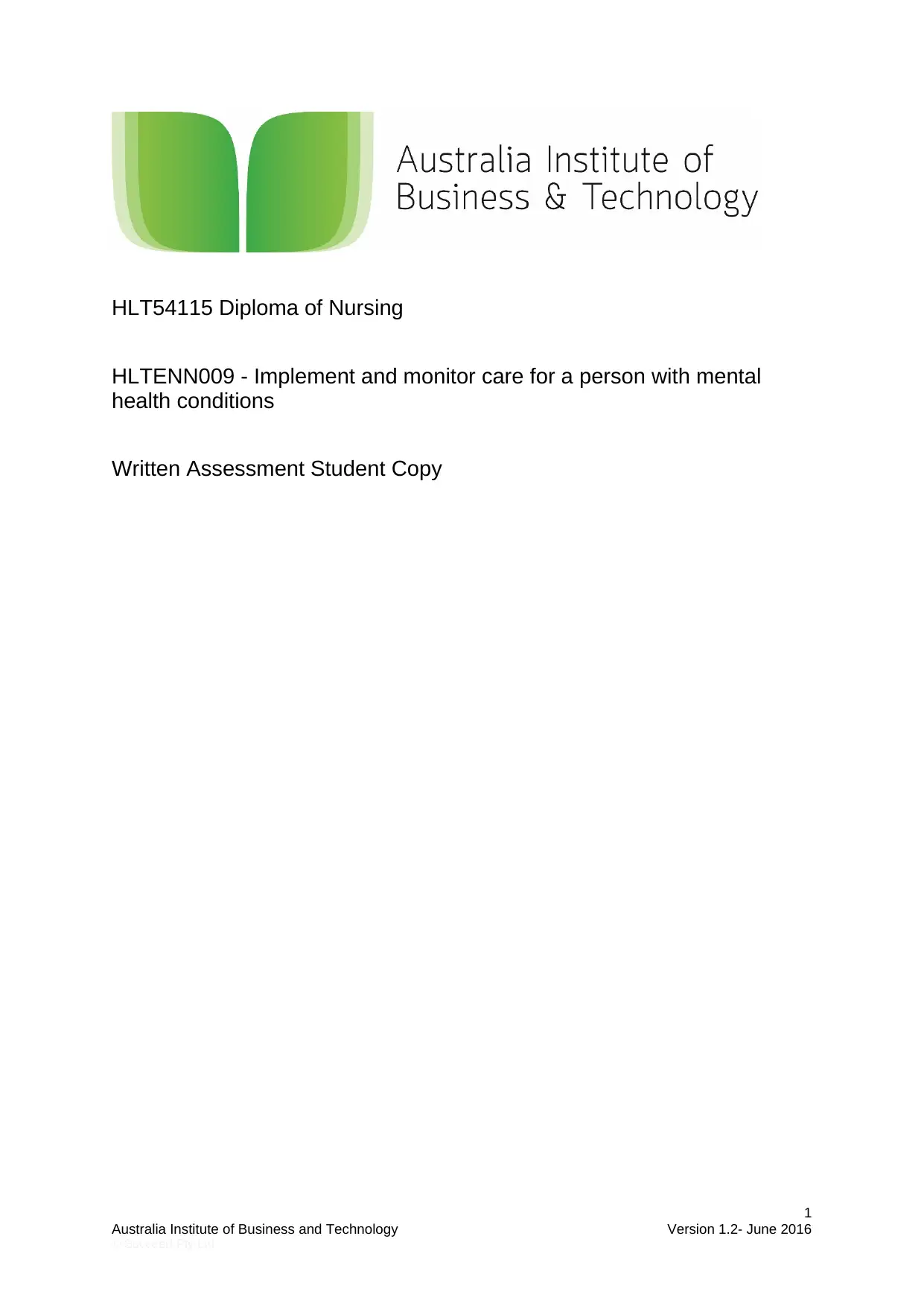
HLT54115 Diploma of Nursing
HLTENN009 - Implement and monitor care for a person with mental
health conditions
Written Assessment Student Copy
1
Australia Institute of Business and Technology Version 1.2- June 2016
© Succeed Pty Ltd
HLTENN009 - Implement and monitor care for a person with mental
health conditions
Written Assessment Student Copy
1
Australia Institute of Business and Technology Version 1.2- June 2016
© Succeed Pty Ltd
Secure Best Marks with AI Grader
Need help grading? Try our AI Grader for instant feedback on your assignments.

Instructions to Students
Welcome to the written assessment. To successfully complete the assessment
requirements, you need to follow the following instructions.
Step 1
Read the study guide and the related resources.
Step 2
Read this assessment to gain an understanding of what you need to do to complete the unit.
Talk to your trainer or supervisor and ask for help if you need to.
Step 3
Complete all questions in this assessment. Please write clearly in pen (not pencil). You
may attach printed answers if you prefer. Do not remove any pages from this assessment.
Step 4
Complete the cover sheet and attach to this assessment. We recommend you make and
keep a copy of your assessments.
Step 5
Submit for assessment.
2
Australia Institute of Business and Technology Version 1.2- June 2016
© Succeed Pty Ltd
Welcome to the written assessment. To successfully complete the assessment
requirements, you need to follow the following instructions.
Step 1
Read the study guide and the related resources.
Step 2
Read this assessment to gain an understanding of what you need to do to complete the unit.
Talk to your trainer or supervisor and ask for help if you need to.
Step 3
Complete all questions in this assessment. Please write clearly in pen (not pencil). You
may attach printed answers if you prefer. Do not remove any pages from this assessment.
Step 4
Complete the cover sheet and attach to this assessment. We recommend you make and
keep a copy of your assessments.
Step 5
Submit for assessment.
2
Australia Institute of Business and Technology Version 1.2- June 2016
© Succeed Pty Ltd
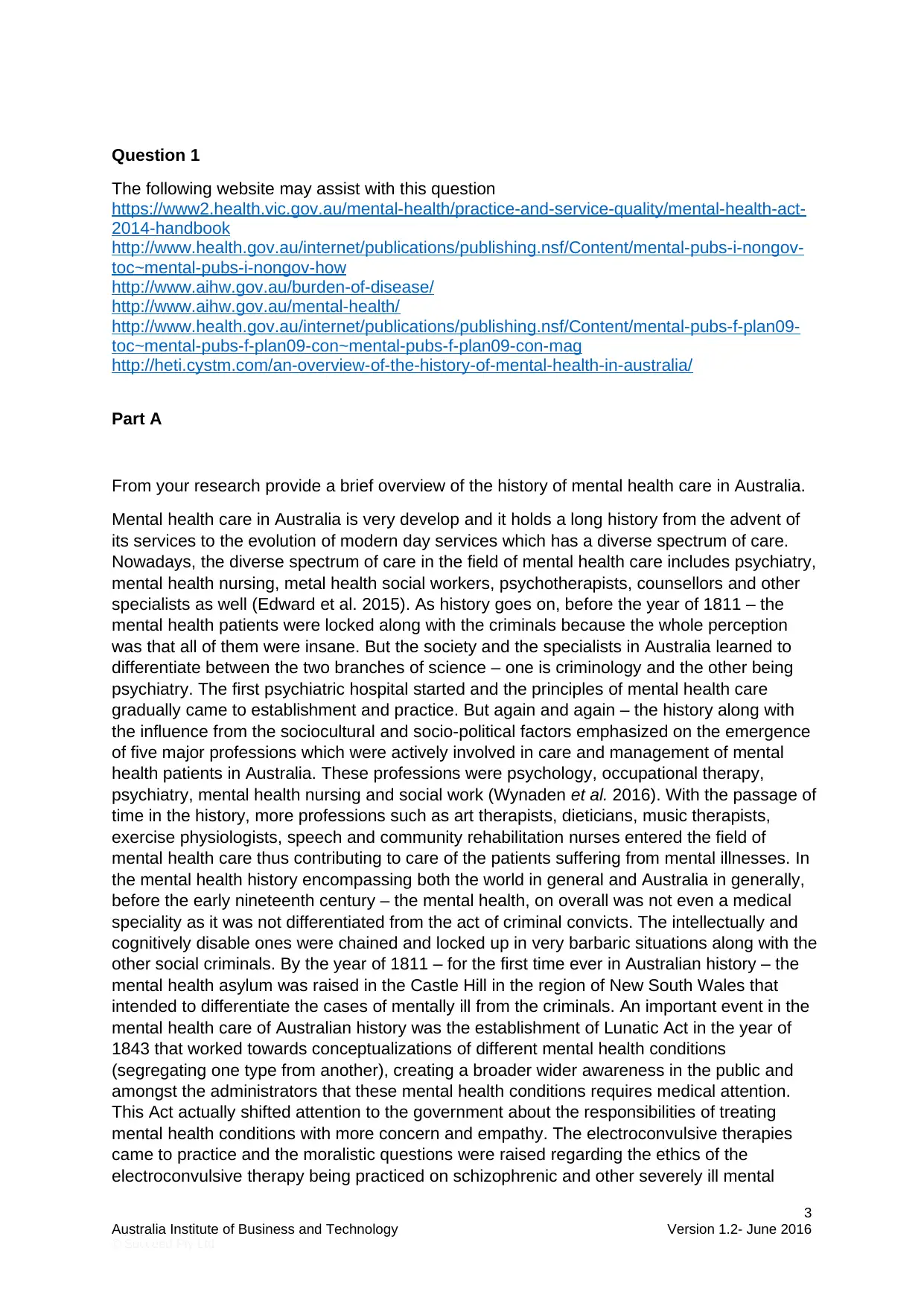
Question 1
The following website may assist with this question
https://www2.health.vic.gov.au/mental-health/practice-and-service-quality/mental-health-act-
2014-handbook
http://www.health.gov.au/internet/publications/publishing.nsf/Content/mental-pubs-i-nongov-
toc~mental-pubs-i-nongov-how
http://www.aihw.gov.au/burden-of-disease/
http://www.aihw.gov.au/mental-health/
http://www.health.gov.au/internet/publications/publishing.nsf/Content/mental-pubs-f-plan09-
toc~mental-pubs-f-plan09-con~mental-pubs-f-plan09-con-mag
http://heti.cystm.com/an-overview-of-the-history-of-mental-health-in-australia/
Part A
From your research provide a brief overview of the history of mental health care in Australia.
Mental health care in Australia is very develop and it holds a long history from the advent of
its services to the evolution of modern day services which has a diverse spectrum of care.
Nowadays, the diverse spectrum of care in the field of mental health care includes psychiatry,
mental health nursing, metal health social workers, psychotherapists, counsellors and other
specialists as well (Edward et al. 2015). As history goes on, before the year of 1811 – the
mental health patients were locked along with the criminals because the whole perception
was that all of them were insane. But the society and the specialists in Australia learned to
differentiate between the two branches of science – one is criminology and the other being
psychiatry. The first psychiatric hospital started and the principles of mental health care
gradually came to establishment and practice. But again and again – the history along with
the influence from the sociocultural and socio-political factors emphasized on the emergence
of five major professions which were actively involved in care and management of mental
health patients in Australia. These professions were psychology, occupational therapy,
psychiatry, mental health nursing and social work (Wynaden et al. 2016). With the passage of
time in the history, more professions such as art therapists, dieticians, music therapists,
exercise physiologists, speech and community rehabilitation nurses entered the field of
mental health care thus contributing to care of the patients suffering from mental illnesses. In
the mental health history encompassing both the world in general and Australia in generally,
before the early nineteenth century – the mental health, on overall was not even a medical
speciality as it was not differentiated from the act of criminal convicts. The intellectually and
cognitively disable ones were chained and locked up in very barbaric situations along with the
other social criminals. By the year of 1811 – for the first time ever in Australian history – the
mental health asylum was raised in the Castle Hill in the region of New South Wales that
intended to differentiate the cases of mentally ill from the criminals. An important event in the
mental health care of Australian history was the establishment of Lunatic Act in the year of
1843 that worked towards conceptualizations of different mental health conditions
(segregating one type from another), creating a broader wider awareness in the public and
amongst the administrators that these mental health conditions requires medical attention.
This Act actually shifted attention to the government about the responsibilities of treating
mental health conditions with more concern and empathy. The electroconvulsive therapies
came to practice and the moralistic questions were raised regarding the ethics of the
electroconvulsive therapy being practiced on schizophrenic and other severely ill mental
3
Australia Institute of Business and Technology Version 1.2- June 2016
© Succeed Pty Ltd
The following website may assist with this question
https://www2.health.vic.gov.au/mental-health/practice-and-service-quality/mental-health-act-
2014-handbook
http://www.health.gov.au/internet/publications/publishing.nsf/Content/mental-pubs-i-nongov-
toc~mental-pubs-i-nongov-how
http://www.aihw.gov.au/burden-of-disease/
http://www.aihw.gov.au/mental-health/
http://www.health.gov.au/internet/publications/publishing.nsf/Content/mental-pubs-f-plan09-
toc~mental-pubs-f-plan09-con~mental-pubs-f-plan09-con-mag
http://heti.cystm.com/an-overview-of-the-history-of-mental-health-in-australia/
Part A
From your research provide a brief overview of the history of mental health care in Australia.
Mental health care in Australia is very develop and it holds a long history from the advent of
its services to the evolution of modern day services which has a diverse spectrum of care.
Nowadays, the diverse spectrum of care in the field of mental health care includes psychiatry,
mental health nursing, metal health social workers, psychotherapists, counsellors and other
specialists as well (Edward et al. 2015). As history goes on, before the year of 1811 – the
mental health patients were locked along with the criminals because the whole perception
was that all of them were insane. But the society and the specialists in Australia learned to
differentiate between the two branches of science – one is criminology and the other being
psychiatry. The first psychiatric hospital started and the principles of mental health care
gradually came to establishment and practice. But again and again – the history along with
the influence from the sociocultural and socio-political factors emphasized on the emergence
of five major professions which were actively involved in care and management of mental
health patients in Australia. These professions were psychology, occupational therapy,
psychiatry, mental health nursing and social work (Wynaden et al. 2016). With the passage of
time in the history, more professions such as art therapists, dieticians, music therapists,
exercise physiologists, speech and community rehabilitation nurses entered the field of
mental health care thus contributing to care of the patients suffering from mental illnesses. In
the mental health history encompassing both the world in general and Australia in generally,
before the early nineteenth century – the mental health, on overall was not even a medical
speciality as it was not differentiated from the act of criminal convicts. The intellectually and
cognitively disable ones were chained and locked up in very barbaric situations along with the
other social criminals. By the year of 1811 – for the first time ever in Australian history – the
mental health asylum was raised in the Castle Hill in the region of New South Wales that
intended to differentiate the cases of mentally ill from the criminals. An important event in the
mental health care of Australian history was the establishment of Lunatic Act in the year of
1843 that worked towards conceptualizations of different mental health conditions
(segregating one type from another), creating a broader wider awareness in the public and
amongst the administrators that these mental health conditions requires medical attention.
This Act actually shifted attention to the government about the responsibilities of treating
mental health conditions with more concern and empathy. The electroconvulsive therapies
came to practice and the moralistic questions were raised regarding the ethics of the
electroconvulsive therapy being practiced on schizophrenic and other severely ill mental
3
Australia Institute of Business and Technology Version 1.2- June 2016
© Succeed Pty Ltd
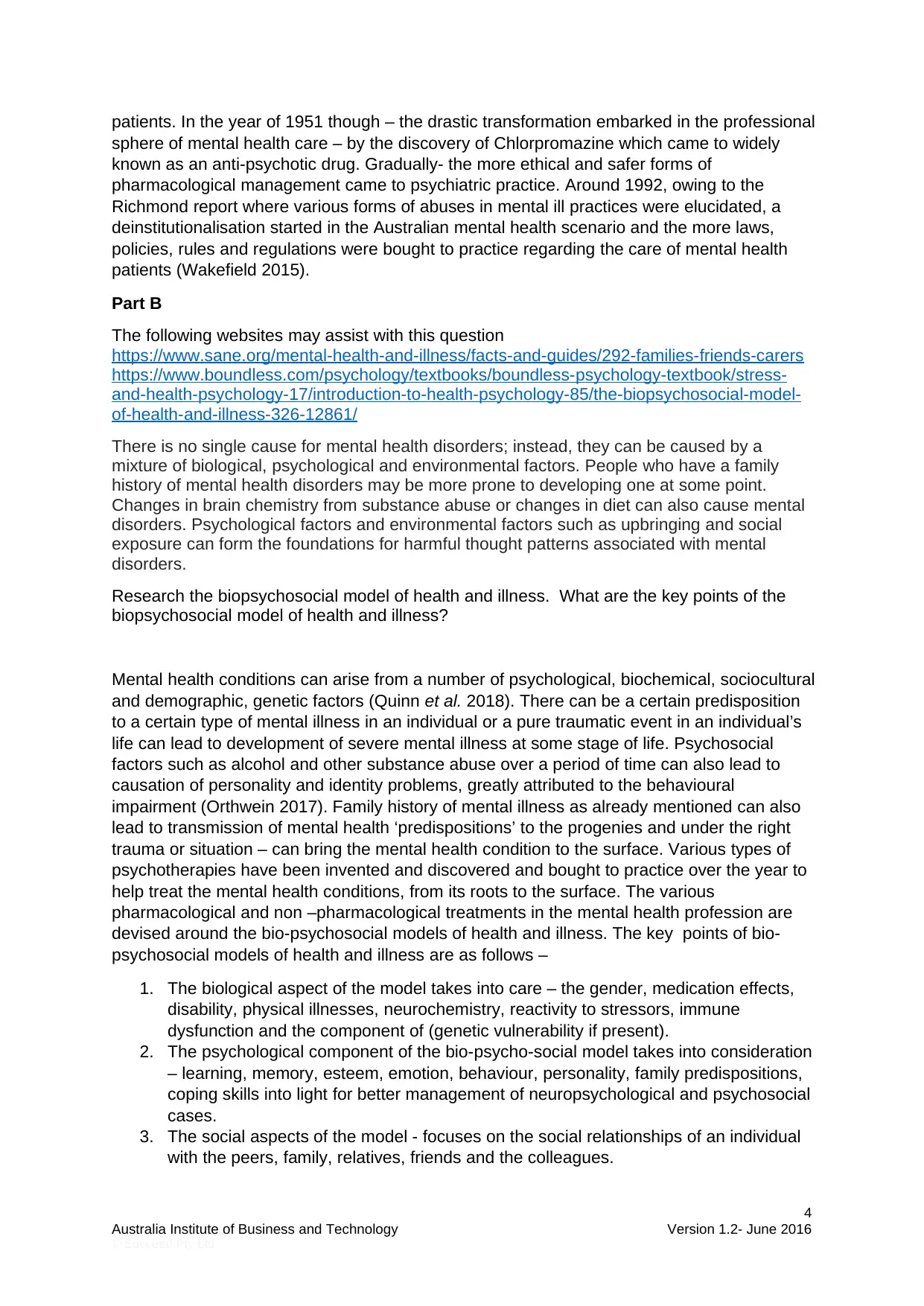
patients. In the year of 1951 though – the drastic transformation embarked in the professional
sphere of mental health care – by the discovery of Chlorpromazine which came to widely
known as an anti-psychotic drug. Gradually- the more ethical and safer forms of
pharmacological management came to psychiatric practice. Around 1992, owing to the
Richmond report where various forms of abuses in mental ill practices were elucidated, a
deinstitutionalisation started in the Australian mental health scenario and the more laws,
policies, rules and regulations were bought to practice regarding the care of mental health
patients (Wakefield 2015).
Part B
The following websites may assist with this question
https://www.sane.org/mental-health-and-illness/facts-and-guides/292-families-friends-carers
https://www.boundless.com/psychology/textbooks/boundless-psychology-textbook/stress-
and-health-psychology-17/introduction-to-health-psychology-85/the-biopsychosocial-model-
of-health-and-illness-326-12861/
There is no single cause for mental health disorders; instead, they can be caused by a
mixture of biological, psychological and environmental factors. People who have a family
history of mental health disorders may be more prone to developing one at some point.
Changes in brain chemistry from substance abuse or changes in diet can also cause mental
disorders. Psychological factors and environmental factors such as upbringing and social
exposure can form the foundations for harmful thought patterns associated with mental
disorders.
Research the biopsychosocial model of health and illness. What are the key points of the
biopsychosocial model of health and illness?
Mental health conditions can arise from a number of psychological, biochemical, sociocultural
and demographic, genetic factors (Quinn et al. 2018). There can be a certain predisposition
to a certain type of mental illness in an individual or a pure traumatic event in an individual’s
life can lead to development of severe mental illness at some stage of life. Psychosocial
factors such as alcohol and other substance abuse over a period of time can also lead to
causation of personality and identity problems, greatly attributed to the behavioural
impairment (Orthwein 2017). Family history of mental illness as already mentioned can also
lead to transmission of mental health ‘predispositions’ to the progenies and under the right
trauma or situation – can bring the mental health condition to the surface. Various types of
psychotherapies have been invented and discovered and bought to practice over the year to
help treat the mental health conditions, from its roots to the surface. The various
pharmacological and non –pharmacological treatments in the mental health profession are
devised around the bio-psychosocial models of health and illness. The key points of bio-
psychosocial models of health and illness are as follows –
1. The biological aspect of the model takes into care – the gender, medication effects,
disability, physical illnesses, neurochemistry, reactivity to stressors, immune
dysfunction and the component of (genetic vulnerability if present).
2. The psychological component of the bio-psycho-social model takes into consideration
– learning, memory, esteem, emotion, behaviour, personality, family predispositions,
coping skills into light for better management of neuropsychological and psychosocial
cases.
3. The social aspects of the model - focuses on the social relationships of an individual
with the peers, family, relatives, friends and the colleagues.
4
Australia Institute of Business and Technology Version 1.2- June 2016
© Succeed Pty Ltd
sphere of mental health care – by the discovery of Chlorpromazine which came to widely
known as an anti-psychotic drug. Gradually- the more ethical and safer forms of
pharmacological management came to psychiatric practice. Around 1992, owing to the
Richmond report where various forms of abuses in mental ill practices were elucidated, a
deinstitutionalisation started in the Australian mental health scenario and the more laws,
policies, rules and regulations were bought to practice regarding the care of mental health
patients (Wakefield 2015).
Part B
The following websites may assist with this question
https://www.sane.org/mental-health-and-illness/facts-and-guides/292-families-friends-carers
https://www.boundless.com/psychology/textbooks/boundless-psychology-textbook/stress-
and-health-psychology-17/introduction-to-health-psychology-85/the-biopsychosocial-model-
of-health-and-illness-326-12861/
There is no single cause for mental health disorders; instead, they can be caused by a
mixture of biological, psychological and environmental factors. People who have a family
history of mental health disorders may be more prone to developing one at some point.
Changes in brain chemistry from substance abuse or changes in diet can also cause mental
disorders. Psychological factors and environmental factors such as upbringing and social
exposure can form the foundations for harmful thought patterns associated with mental
disorders.
Research the biopsychosocial model of health and illness. What are the key points of the
biopsychosocial model of health and illness?
Mental health conditions can arise from a number of psychological, biochemical, sociocultural
and demographic, genetic factors (Quinn et al. 2018). There can be a certain predisposition
to a certain type of mental illness in an individual or a pure traumatic event in an individual’s
life can lead to development of severe mental illness at some stage of life. Psychosocial
factors such as alcohol and other substance abuse over a period of time can also lead to
causation of personality and identity problems, greatly attributed to the behavioural
impairment (Orthwein 2017). Family history of mental illness as already mentioned can also
lead to transmission of mental health ‘predispositions’ to the progenies and under the right
trauma or situation – can bring the mental health condition to the surface. Various types of
psychotherapies have been invented and discovered and bought to practice over the year to
help treat the mental health conditions, from its roots to the surface. The various
pharmacological and non –pharmacological treatments in the mental health profession are
devised around the bio-psychosocial models of health and illness. The key points of bio-
psychosocial models of health and illness are as follows –
1. The biological aspect of the model takes into care – the gender, medication effects,
disability, physical illnesses, neurochemistry, reactivity to stressors, immune
dysfunction and the component of (genetic vulnerability if present).
2. The psychological component of the bio-psycho-social model takes into consideration
– learning, memory, esteem, emotion, behaviour, personality, family predispositions,
coping skills into light for better management of neuropsychological and psychosocial
cases.
3. The social aspects of the model - focuses on the social relationships of an individual
with the peers, family, relatives, friends and the colleagues.
4
Australia Institute of Business and Technology Version 1.2- June 2016
© Succeed Pty Ltd
Secure Best Marks with AI Grader
Need help grading? Try our AI Grader for instant feedback on your assignments.
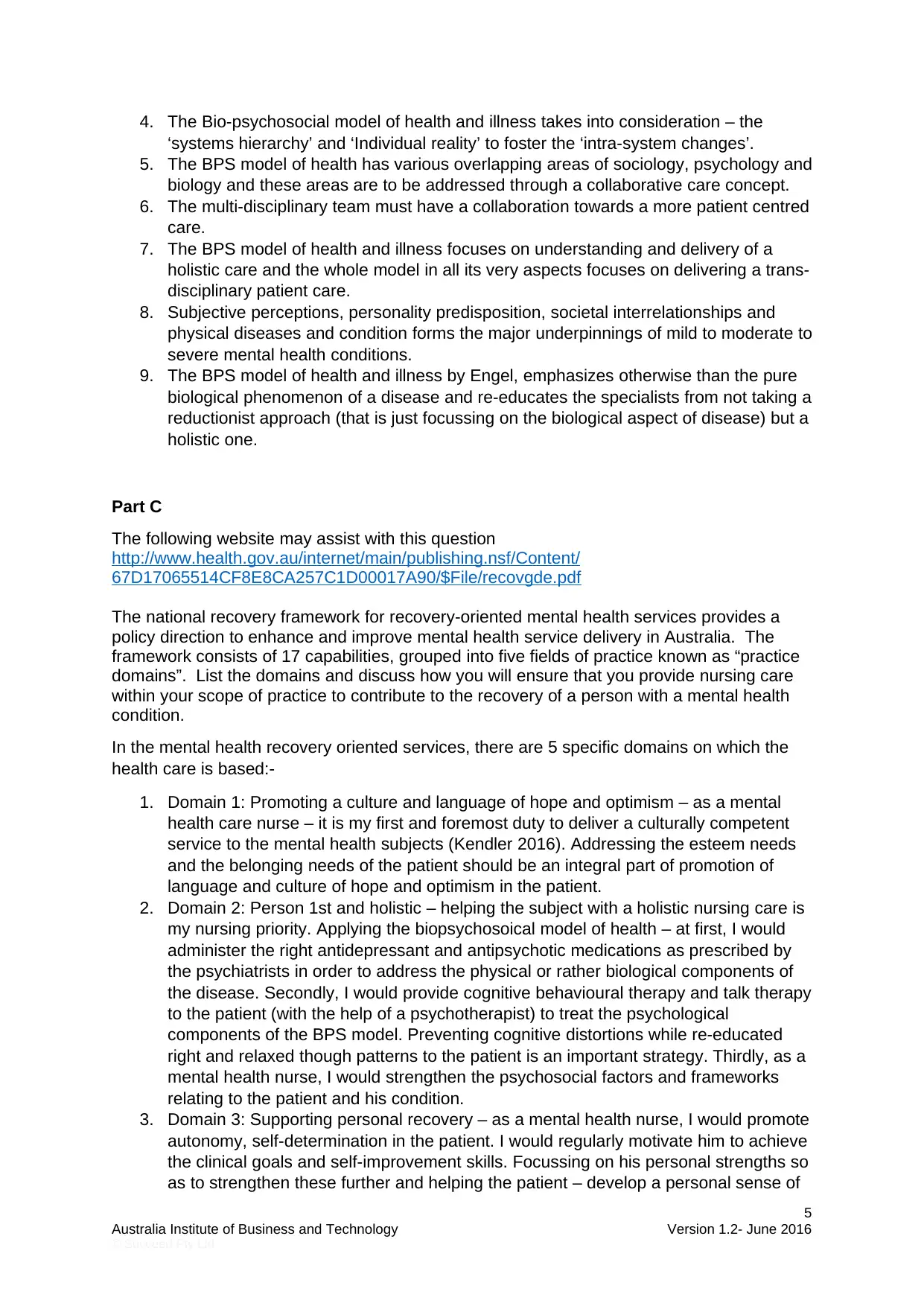
4. The Bio-psychosocial model of health and illness takes into consideration – the
‘systems hierarchy’ and ‘Individual reality’ to foster the ‘intra-system changes’.
5. The BPS model of health has various overlapping areas of sociology, psychology and
biology and these areas are to be addressed through a collaborative care concept.
6. The multi-disciplinary team must have a collaboration towards a more patient centred
care.
7. The BPS model of health and illness focuses on understanding and delivery of a
holistic care and the whole model in all its very aspects focuses on delivering a trans-
disciplinary patient care.
8. Subjective perceptions, personality predisposition, societal interrelationships and
physical diseases and condition forms the major underpinnings of mild to moderate to
severe mental health conditions.
9. The BPS model of health and illness by Engel, emphasizes otherwise than the pure
biological phenomenon of a disease and re-educates the specialists from not taking a
reductionist approach (that is just focussing on the biological aspect of disease) but a
holistic one.
Part C
The following website may assist with this question
http://www.health.gov.au/internet/main/publishing.nsf/Content/
67D17065514CF8E8CA257C1D00017A90/$File/recovgde.pdf
The national recovery framework for recovery-oriented mental health services provides a
policy direction to enhance and improve mental health service delivery in Australia. The
framework consists of 17 capabilities, grouped into five fields of practice known as “practice
domains”. List the domains and discuss how you will ensure that you provide nursing care
within your scope of practice to contribute to the recovery of a person with a mental health
condition.
In the mental health recovery oriented services, there are 5 specific domains on which the
health care is based:-
1. Domain 1: Promoting a culture and language of hope and optimism – as a mental
health care nurse – it is my first and foremost duty to deliver a culturally competent
service to the mental health subjects (Kendler 2016). Addressing the esteem needs
and the belonging needs of the patient should be an integral part of promotion of
language and culture of hope and optimism in the patient.
2. Domain 2: Person 1st and holistic – helping the subject with a holistic nursing care is
my nursing priority. Applying the biopsychosoical model of health – at first, I would
administer the right antidepressant and antipsychotic medications as prescribed by
the psychiatrists in order to address the physical or rather biological components of
the disease. Secondly, I would provide cognitive behavioural therapy and talk therapy
to the patient (with the help of a psychotherapist) to treat the psychological
components of the BPS model. Preventing cognitive distortions while re-educated
right and relaxed though patterns to the patient is an important strategy. Thirdly, as a
mental health nurse, I would strengthen the psychosocial factors and frameworks
relating to the patient and his condition.
3. Domain 3: Supporting personal recovery – as a mental health nurse, I would promote
autonomy, self-determination in the patient. I would regularly motivate him to achieve
the clinical goals and self-improvement skills. Focussing on his personal strengths so
as to strengthen these further and helping the patient – develop a personal sense of
5
Australia Institute of Business and Technology Version 1.2- June 2016
© Succeed Pty Ltd
‘systems hierarchy’ and ‘Individual reality’ to foster the ‘intra-system changes’.
5. The BPS model of health has various overlapping areas of sociology, psychology and
biology and these areas are to be addressed through a collaborative care concept.
6. The multi-disciplinary team must have a collaboration towards a more patient centred
care.
7. The BPS model of health and illness focuses on understanding and delivery of a
holistic care and the whole model in all its very aspects focuses on delivering a trans-
disciplinary patient care.
8. Subjective perceptions, personality predisposition, societal interrelationships and
physical diseases and condition forms the major underpinnings of mild to moderate to
severe mental health conditions.
9. The BPS model of health and illness by Engel, emphasizes otherwise than the pure
biological phenomenon of a disease and re-educates the specialists from not taking a
reductionist approach (that is just focussing on the biological aspect of disease) but a
holistic one.
Part C
The following website may assist with this question
http://www.health.gov.au/internet/main/publishing.nsf/Content/
67D17065514CF8E8CA257C1D00017A90/$File/recovgde.pdf
The national recovery framework for recovery-oriented mental health services provides a
policy direction to enhance and improve mental health service delivery in Australia. The
framework consists of 17 capabilities, grouped into five fields of practice known as “practice
domains”. List the domains and discuss how you will ensure that you provide nursing care
within your scope of practice to contribute to the recovery of a person with a mental health
condition.
In the mental health recovery oriented services, there are 5 specific domains on which the
health care is based:-
1. Domain 1: Promoting a culture and language of hope and optimism – as a mental
health care nurse – it is my first and foremost duty to deliver a culturally competent
service to the mental health subjects (Kendler 2016). Addressing the esteem needs
and the belonging needs of the patient should be an integral part of promotion of
language and culture of hope and optimism in the patient.
2. Domain 2: Person 1st and holistic – helping the subject with a holistic nursing care is
my nursing priority. Applying the biopsychosoical model of health – at first, I would
administer the right antidepressant and antipsychotic medications as prescribed by
the psychiatrists in order to address the physical or rather biological components of
the disease. Secondly, I would provide cognitive behavioural therapy and talk therapy
to the patient (with the help of a psychotherapist) to treat the psychological
components of the BPS model. Preventing cognitive distortions while re-educated
right and relaxed though patterns to the patient is an important strategy. Thirdly, as a
mental health nurse, I would strengthen the psychosocial factors and frameworks
relating to the patient and his condition.
3. Domain 3: Supporting personal recovery – as a mental health nurse, I would promote
autonomy, self-determination in the patient. I would regularly motivate him to achieve
the clinical goals and self-improvement skills. Focussing on his personal strengths so
as to strengthen these further and helping the patient – develop a personal sense of
5
Australia Institute of Business and Technology Version 1.2- June 2016
© Succeed Pty Ltd
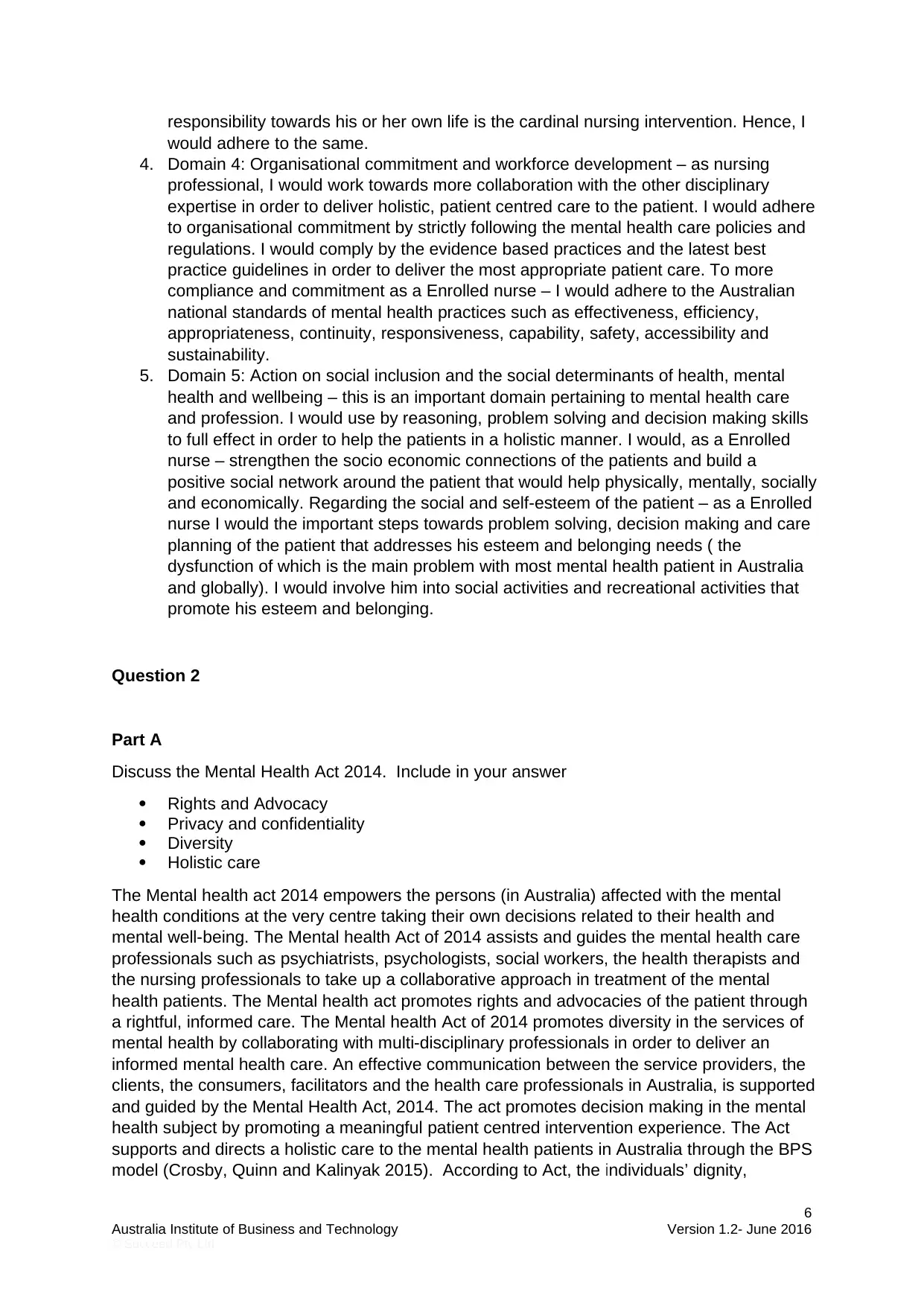
responsibility towards his or her own life is the cardinal nursing intervention. Hence, I
would adhere to the same.
4. Domain 4: Organisational commitment and workforce development – as nursing
professional, I would work towards more collaboration with the other disciplinary
expertise in order to deliver holistic, patient centred care to the patient. I would adhere
to organisational commitment by strictly following the mental health care policies and
regulations. I would comply by the evidence based practices and the latest best
practice guidelines in order to deliver the most appropriate patient care. To more
compliance and commitment as a Enrolled nurse – I would adhere to the Australian
national standards of mental health practices such as effectiveness, efficiency,
appropriateness, continuity, responsiveness, capability, safety, accessibility and
sustainability.
5. Domain 5: Action on social inclusion and the social determinants of health, mental
health and wellbeing – this is an important domain pertaining to mental health care
and profession. I would use by reasoning, problem solving and decision making skills
to full effect in order to help the patients in a holistic manner. I would, as a Enrolled
nurse – strengthen the socio economic connections of the patients and build a
positive social network around the patient that would help physically, mentally, socially
and economically. Regarding the social and self-esteem of the patient – as a Enrolled
nurse I would the important steps towards problem solving, decision making and care
planning of the patient that addresses his esteem and belonging needs ( the
dysfunction of which is the main problem with most mental health patient in Australia
and globally). I would involve him into social activities and recreational activities that
promote his esteem and belonging.
Question 2
Part A
Discuss the Mental Health Act 2014. Include in your answer
Rights and Advocacy
Privacy and confidentiality
Diversity
Holistic care
The Mental health act 2014 empowers the persons (in Australia) affected with the mental
health conditions at the very centre taking their own decisions related to their health and
mental well-being. The Mental health Act of 2014 assists and guides the mental health care
professionals such as psychiatrists, psychologists, social workers, the health therapists and
the nursing professionals to take up a collaborative approach in treatment of the mental
health patients. The Mental health act promotes rights and advocacies of the patient through
a rightful, informed care. The Mental health Act of 2014 promotes diversity in the services of
mental health by collaborating with multi-disciplinary professionals in order to deliver an
informed mental health care. An effective communication between the service providers, the
clients, the consumers, facilitators and the health care professionals in Australia, is supported
and guided by the Mental Health Act, 2014. The act promotes decision making in the mental
health subject by promoting a meaningful patient centred intervention experience. The Act
supports and directs a holistic care to the mental health patients in Australia through the BPS
model (Crosby, Quinn and Kalinyak 2015). According to Act, the individuals’ dignity,
6
Australia Institute of Business and Technology Version 1.2- June 2016
© Succeed Pty Ltd
would adhere to the same.
4. Domain 4: Organisational commitment and workforce development – as nursing
professional, I would work towards more collaboration with the other disciplinary
expertise in order to deliver holistic, patient centred care to the patient. I would adhere
to organisational commitment by strictly following the mental health care policies and
regulations. I would comply by the evidence based practices and the latest best
practice guidelines in order to deliver the most appropriate patient care. To more
compliance and commitment as a Enrolled nurse – I would adhere to the Australian
national standards of mental health practices such as effectiveness, efficiency,
appropriateness, continuity, responsiveness, capability, safety, accessibility and
sustainability.
5. Domain 5: Action on social inclusion and the social determinants of health, mental
health and wellbeing – this is an important domain pertaining to mental health care
and profession. I would use by reasoning, problem solving and decision making skills
to full effect in order to help the patients in a holistic manner. I would, as a Enrolled
nurse – strengthen the socio economic connections of the patients and build a
positive social network around the patient that would help physically, mentally, socially
and economically. Regarding the social and self-esteem of the patient – as a Enrolled
nurse I would the important steps towards problem solving, decision making and care
planning of the patient that addresses his esteem and belonging needs ( the
dysfunction of which is the main problem with most mental health patient in Australia
and globally). I would involve him into social activities and recreational activities that
promote his esteem and belonging.
Question 2
Part A
Discuss the Mental Health Act 2014. Include in your answer
Rights and Advocacy
Privacy and confidentiality
Diversity
Holistic care
The Mental health act 2014 empowers the persons (in Australia) affected with the mental
health conditions at the very centre taking their own decisions related to their health and
mental well-being. The Mental health Act of 2014 assists and guides the mental health care
professionals such as psychiatrists, psychologists, social workers, the health therapists and
the nursing professionals to take up a collaborative approach in treatment of the mental
health patients. The Mental health act promotes rights and advocacies of the patient through
a rightful, informed care. The Mental health Act of 2014 promotes diversity in the services of
mental health by collaborating with multi-disciplinary professionals in order to deliver an
informed mental health care. An effective communication between the service providers, the
clients, the consumers, facilitators and the health care professionals in Australia, is supported
and guided by the Mental Health Act, 2014. The act promotes decision making in the mental
health subject by promoting a meaningful patient centred intervention experience. The Act
supports and directs a holistic care to the mental health patients in Australia through the BPS
model (Crosby, Quinn and Kalinyak 2015). According to Act, the individuals’ dignity,
6
Australia Institute of Business and Technology Version 1.2- June 2016
© Succeed Pty Ltd
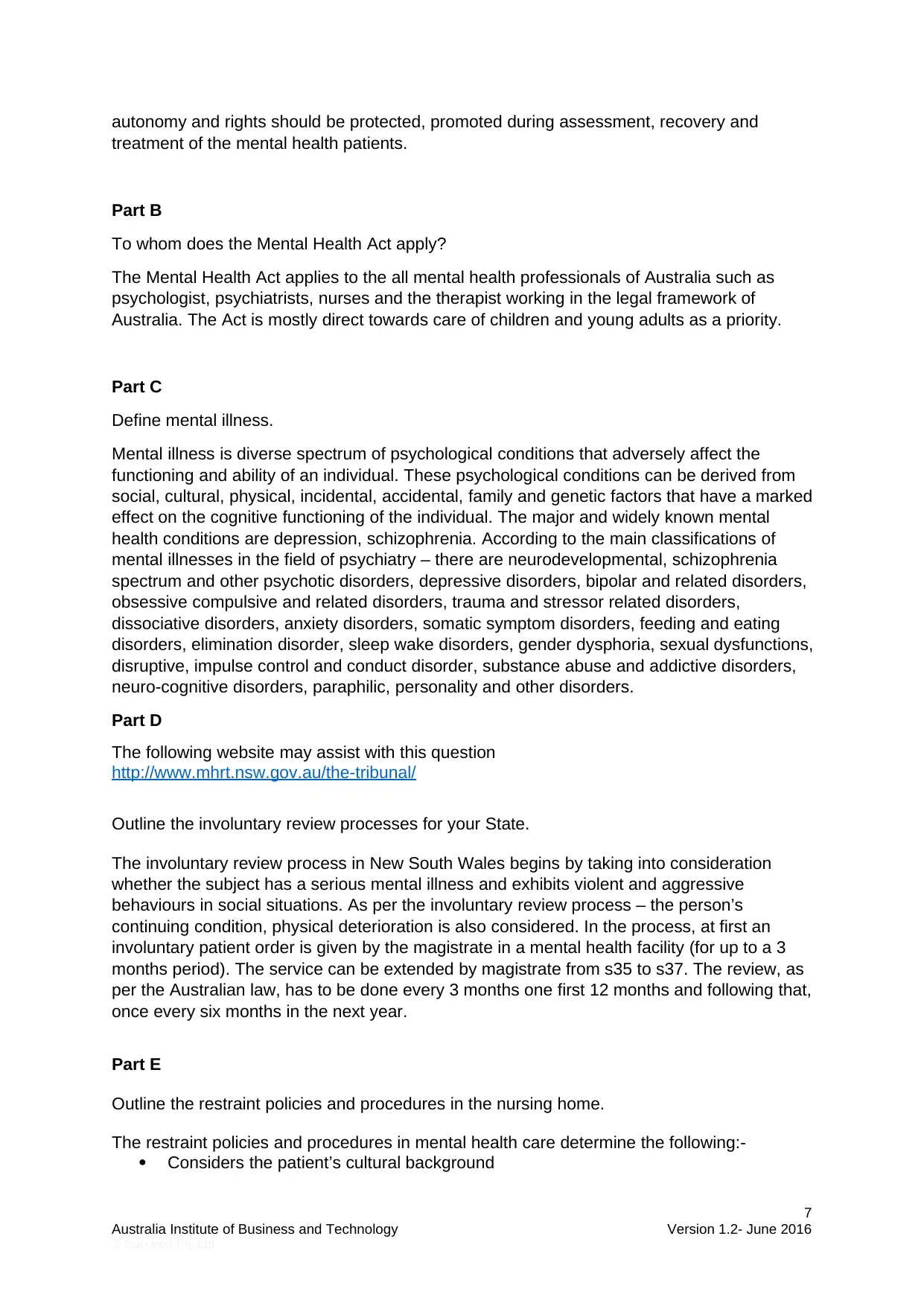
autonomy and rights should be protected, promoted during assessment, recovery and
treatment of the mental health patients.
Part B
To whom does the Mental Health Act apply?
The Mental Health Act applies to the all mental health professionals of Australia such as
psychologist, psychiatrists, nurses and the therapist working in the legal framework of
Australia. The Act is mostly direct towards care of children and young adults as a priority.
Part C
Define mental illness.
Mental illness is diverse spectrum of psychological conditions that adversely affect the
functioning and ability of an individual. These psychological conditions can be derived from
social, cultural, physical, incidental, accidental, family and genetic factors that have a marked
effect on the cognitive functioning of the individual. The major and widely known mental
health conditions are depression, schizophrenia. According to the main classifications of
mental illnesses in the field of psychiatry – there are neurodevelopmental, schizophrenia
spectrum and other psychotic disorders, depressive disorders, bipolar and related disorders,
obsessive compulsive and related disorders, trauma and stressor related disorders,
dissociative disorders, anxiety disorders, somatic symptom disorders, feeding and eating
disorders, elimination disorder, sleep wake disorders, gender dysphoria, sexual dysfunctions,
disruptive, impulse control and conduct disorder, substance abuse and addictive disorders,
neuro-cognitive disorders, paraphilic, personality and other disorders.
Part D
The following website may assist with this question
http://www.mhrt.nsw.gov.au/the-tribunal/
Outline the involuntary review processes for your State.
The involuntary review process in New South Wales begins by taking into consideration
whether the subject has a serious mental illness and exhibits violent and aggressive
behaviours in social situations. As per the involuntary review process – the person’s
continuing condition, physical deterioration is also considered. In the process, at first an
involuntary patient order is given by the magistrate in a mental health facility (for up to a 3
months period). The service can be extended by magistrate from s35 to s37. The review, as
per the Australian law, has to be done every 3 months one first 12 months and following that,
once every six months in the next year.
Part E
Outline the restraint policies and procedures in the nursing home.
The restraint policies and procedures in mental health care determine the following:-
Considers the patient’s cultural background
7
Australia Institute of Business and Technology Version 1.2- June 2016
© Succeed Pty Ltd
treatment of the mental health patients.
Part B
To whom does the Mental Health Act apply?
The Mental Health Act applies to the all mental health professionals of Australia such as
psychologist, psychiatrists, nurses and the therapist working in the legal framework of
Australia. The Act is mostly direct towards care of children and young adults as a priority.
Part C
Define mental illness.
Mental illness is diverse spectrum of psychological conditions that adversely affect the
functioning and ability of an individual. These psychological conditions can be derived from
social, cultural, physical, incidental, accidental, family and genetic factors that have a marked
effect on the cognitive functioning of the individual. The major and widely known mental
health conditions are depression, schizophrenia. According to the main classifications of
mental illnesses in the field of psychiatry – there are neurodevelopmental, schizophrenia
spectrum and other psychotic disorders, depressive disorders, bipolar and related disorders,
obsessive compulsive and related disorders, trauma and stressor related disorders,
dissociative disorders, anxiety disorders, somatic symptom disorders, feeding and eating
disorders, elimination disorder, sleep wake disorders, gender dysphoria, sexual dysfunctions,
disruptive, impulse control and conduct disorder, substance abuse and addictive disorders,
neuro-cognitive disorders, paraphilic, personality and other disorders.
Part D
The following website may assist with this question
http://www.mhrt.nsw.gov.au/the-tribunal/
Outline the involuntary review processes for your State.
The involuntary review process in New South Wales begins by taking into consideration
whether the subject has a serious mental illness and exhibits violent and aggressive
behaviours in social situations. As per the involuntary review process – the person’s
continuing condition, physical deterioration is also considered. In the process, at first an
involuntary patient order is given by the magistrate in a mental health facility (for up to a 3
months period). The service can be extended by magistrate from s35 to s37. The review, as
per the Australian law, has to be done every 3 months one first 12 months and following that,
once every six months in the next year.
Part E
Outline the restraint policies and procedures in the nursing home.
The restraint policies and procedures in mental health care determine the following:-
Considers the patient’s cultural background
7
Australia Institute of Business and Technology Version 1.2- June 2016
© Succeed Pty Ltd
Paraphrase This Document
Need a fresh take? Get an instant paraphrase of this document with our AI Paraphraser
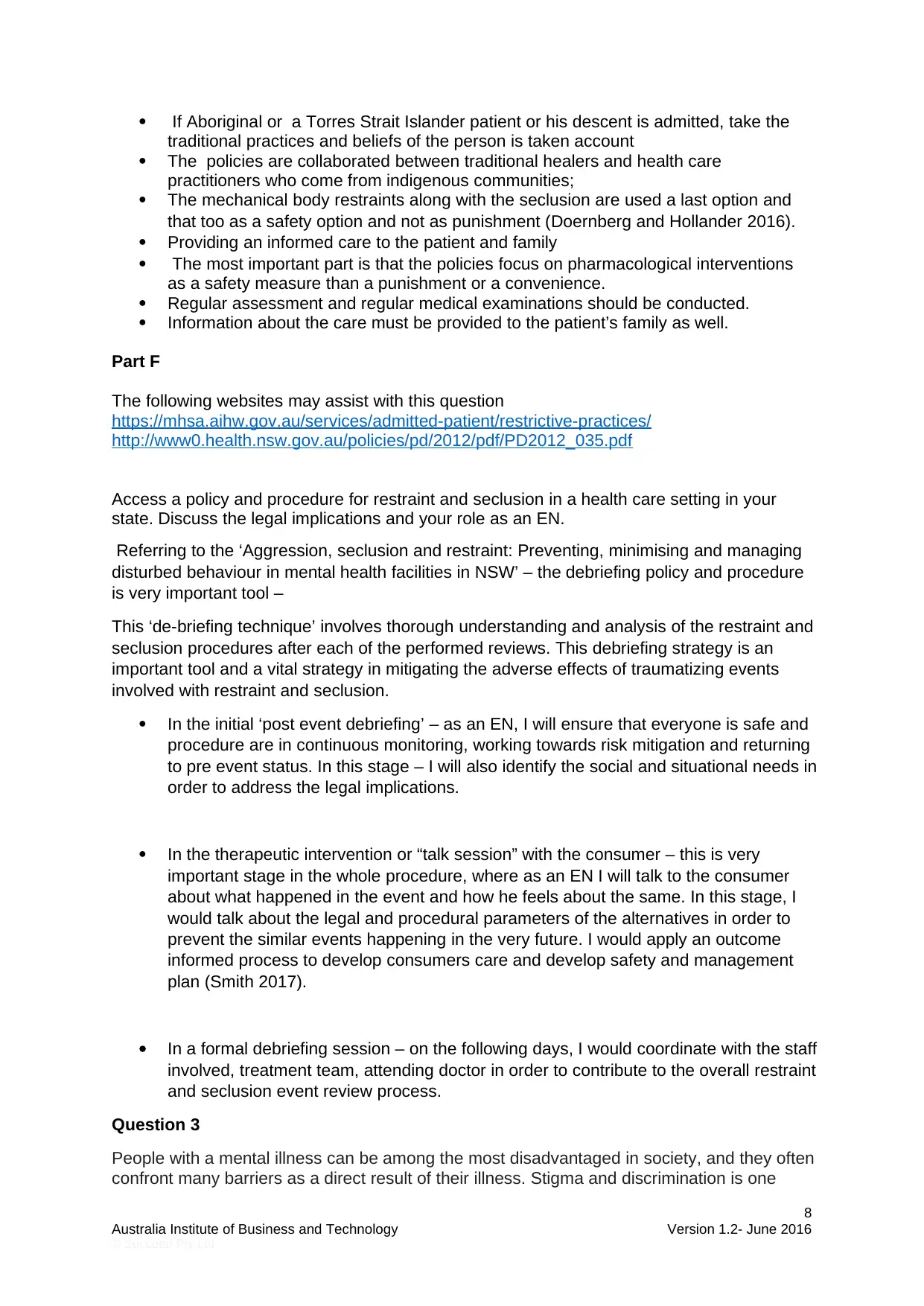
If Aboriginal or a Torres Strait Islander patient or his descent is admitted, take the
traditional practices and beliefs of the person is taken account
The policies are collaborated between traditional healers and health care
practitioners who come from indigenous communities;
The mechanical body restraints along with the seclusion are used a last option and
that too as a safety option and not as punishment (Doernberg and Hollander 2016).
Providing an informed care to the patient and family
The most important part is that the policies focus on pharmacological interventions
as a safety measure than a punishment or a convenience.
Regular assessment and regular medical examinations should be conducted.
Information about the care must be provided to the patient’s family as well.
Part F
The following websites may assist with this question
https://mhsa.aihw.gov.au/services/admitted-patient/restrictive-practices/
http://www0.health.nsw.gov.au/policies/pd/2012/pdf/PD2012_035.pdf
Access a policy and procedure for restraint and seclusion in a health care setting in your
state. Discuss the legal implications and your role as an EN.
Referring to the ‘Aggression, seclusion and restraint: Preventing, minimising and managing
disturbed behaviour in mental health facilities in NSW’ – the debriefing policy and procedure
is very important tool –
This ‘de-briefing technique’ involves thorough understanding and analysis of the restraint and
seclusion procedures after each of the performed reviews. This debriefing strategy is an
important tool and a vital strategy in mitigating the adverse effects of traumatizing events
involved with restraint and seclusion.
In the initial ‘post event debriefing’ – as an EN, I will ensure that everyone is safe and
procedure are in continuous monitoring, working towards risk mitigation and returning
to pre event status. In this stage – I will also identify the social and situational needs in
order to address the legal implications.
In the therapeutic intervention or “talk session” with the consumer – this is very
important stage in the whole procedure, where as an EN I will talk to the consumer
about what happened in the event and how he feels about the same. In this stage, I
would talk about the legal and procedural parameters of the alternatives in order to
prevent the similar events happening in the very future. I would apply an outcome
informed process to develop consumers care and develop safety and management
plan (Smith 2017).
In a formal debriefing session – on the following days, I would coordinate with the staff
involved, treatment team, attending doctor in order to contribute to the overall restraint
and seclusion event review process.
Question 3
People with a mental illness can be among the most disadvantaged in society, and they often
confront many barriers as a direct result of their illness. Stigma and discrimination is one
8
Australia Institute of Business and Technology Version 1.2- June 2016
© Succeed Pty Ltd
traditional practices and beliefs of the person is taken account
The policies are collaborated between traditional healers and health care
practitioners who come from indigenous communities;
The mechanical body restraints along with the seclusion are used a last option and
that too as a safety option and not as punishment (Doernberg and Hollander 2016).
Providing an informed care to the patient and family
The most important part is that the policies focus on pharmacological interventions
as a safety measure than a punishment or a convenience.
Regular assessment and regular medical examinations should be conducted.
Information about the care must be provided to the patient’s family as well.
Part F
The following websites may assist with this question
https://mhsa.aihw.gov.au/services/admitted-patient/restrictive-practices/
http://www0.health.nsw.gov.au/policies/pd/2012/pdf/PD2012_035.pdf
Access a policy and procedure for restraint and seclusion in a health care setting in your
state. Discuss the legal implications and your role as an EN.
Referring to the ‘Aggression, seclusion and restraint: Preventing, minimising and managing
disturbed behaviour in mental health facilities in NSW’ – the debriefing policy and procedure
is very important tool –
This ‘de-briefing technique’ involves thorough understanding and analysis of the restraint and
seclusion procedures after each of the performed reviews. This debriefing strategy is an
important tool and a vital strategy in mitigating the adverse effects of traumatizing events
involved with restraint and seclusion.
In the initial ‘post event debriefing’ – as an EN, I will ensure that everyone is safe and
procedure are in continuous monitoring, working towards risk mitigation and returning
to pre event status. In this stage – I will also identify the social and situational needs in
order to address the legal implications.
In the therapeutic intervention or “talk session” with the consumer – this is very
important stage in the whole procedure, where as an EN I will talk to the consumer
about what happened in the event and how he feels about the same. In this stage, I
would talk about the legal and procedural parameters of the alternatives in order to
prevent the similar events happening in the very future. I would apply an outcome
informed process to develop consumers care and develop safety and management
plan (Smith 2017).
In a formal debriefing session – on the following days, I would coordinate with the staff
involved, treatment team, attending doctor in order to contribute to the overall restraint
and seclusion event review process.
Question 3
People with a mental illness can be among the most disadvantaged in society, and they often
confront many barriers as a direct result of their illness. Stigma and discrimination is one
8
Australia Institute of Business and Technology Version 1.2- June 2016
© Succeed Pty Ltd
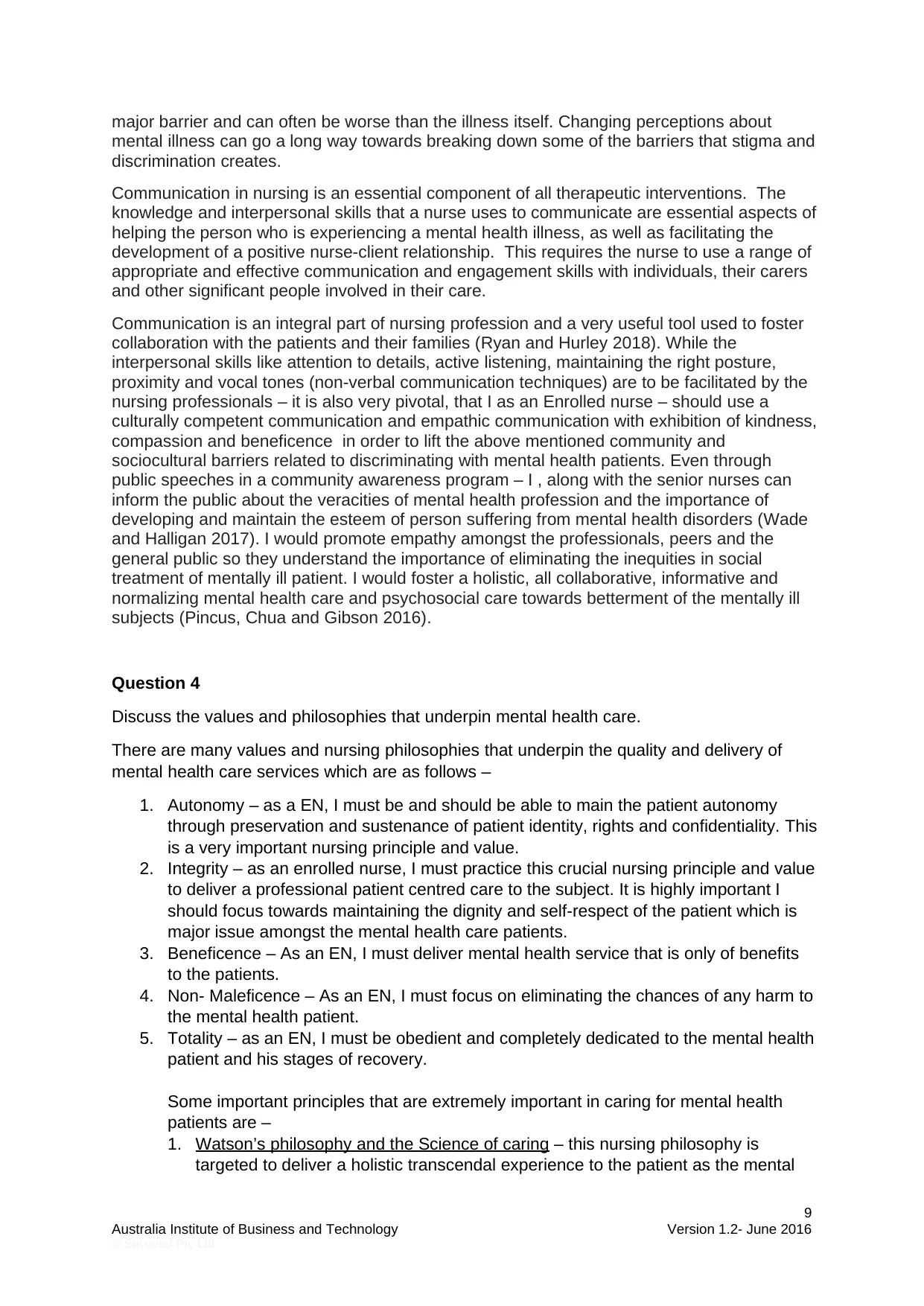
major barrier and can often be worse than the illness itself. Changing perceptions about
mental illness can go a long way towards breaking down some of the barriers that stigma and
discrimination creates.
Communication in nursing is an essential component of all therapeutic interventions. The
knowledge and interpersonal skills that a nurse uses to communicate are essential aspects of
helping the person who is experiencing a mental health illness, as well as facilitating the
development of a positive nurse-client relationship. This requires the nurse to use a range of
appropriate and effective communication and engagement skills with individuals, their carers
and other significant people involved in their care.
Communication is an integral part of nursing profession and a very useful tool used to foster
collaboration with the patients and their families (Ryan and Hurley 2018). While the
interpersonal skills like attention to details, active listening, maintaining the right posture,
proximity and vocal tones (non-verbal communication techniques) are to be facilitated by the
nursing professionals – it is also very pivotal, that I as an Enrolled nurse – should use a
culturally competent communication and empathic communication with exhibition of kindness,
compassion and beneficence in order to lift the above mentioned community and
sociocultural barriers related to discriminating with mental health patients. Even through
public speeches in a community awareness program – I , along with the senior nurses can
inform the public about the veracities of mental health profession and the importance of
developing and maintain the esteem of person suffering from mental health disorders (Wade
and Halligan 2017). I would promote empathy amongst the professionals, peers and the
general public so they understand the importance of eliminating the inequities in social
treatment of mentally ill patient. I would foster a holistic, all collaborative, informative and
normalizing mental health care and psychosocial care towards betterment of the mentally ill
subjects (Pincus, Chua and Gibson 2016).
Question 4
Discuss the values and philosophies that underpin mental health care.
There are many values and nursing philosophies that underpin the quality and delivery of
mental health care services which are as follows –
1. Autonomy – as a EN, I must be and should be able to main the patient autonomy
through preservation and sustenance of patient identity, rights and confidentiality. This
is a very important nursing principle and value.
2. Integrity – as an enrolled nurse, I must practice this crucial nursing principle and value
to deliver a professional patient centred care to the subject. It is highly important I
should focus towards maintaining the dignity and self-respect of the patient which is
major issue amongst the mental health care patients.
3. Beneficence – As an EN, I must deliver mental health service that is only of benefits
to the patients.
4. Non- Maleficence – As an EN, I must focus on eliminating the chances of any harm to
the mental health patient.
5. Totality – as an EN, I must be obedient and completely dedicated to the mental health
patient and his stages of recovery.
Some important principles that are extremely important in caring for mental health
patients are –
1. Watson’s philosophy and the Science of caring – this nursing philosophy is
targeted to deliver a holistic transcendal experience to the patient as the mental
9
Australia Institute of Business and Technology Version 1.2- June 2016
© Succeed Pty Ltd
mental illness can go a long way towards breaking down some of the barriers that stigma and
discrimination creates.
Communication in nursing is an essential component of all therapeutic interventions. The
knowledge and interpersonal skills that a nurse uses to communicate are essential aspects of
helping the person who is experiencing a mental health illness, as well as facilitating the
development of a positive nurse-client relationship. This requires the nurse to use a range of
appropriate and effective communication and engagement skills with individuals, their carers
and other significant people involved in their care.
Communication is an integral part of nursing profession and a very useful tool used to foster
collaboration with the patients and their families (Ryan and Hurley 2018). While the
interpersonal skills like attention to details, active listening, maintaining the right posture,
proximity and vocal tones (non-verbal communication techniques) are to be facilitated by the
nursing professionals – it is also very pivotal, that I as an Enrolled nurse – should use a
culturally competent communication and empathic communication with exhibition of kindness,
compassion and beneficence in order to lift the above mentioned community and
sociocultural barriers related to discriminating with mental health patients. Even through
public speeches in a community awareness program – I , along with the senior nurses can
inform the public about the veracities of mental health profession and the importance of
developing and maintain the esteem of person suffering from mental health disorders (Wade
and Halligan 2017). I would promote empathy amongst the professionals, peers and the
general public so they understand the importance of eliminating the inequities in social
treatment of mentally ill patient. I would foster a holistic, all collaborative, informative and
normalizing mental health care and psychosocial care towards betterment of the mentally ill
subjects (Pincus, Chua and Gibson 2016).
Question 4
Discuss the values and philosophies that underpin mental health care.
There are many values and nursing philosophies that underpin the quality and delivery of
mental health care services which are as follows –
1. Autonomy – as a EN, I must be and should be able to main the patient autonomy
through preservation and sustenance of patient identity, rights and confidentiality. This
is a very important nursing principle and value.
2. Integrity – as an enrolled nurse, I must practice this crucial nursing principle and value
to deliver a professional patient centred care to the subject. It is highly important I
should focus towards maintaining the dignity and self-respect of the patient which is
major issue amongst the mental health care patients.
3. Beneficence – As an EN, I must deliver mental health service that is only of benefits
to the patients.
4. Non- Maleficence – As an EN, I must focus on eliminating the chances of any harm to
the mental health patient.
5. Totality – as an EN, I must be obedient and completely dedicated to the mental health
patient and his stages of recovery.
Some important principles that are extremely important in caring for mental health
patients are –
1. Watson’s philosophy and the Science of caring – this nursing philosophy is
targeted to deliver a holistic transcendal experience to the patient as the mental
9
Australia Institute of Business and Technology Version 1.2- June 2016
© Succeed Pty Ltd

health nurses delivers a spiritual ‘holistic mind, body and spirit experience to the
patient’. The nursing is patient centred and individualistic and focuses creating a
higher degree of harmony with the mental health patient so that he can work
actively with the nurses towards his own recovery (Alligood 2017).
2. Human becoming nursing – is quite a new philosophy in nursing that emphasizes
on the humanistic nursing perspective. It is extremely cardinal for the mental
health nurses to experience the pain and internal emotions of the patient,
empathically and become human with the patient treatment process, thus
bettering the quality of mental health care on each day.
Question 5
The following website may assist with this question
http://www.health.nsw.gov.au/mhdao/Pages/legislation.aspx
Discuss the rights of the person with a mental health condition
The rights of the person with a mental health condition are very important and are as follows:-
1. Right to privacy - the patient must be given the right to have privacy which is
important for his esteem needs.
2. Right to information – the mental health patient must be informed with the kind of care
that is provided (Bech 2016).
3. Right to voluntary participation and decision making – after being informed – the
patient should be given the opportunity to decide whether or not to go for the
treatment decided for him.
4. Right to autonomy and confidentiality – is also very vital.
5. Right to dignity and respect is critical to the patient’s perception of the service and
self-motivation towards health development and betterment.
Question 6
Case study
Summary
Mrs Julie Davis, a 43 year old teacher, has come to hospital by ambulance complaining of
severe pains in the chest. She is very worried and agitated and is visibly shaking, crying and
reporting an extreme fear of dying. She stated that this fear just ‘pops out’. She stated that
this is the third time this has happened in the last three months.
- Mrs Davis is a 43 year old woman of average height and average build.
- Mrs Davis has come to the hospital’s emergency department fearful that she may be
having a heart attack. She came by ambulance because she thought she was dying.
Her heart has been checked and it is fine so she has been referred to you to for a brief
psychiatric evaluation. You are the intake / triage nurse.
10
Australia Institute of Business and Technology Version 1.2- June 2016
© Succeed Pty Ltd
patient’. The nursing is patient centred and individualistic and focuses creating a
higher degree of harmony with the mental health patient so that he can work
actively with the nurses towards his own recovery (Alligood 2017).
2. Human becoming nursing – is quite a new philosophy in nursing that emphasizes
on the humanistic nursing perspective. It is extremely cardinal for the mental
health nurses to experience the pain and internal emotions of the patient,
empathically and become human with the patient treatment process, thus
bettering the quality of mental health care on each day.
Question 5
The following website may assist with this question
http://www.health.nsw.gov.au/mhdao/Pages/legislation.aspx
Discuss the rights of the person with a mental health condition
The rights of the person with a mental health condition are very important and are as follows:-
1. Right to privacy - the patient must be given the right to have privacy which is
important for his esteem needs.
2. Right to information – the mental health patient must be informed with the kind of care
that is provided (Bech 2016).
3. Right to voluntary participation and decision making – after being informed – the
patient should be given the opportunity to decide whether or not to go for the
treatment decided for him.
4. Right to autonomy and confidentiality – is also very vital.
5. Right to dignity and respect is critical to the patient’s perception of the service and
self-motivation towards health development and betterment.
Question 6
Case study
Summary
Mrs Julie Davis, a 43 year old teacher, has come to hospital by ambulance complaining of
severe pains in the chest. She is very worried and agitated and is visibly shaking, crying and
reporting an extreme fear of dying. She stated that this fear just ‘pops out’. She stated that
this is the third time this has happened in the last three months.
- Mrs Davis is a 43 year old woman of average height and average build.
- Mrs Davis has come to the hospital’s emergency department fearful that she may be
having a heart attack. She came by ambulance because she thought she was dying.
Her heart has been checked and it is fine so she has been referred to you to for a brief
psychiatric evaluation. You are the intake / triage nurse.
10
Australia Institute of Business and Technology Version 1.2- June 2016
© Succeed Pty Ltd
Secure Best Marks with AI Grader
Need help grading? Try our AI Grader for instant feedback on your assignments.
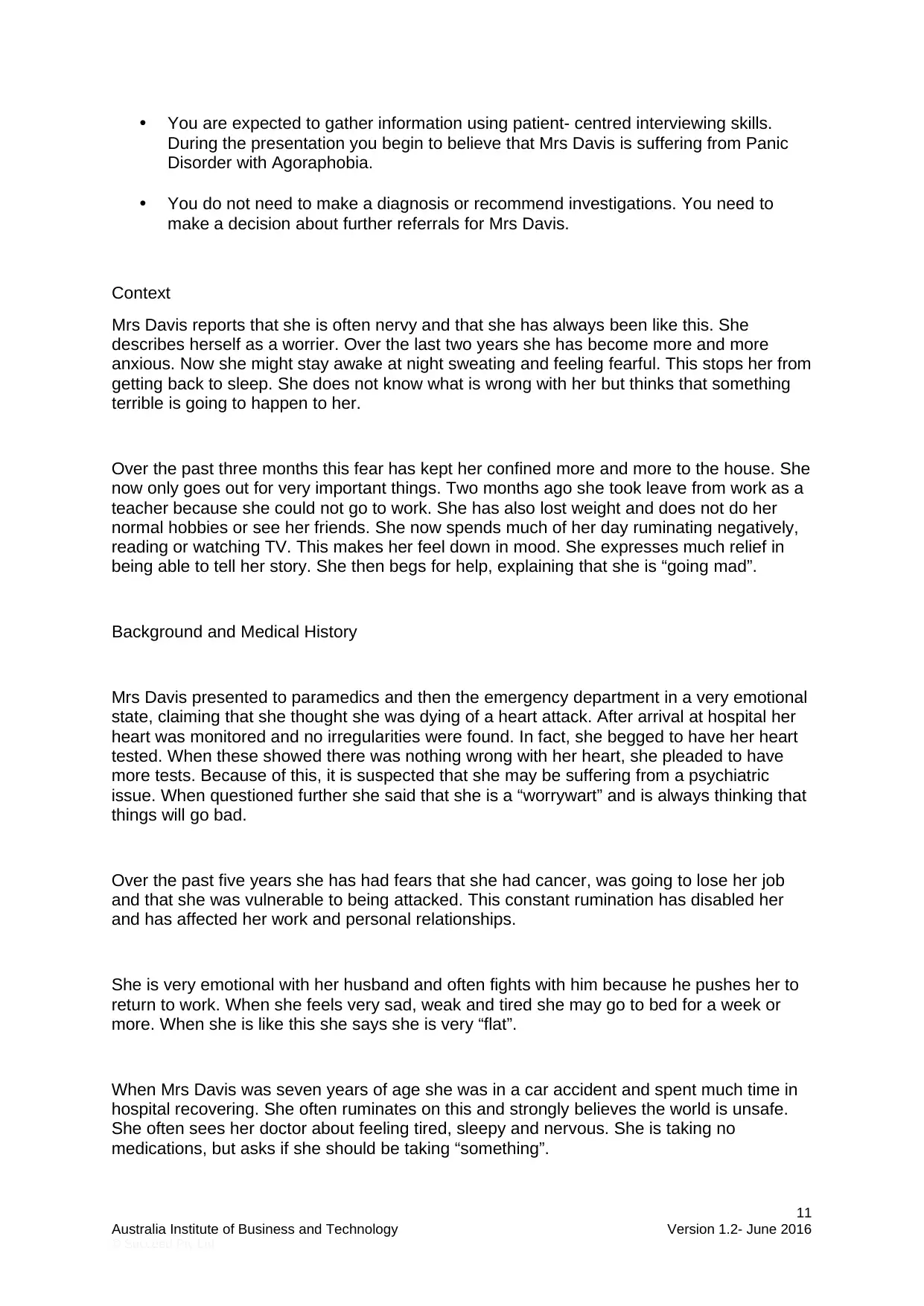
• You are expected to gather information using patient- centred interviewing skills.
During the presentation you begin to believe that Mrs Davis is suffering from Panic
Disorder with Agoraphobia.
• You do not need to make a diagnosis or recommend investigations. You need to
make a decision about further referrals for Mrs Davis.
Context
Mrs Davis reports that she is often nervy and that she has always been like this. She
describes herself as a worrier. Over the last two years she has become more and more
anxious. Now she might stay awake at night sweating and feeling fearful. This stops her from
getting back to sleep. She does not know what is wrong with her but thinks that something
terrible is going to happen to her.
Over the past three months this fear has kept her confined more and more to the house. She
now only goes out for very important things. Two months ago she took leave from work as a
teacher because she could not go to work. She has also lost weight and does not do her
normal hobbies or see her friends. She now spends much of her day ruminating negatively,
reading or watching TV. This makes her feel down in mood. She expresses much relief in
being able to tell her story. She then begs for help, explaining that she is “going mad”.
Background and Medical History
Mrs Davis presented to paramedics and then the emergency department in a very emotional
state, claiming that she thought she was dying of a heart attack. After arrival at hospital her
heart was monitored and no irregularities were found. In fact, she begged to have her heart
tested. When these showed there was nothing wrong with her heart, she pleaded to have
more tests. Because of this, it is suspected that she may be suffering from a psychiatric
issue. When questioned further she said that she is a “worrywart” and is always thinking that
things will go bad.
Over the past five years she has had fears that she had cancer, was going to lose her job
and that she was vulnerable to being attacked. This constant rumination has disabled her
and has affected her work and personal relationships.
She is very emotional with her husband and often fights with him because he pushes her to
return to work. When she feels very sad, weak and tired she may go to bed for a week or
more. When she is like this she says she is very “flat”.
When Mrs Davis was seven years of age she was in a car accident and spent much time in
hospital recovering. She often ruminates on this and strongly believes the world is unsafe.
She often sees her doctor about feeling tired, sleepy and nervous. She is taking no
medications, but asks if she should be taking “something”.
11
Australia Institute of Business and Technology Version 1.2- June 2016
© Succeed Pty Ltd
During the presentation you begin to believe that Mrs Davis is suffering from Panic
Disorder with Agoraphobia.
• You do not need to make a diagnosis or recommend investigations. You need to
make a decision about further referrals for Mrs Davis.
Context
Mrs Davis reports that she is often nervy and that she has always been like this. She
describes herself as a worrier. Over the last two years she has become more and more
anxious. Now she might stay awake at night sweating and feeling fearful. This stops her from
getting back to sleep. She does not know what is wrong with her but thinks that something
terrible is going to happen to her.
Over the past three months this fear has kept her confined more and more to the house. She
now only goes out for very important things. Two months ago she took leave from work as a
teacher because she could not go to work. She has also lost weight and does not do her
normal hobbies or see her friends. She now spends much of her day ruminating negatively,
reading or watching TV. This makes her feel down in mood. She expresses much relief in
being able to tell her story. She then begs for help, explaining that she is “going mad”.
Background and Medical History
Mrs Davis presented to paramedics and then the emergency department in a very emotional
state, claiming that she thought she was dying of a heart attack. After arrival at hospital her
heart was monitored and no irregularities were found. In fact, she begged to have her heart
tested. When these showed there was nothing wrong with her heart, she pleaded to have
more tests. Because of this, it is suspected that she may be suffering from a psychiatric
issue. When questioned further she said that she is a “worrywart” and is always thinking that
things will go bad.
Over the past five years she has had fears that she had cancer, was going to lose her job
and that she was vulnerable to being attacked. This constant rumination has disabled her
and has affected her work and personal relationships.
She is very emotional with her husband and often fights with him because he pushes her to
return to work. When she feels very sad, weak and tired she may go to bed for a week or
more. When she is like this she says she is very “flat”.
When Mrs Davis was seven years of age she was in a car accident and spent much time in
hospital recovering. She often ruminates on this and strongly believes the world is unsafe.
She often sees her doctor about feeling tired, sleepy and nervous. She is taking no
medications, but asks if she should be taking “something”.
11
Australia Institute of Business and Technology Version 1.2- June 2016
© Succeed Pty Ltd
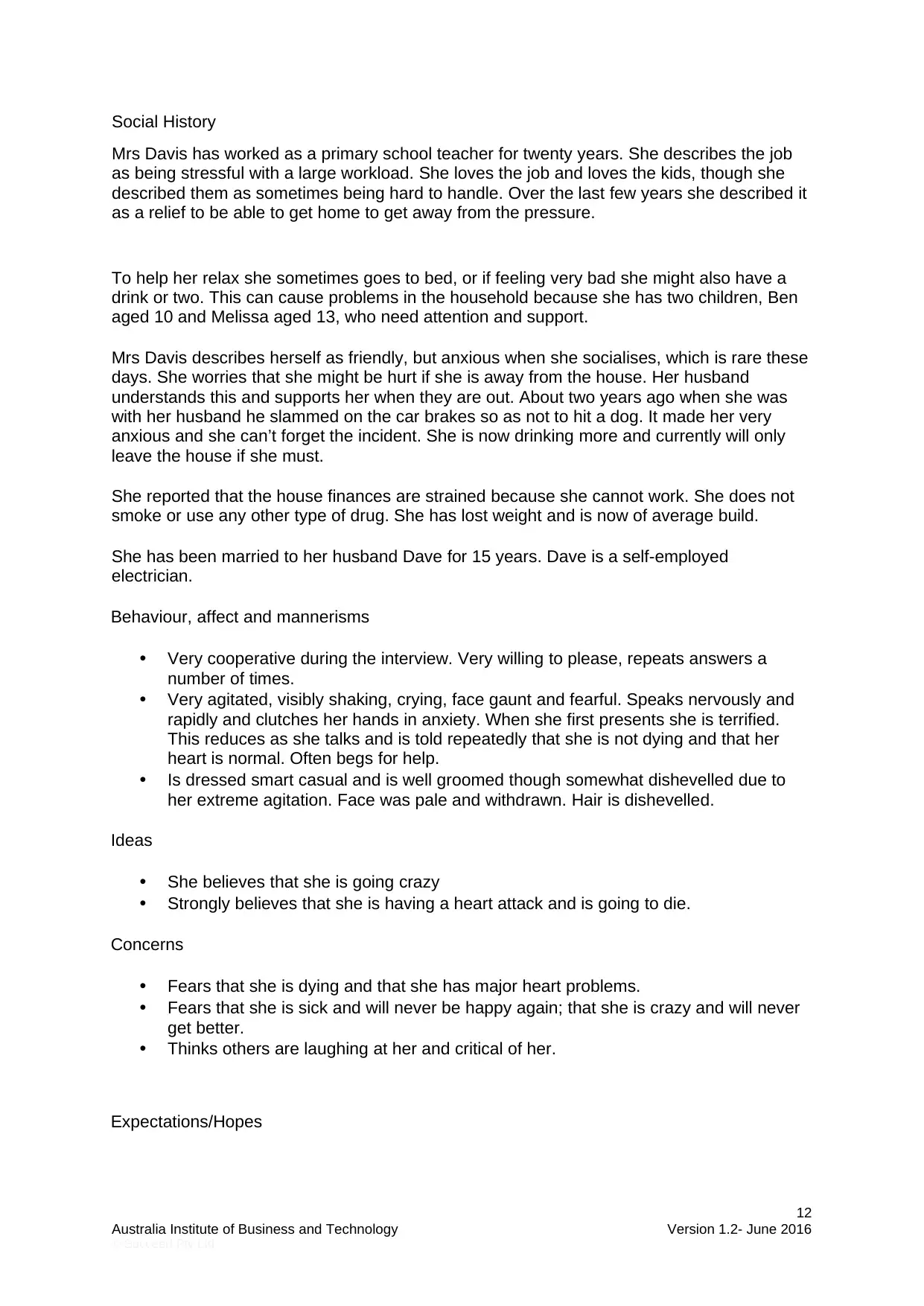
Social History
Mrs Davis has worked as a primary school teacher for twenty years. She describes the job
as being stressful with a large workload. She loves the job and loves the kids, though she
described them as sometimes being hard to handle. Over the last few years she described it
as a relief to be able to get home to get away from the pressure.
To help her relax she sometimes goes to bed, or if feeling very bad she might also have a
drink or two. This can cause problems in the household because she has two children, Ben
aged 10 and Melissa aged 13, who need attention and support.
Mrs Davis describes herself as friendly, but anxious when she socialises, which is rare these
days. She worries that she might be hurt if she is away from the house. Her husband
understands this and supports her when they are out. About two years ago when she was
with her husband he slammed on the car brakes so as not to hit a dog. It made her very
anxious and she can’t forget the incident. She is now drinking more and currently will only
leave the house if she must.
She reported that the house finances are strained because she cannot work. She does not
smoke or use any other type of drug. She has lost weight and is now of average build.
She has been married to her husband Dave for 15 years. Dave is a self-employed
electrician.
Behaviour, affect and mannerisms
• Very cooperative during the interview. Very willing to please, repeats answers a
number of times.
• Very agitated, visibly shaking, crying, face gaunt and fearful. Speaks nervously and
rapidly and clutches her hands in anxiety. When she first presents she is terrified.
This reduces as she talks and is told repeatedly that she is not dying and that her
heart is normal. Often begs for help.
• Is dressed smart casual and is well groomed though somewhat dishevelled due to
her extreme agitation. Face was pale and withdrawn. Hair is dishevelled.
Ideas
• She believes that she is going crazy
• Strongly believes that she is having a heart attack and is going to die.
Concerns
• Fears that she is dying and that she has major heart problems.
• Fears that she is sick and will never be happy again; that she is crazy and will never
get better.
• Thinks others are laughing at her and critical of her.
Expectations/Hopes
12
Australia Institute of Business and Technology Version 1.2- June 2016
© Succeed Pty Ltd
Mrs Davis has worked as a primary school teacher for twenty years. She describes the job
as being stressful with a large workload. She loves the job and loves the kids, though she
described them as sometimes being hard to handle. Over the last few years she described it
as a relief to be able to get home to get away from the pressure.
To help her relax she sometimes goes to bed, or if feeling very bad she might also have a
drink or two. This can cause problems in the household because she has two children, Ben
aged 10 and Melissa aged 13, who need attention and support.
Mrs Davis describes herself as friendly, but anxious when she socialises, which is rare these
days. She worries that she might be hurt if she is away from the house. Her husband
understands this and supports her when they are out. About two years ago when she was
with her husband he slammed on the car brakes so as not to hit a dog. It made her very
anxious and she can’t forget the incident. She is now drinking more and currently will only
leave the house if she must.
She reported that the house finances are strained because she cannot work. She does not
smoke or use any other type of drug. She has lost weight and is now of average build.
She has been married to her husband Dave for 15 years. Dave is a self-employed
electrician.
Behaviour, affect and mannerisms
• Very cooperative during the interview. Very willing to please, repeats answers a
number of times.
• Very agitated, visibly shaking, crying, face gaunt and fearful. Speaks nervously and
rapidly and clutches her hands in anxiety. When she first presents she is terrified.
This reduces as she talks and is told repeatedly that she is not dying and that her
heart is normal. Often begs for help.
• Is dressed smart casual and is well groomed though somewhat dishevelled due to
her extreme agitation. Face was pale and withdrawn. Hair is dishevelled.
Ideas
• She believes that she is going crazy
• Strongly believes that she is having a heart attack and is going to die.
Concerns
• Fears that she is dying and that she has major heart problems.
• Fears that she is sick and will never be happy again; that she is crazy and will never
get better.
• Thinks others are laughing at her and critical of her.
Expectations/Hopes
12
Australia Institute of Business and Technology Version 1.2- June 2016
© Succeed Pty Ltd
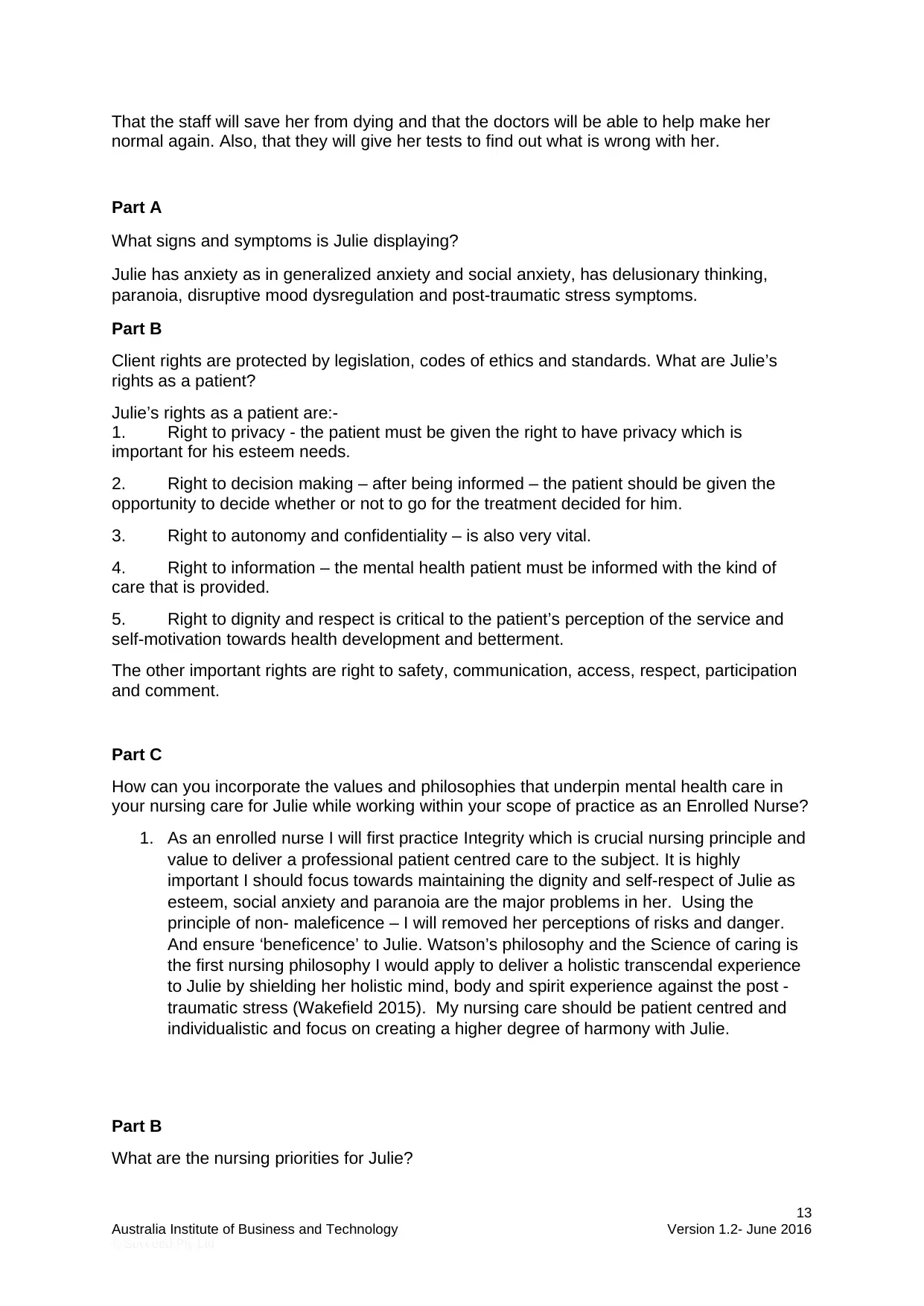
That the staff will save her from dying and that the doctors will be able to help make her
normal again. Also, that they will give her tests to find out what is wrong with her.
Part A
What signs and symptoms is Julie displaying?
Julie has anxiety as in generalized anxiety and social anxiety, has delusionary thinking,
paranoia, disruptive mood dysregulation and post-traumatic stress symptoms.
Part B
Client rights are protected by legislation, codes of ethics and standards. What are Julie’s
rights as a patient?
Julie’s rights as a patient are:-
1. Right to privacy - the patient must be given the right to have privacy which is
important for his esteem needs.
2. Right to decision making – after being informed – the patient should be given the
opportunity to decide whether or not to go for the treatment decided for him.
3. Right to autonomy and confidentiality – is also very vital.
4. Right to information – the mental health patient must be informed with the kind of
care that is provided.
5. Right to dignity and respect is critical to the patient’s perception of the service and
self-motivation towards health development and betterment.
The other important rights are right to safety, communication, access, respect, participation
and comment.
Part C
How can you incorporate the values and philosophies that underpin mental health care in
your nursing care for Julie while working within your scope of practice as an Enrolled Nurse?
1. As an enrolled nurse I will first practice Integrity which is crucial nursing principle and
value to deliver a professional patient centred care to the subject. It is highly
important I should focus towards maintaining the dignity and self-respect of Julie as
esteem, social anxiety and paranoia are the major problems in her. Using the
principle of non- maleficence – I will removed her perceptions of risks and danger.
And ensure ‘beneficence’ to Julie. Watson’s philosophy and the Science of caring is
the first nursing philosophy I would apply to deliver a holistic transcendal experience
to Julie by shielding her holistic mind, body and spirit experience against the post -
traumatic stress (Wakefield 2015). My nursing care should be patient centred and
individualistic and focus on creating a higher degree of harmony with Julie.
Part B
What are the nursing priorities for Julie?
13
Australia Institute of Business and Technology Version 1.2- June 2016
© Succeed Pty Ltd
normal again. Also, that they will give her tests to find out what is wrong with her.
Part A
What signs and symptoms is Julie displaying?
Julie has anxiety as in generalized anxiety and social anxiety, has delusionary thinking,
paranoia, disruptive mood dysregulation and post-traumatic stress symptoms.
Part B
Client rights are protected by legislation, codes of ethics and standards. What are Julie’s
rights as a patient?
Julie’s rights as a patient are:-
1. Right to privacy - the patient must be given the right to have privacy which is
important for his esteem needs.
2. Right to decision making – after being informed – the patient should be given the
opportunity to decide whether or not to go for the treatment decided for him.
3. Right to autonomy and confidentiality – is also very vital.
4. Right to information – the mental health patient must be informed with the kind of
care that is provided.
5. Right to dignity and respect is critical to the patient’s perception of the service and
self-motivation towards health development and betterment.
The other important rights are right to safety, communication, access, respect, participation
and comment.
Part C
How can you incorporate the values and philosophies that underpin mental health care in
your nursing care for Julie while working within your scope of practice as an Enrolled Nurse?
1. As an enrolled nurse I will first practice Integrity which is crucial nursing principle and
value to deliver a professional patient centred care to the subject. It is highly
important I should focus towards maintaining the dignity and self-respect of Julie as
esteem, social anxiety and paranoia are the major problems in her. Using the
principle of non- maleficence – I will removed her perceptions of risks and danger.
And ensure ‘beneficence’ to Julie. Watson’s philosophy and the Science of caring is
the first nursing philosophy I would apply to deliver a holistic transcendal experience
to Julie by shielding her holistic mind, body and spirit experience against the post -
traumatic stress (Wakefield 2015). My nursing care should be patient centred and
individualistic and focus on creating a higher degree of harmony with Julie.
Part B
What are the nursing priorities for Julie?
13
Australia Institute of Business and Technology Version 1.2- June 2016
© Succeed Pty Ltd
Paraphrase This Document
Need a fresh take? Get an instant paraphrase of this document with our AI Paraphraser
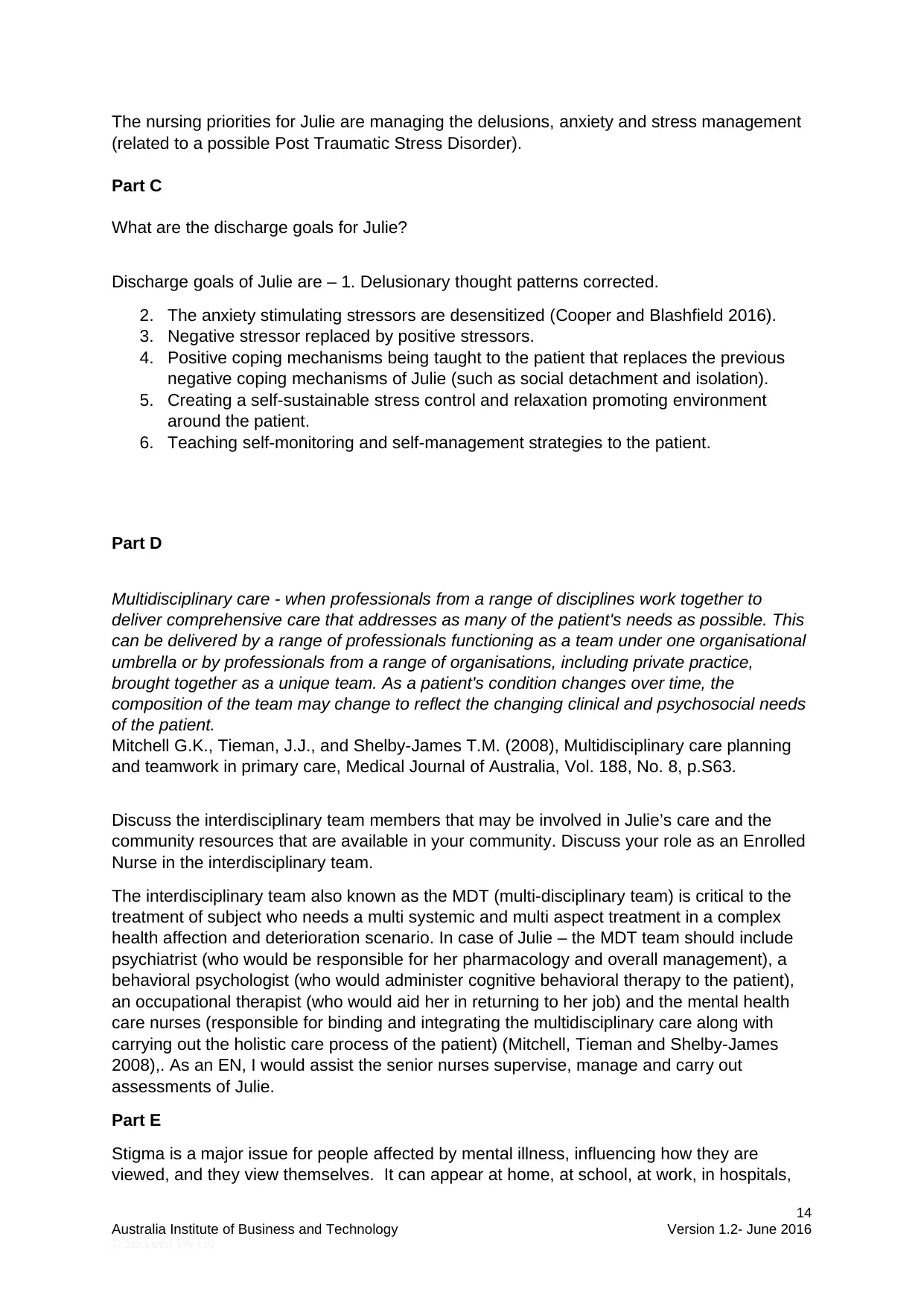
The nursing priorities for Julie are managing the delusions, anxiety and stress management
(related to a possible Post Traumatic Stress Disorder).
Part C
What are the discharge goals for Julie?
Discharge goals of Julie are – 1. Delusionary thought patterns corrected.
2. The anxiety stimulating stressors are desensitized (Cooper and Blashfield 2016).
3. Negative stressor replaced by positive stressors.
4. Positive coping mechanisms being taught to the patient that replaces the previous
negative coping mechanisms of Julie (such as social detachment and isolation).
5. Creating a self-sustainable stress control and relaxation promoting environment
around the patient.
6. Teaching self-monitoring and self-management strategies to the patient.
Part D
Multidisciplinary care - when professionals from a range of disciplines work together to
deliver comprehensive care that addresses as many of the patient's needs as possible. This
can be delivered by a range of professionals functioning as a team under one organisational
umbrella or by professionals from a range of organisations, including private practice,
brought together as a unique team. As a patient's condition changes over time, the
composition of the team may change to reflect the changing clinical and psychosocial needs
of the patient.
Mitchell G.K., Tieman, J.J., and Shelby-James T.M. (2008), Multidisciplinary care planning
and teamwork in primary care, Medical Journal of Australia, Vol. 188, No. 8, p.S63.
Discuss the interdisciplinary team members that may be involved in Julie’s care and the
community resources that are available in your community. Discuss your role as an Enrolled
Nurse in the interdisciplinary team.
The interdisciplinary team also known as the MDT (multi-disciplinary team) is critical to the
treatment of subject who needs a multi systemic and multi aspect treatment in a complex
health affection and deterioration scenario. In case of Julie – the MDT team should include
psychiatrist (who would be responsible for her pharmacology and overall management), a
behavioral psychologist (who would administer cognitive behavioral therapy to the patient),
an occupational therapist (who would aid her in returning to her job) and the mental health
care nurses (responsible for binding and integrating the multidisciplinary care along with
carrying out the holistic care process of the patient) (Mitchell, Tieman and Shelby-James
2008),. As an EN, I would assist the senior nurses supervise, manage and carry out
assessments of Julie.
Part E
Stigma is a major issue for people affected by mental illness, influencing how they are
viewed, and they view themselves. It can appear at home, at school, at work, in hospitals,
14
Australia Institute of Business and Technology Version 1.2- June 2016
© Succeed Pty Ltd
(related to a possible Post Traumatic Stress Disorder).
Part C
What are the discharge goals for Julie?
Discharge goals of Julie are – 1. Delusionary thought patterns corrected.
2. The anxiety stimulating stressors are desensitized (Cooper and Blashfield 2016).
3. Negative stressor replaced by positive stressors.
4. Positive coping mechanisms being taught to the patient that replaces the previous
negative coping mechanisms of Julie (such as social detachment and isolation).
5. Creating a self-sustainable stress control and relaxation promoting environment
around the patient.
6. Teaching self-monitoring and self-management strategies to the patient.
Part D
Multidisciplinary care - when professionals from a range of disciplines work together to
deliver comprehensive care that addresses as many of the patient's needs as possible. This
can be delivered by a range of professionals functioning as a team under one organisational
umbrella or by professionals from a range of organisations, including private practice,
brought together as a unique team. As a patient's condition changes over time, the
composition of the team may change to reflect the changing clinical and psychosocial needs
of the patient.
Mitchell G.K., Tieman, J.J., and Shelby-James T.M. (2008), Multidisciplinary care planning
and teamwork in primary care, Medical Journal of Australia, Vol. 188, No. 8, p.S63.
Discuss the interdisciplinary team members that may be involved in Julie’s care and the
community resources that are available in your community. Discuss your role as an Enrolled
Nurse in the interdisciplinary team.
The interdisciplinary team also known as the MDT (multi-disciplinary team) is critical to the
treatment of subject who needs a multi systemic and multi aspect treatment in a complex
health affection and deterioration scenario. In case of Julie – the MDT team should include
psychiatrist (who would be responsible for her pharmacology and overall management), a
behavioral psychologist (who would administer cognitive behavioral therapy to the patient),
an occupational therapist (who would aid her in returning to her job) and the mental health
care nurses (responsible for binding and integrating the multidisciplinary care along with
carrying out the holistic care process of the patient) (Mitchell, Tieman and Shelby-James
2008),. As an EN, I would assist the senior nurses supervise, manage and carry out
assessments of Julie.
Part E
Stigma is a major issue for people affected by mental illness, influencing how they are
viewed, and they view themselves. It can appear at home, at school, at work, in hospitals,
14
Australia Institute of Business and Technology Version 1.2- June 2016
© Succeed Pty Ltd
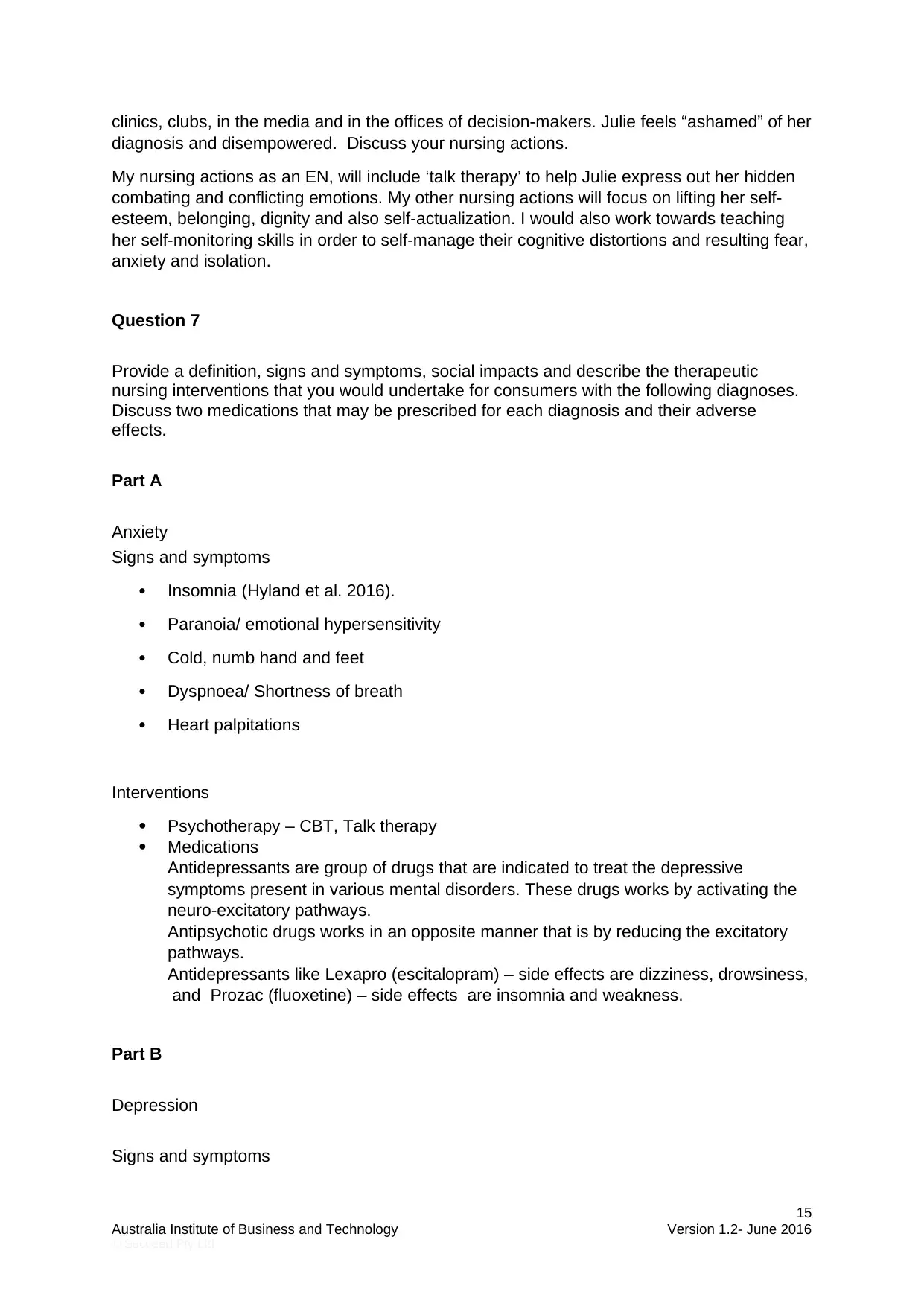
clinics, clubs, in the media and in the offices of decision-makers. Julie feels “ashamed” of her
diagnosis and disempowered. Discuss your nursing actions.
My nursing actions as an EN, will include ‘talk therapy’ to help Julie express out her hidden
combating and conflicting emotions. My other nursing actions will focus on lifting her self-
esteem, belonging, dignity and also self-actualization. I would also work towards teaching
her self-monitoring skills in order to self-manage their cognitive distortions and resulting fear,
anxiety and isolation.
Question 7
Provide a definition, signs and symptoms, social impacts and describe the therapeutic
nursing interventions that you would undertake for consumers with the following diagnoses.
Discuss two medications that may be prescribed for each diagnosis and their adverse
effects.
Part A
Anxiety
Signs and symptoms
Insomnia (Hyland et al. 2016).
Paranoia/ emotional hypersensitivity
Cold, numb hand and feet
Dyspnoea/ Shortness of breath
Heart palpitations
Interventions
Psychotherapy – CBT, Talk therapy
Medications
Antidepressants are group of drugs that are indicated to treat the depressive
symptoms present in various mental disorders. These drugs works by activating the
neuro-excitatory pathways.
Antipsychotic drugs works in an opposite manner that is by reducing the excitatory
pathways.
Antidepressants like Lexapro (escitalopram) – side effects are dizziness, drowsiness,
and Prozac (fluoxetine) – side effects are insomnia and weakness.
Part B
Depression
Signs and symptoms
15
Australia Institute of Business and Technology Version 1.2- June 2016
© Succeed Pty Ltd
diagnosis and disempowered. Discuss your nursing actions.
My nursing actions as an EN, will include ‘talk therapy’ to help Julie express out her hidden
combating and conflicting emotions. My other nursing actions will focus on lifting her self-
esteem, belonging, dignity and also self-actualization. I would also work towards teaching
her self-monitoring skills in order to self-manage their cognitive distortions and resulting fear,
anxiety and isolation.
Question 7
Provide a definition, signs and symptoms, social impacts and describe the therapeutic
nursing interventions that you would undertake for consumers with the following diagnoses.
Discuss two medications that may be prescribed for each diagnosis and their adverse
effects.
Part A
Anxiety
Signs and symptoms
Insomnia (Hyland et al. 2016).
Paranoia/ emotional hypersensitivity
Cold, numb hand and feet
Dyspnoea/ Shortness of breath
Heart palpitations
Interventions
Psychotherapy – CBT, Talk therapy
Medications
Antidepressants are group of drugs that are indicated to treat the depressive
symptoms present in various mental disorders. These drugs works by activating the
neuro-excitatory pathways.
Antipsychotic drugs works in an opposite manner that is by reducing the excitatory
pathways.
Antidepressants like Lexapro (escitalopram) – side effects are dizziness, drowsiness,
and Prozac (fluoxetine) – side effects are insomnia and weakness.
Part B
Depression
Signs and symptoms
15
Australia Institute of Business and Technology Version 1.2- June 2016
© Succeed Pty Ltd
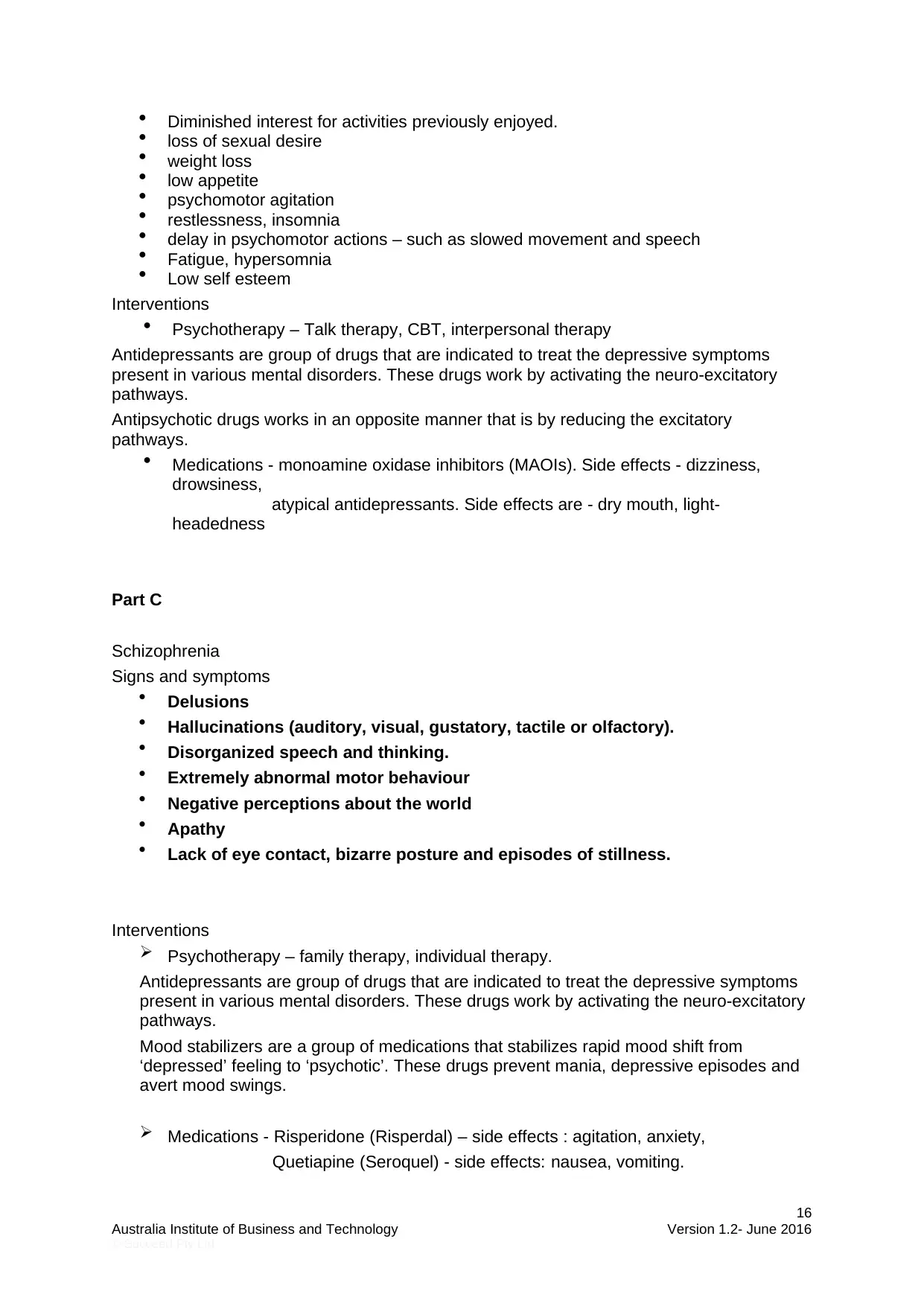
Diminished interest for activities previously enjoyed.
loss of sexual desire
weight loss
low appetite
psychomotor agitation
restlessness, insomnia
delay in psychomotor actions – such as slowed movement and speech
Fatigue, hypersomnia
Low self esteem
Interventions
Psychotherapy – Talk therapy, CBT, interpersonal therapy
Antidepressants are group of drugs that are indicated to treat the depressive symptoms
present in various mental disorders. These drugs work by activating the neuro-excitatory
pathways.
Antipsychotic drugs works in an opposite manner that is by reducing the excitatory
pathways.
Medications - monoamine oxidase inhibitors (MAOIs). Side effects - dizziness,
drowsiness,
atypical antidepressants. Side effects are - dry mouth, light-
headedness
Part C
Schizophrenia
Signs and symptoms
Delusions
Hallucinations (auditory, visual, gustatory, tactile or olfactory).
Disorganized speech and thinking.
Extremely abnormal motor behaviour
Negative perceptions about the world
Apathy
Lack of eye contact, bizarre posture and episodes of stillness.
Interventions
Psychotherapy – family therapy, individual therapy.
Antidepressants are group of drugs that are indicated to treat the depressive symptoms
present in various mental disorders. These drugs work by activating the neuro-excitatory
pathways.
Mood stabilizers are a group of medications that stabilizes rapid mood shift from
‘depressed’ feeling to ‘psychotic’. These drugs prevent mania, depressive episodes and
avert mood swings.
Medications - Risperidone (Risperdal) – side effects : agitation, anxiety,
Quetiapine (Seroquel) - side effects: nausea, vomiting.
16
Australia Institute of Business and Technology Version 1.2- June 2016
© Succeed Pty Ltd
loss of sexual desire
weight loss
low appetite
psychomotor agitation
restlessness, insomnia
delay in psychomotor actions – such as slowed movement and speech
Fatigue, hypersomnia
Low self esteem
Interventions
Psychotherapy – Talk therapy, CBT, interpersonal therapy
Antidepressants are group of drugs that are indicated to treat the depressive symptoms
present in various mental disorders. These drugs work by activating the neuro-excitatory
pathways.
Antipsychotic drugs works in an opposite manner that is by reducing the excitatory
pathways.
Medications - monoamine oxidase inhibitors (MAOIs). Side effects - dizziness,
drowsiness,
atypical antidepressants. Side effects are - dry mouth, light-
headedness
Part C
Schizophrenia
Signs and symptoms
Delusions
Hallucinations (auditory, visual, gustatory, tactile or olfactory).
Disorganized speech and thinking.
Extremely abnormal motor behaviour
Negative perceptions about the world
Apathy
Lack of eye contact, bizarre posture and episodes of stillness.
Interventions
Psychotherapy – family therapy, individual therapy.
Antidepressants are group of drugs that are indicated to treat the depressive symptoms
present in various mental disorders. These drugs work by activating the neuro-excitatory
pathways.
Mood stabilizers are a group of medications that stabilizes rapid mood shift from
‘depressed’ feeling to ‘psychotic’. These drugs prevent mania, depressive episodes and
avert mood swings.
Medications - Risperidone (Risperdal) – side effects : agitation, anxiety,
Quetiapine (Seroquel) - side effects: nausea, vomiting.
16
Australia Institute of Business and Technology Version 1.2- June 2016
© Succeed Pty Ltd
Secure Best Marks with AI Grader
Need help grading? Try our AI Grader for instant feedback on your assignments.
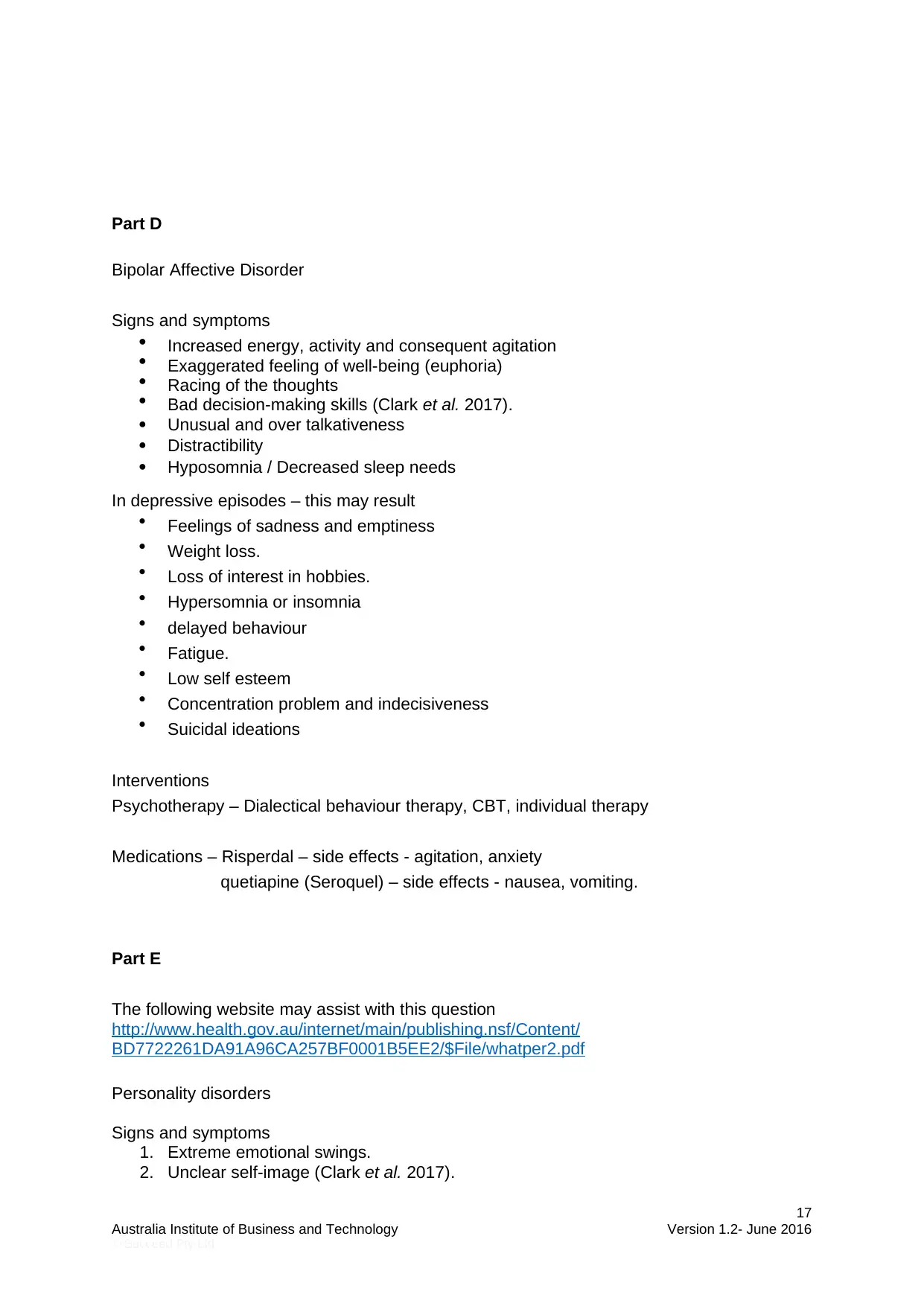
Part D
Bipolar Affective Disorder
Signs and symptoms
Increased energy, activity and consequent agitation
Exaggerated feeling of well-being (euphoria)
Racing of the thoughts
Bad decision-making skills (Clark et al. 2017).
Unusual and over talkativeness
Distractibility
Hyposomnia / Decreased sleep needs
In depressive episodes – this may result
Feelings of sadness and emptiness
Weight loss.
Loss of interest in hobbies.
Hypersomnia or insomnia
delayed behaviour
Fatigue.
Low self esteem
Concentration problem and indecisiveness
Suicidal ideations
Interventions
Psychotherapy – Dialectical behaviour therapy, CBT, individual therapy
Medications – Risperdal – side effects - agitation, anxiety
quetiapine (Seroquel) – side effects - nausea, vomiting.
Part E
The following website may assist with this question
http://www.health.gov.au/internet/main/publishing.nsf/Content/
BD7722261DA91A96CA257BF0001B5EE2/$File/whatper2.pdf
Personality disorders
Signs and symptoms
1. Extreme emotional swings.
2. Unclear self-image (Clark et al. 2017).
17
Australia Institute of Business and Technology Version 1.2- June 2016
© Succeed Pty Ltd
Bipolar Affective Disorder
Signs and symptoms
Increased energy, activity and consequent agitation
Exaggerated feeling of well-being (euphoria)
Racing of the thoughts
Bad decision-making skills (Clark et al. 2017).
Unusual and over talkativeness
Distractibility
Hyposomnia / Decreased sleep needs
In depressive episodes – this may result
Feelings of sadness and emptiness
Weight loss.
Loss of interest in hobbies.
Hypersomnia or insomnia
delayed behaviour
Fatigue.
Low self esteem
Concentration problem and indecisiveness
Suicidal ideations
Interventions
Psychotherapy – Dialectical behaviour therapy, CBT, individual therapy
Medications – Risperdal – side effects - agitation, anxiety
quetiapine (Seroquel) – side effects - nausea, vomiting.
Part E
The following website may assist with this question
http://www.health.gov.au/internet/main/publishing.nsf/Content/
BD7722261DA91A96CA257BF0001B5EE2/$File/whatper2.pdf
Personality disorders
Signs and symptoms
1. Extreme emotional swings.
2. Unclear self-image (Clark et al. 2017).
17
Australia Institute of Business and Technology Version 1.2- June 2016
© Succeed Pty Ltd
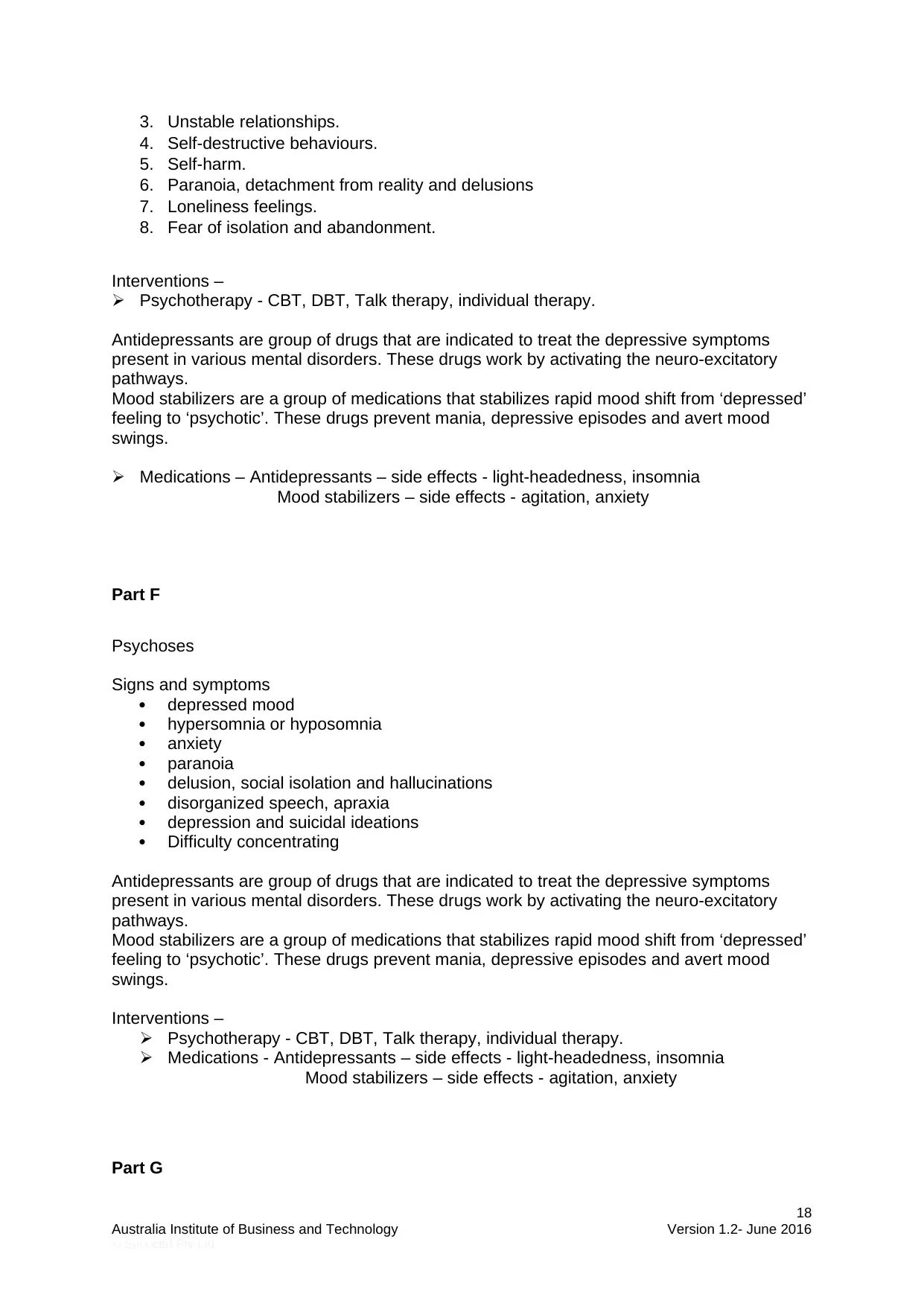
3. Unstable relationships.
4. Self-destructive behaviours.
5. Self-harm.
6. Paranoia, detachment from reality and delusions
7. Loneliness feelings.
8. Fear of isolation and abandonment.
Interventions –
Psychotherapy - CBT, DBT, Talk therapy, individual therapy.
Antidepressants are group of drugs that are indicated to treat the depressive symptoms
present in various mental disorders. These drugs work by activating the neuro-excitatory
pathways.
Mood stabilizers are a group of medications that stabilizes rapid mood shift from ‘depressed’
feeling to ‘psychotic’. These drugs prevent mania, depressive episodes and avert mood
swings.
Medications – Antidepressants – side effects - light-headedness, insomnia
Mood stabilizers – side effects - agitation, anxiety
Part F
Psychoses
Signs and symptoms
depressed mood
hypersomnia or hyposomnia
anxiety
paranoia
delusion, social isolation and hallucinations
disorganized speech, apraxia
depression and suicidal ideations
Difficulty concentrating
Antidepressants are group of drugs that are indicated to treat the depressive symptoms
present in various mental disorders. These drugs work by activating the neuro-excitatory
pathways.
Mood stabilizers are a group of medications that stabilizes rapid mood shift from ‘depressed’
feeling to ‘psychotic’. These drugs prevent mania, depressive episodes and avert mood
swings.
Interventions –
Psychotherapy - CBT, DBT, Talk therapy, individual therapy.
Medications - Antidepressants – side effects - light-headedness, insomnia
Mood stabilizers – side effects - agitation, anxiety
Part G
18
Australia Institute of Business and Technology Version 1.2- June 2016
© Succeed Pty Ltd
4. Self-destructive behaviours.
5. Self-harm.
6. Paranoia, detachment from reality and delusions
7. Loneliness feelings.
8. Fear of isolation and abandonment.
Interventions –
Psychotherapy - CBT, DBT, Talk therapy, individual therapy.
Antidepressants are group of drugs that are indicated to treat the depressive symptoms
present in various mental disorders. These drugs work by activating the neuro-excitatory
pathways.
Mood stabilizers are a group of medications that stabilizes rapid mood shift from ‘depressed’
feeling to ‘psychotic’. These drugs prevent mania, depressive episodes and avert mood
swings.
Medications – Antidepressants – side effects - light-headedness, insomnia
Mood stabilizers – side effects - agitation, anxiety
Part F
Psychoses
Signs and symptoms
depressed mood
hypersomnia or hyposomnia
anxiety
paranoia
delusion, social isolation and hallucinations
disorganized speech, apraxia
depression and suicidal ideations
Difficulty concentrating
Antidepressants are group of drugs that are indicated to treat the depressive symptoms
present in various mental disorders. These drugs work by activating the neuro-excitatory
pathways.
Mood stabilizers are a group of medications that stabilizes rapid mood shift from ‘depressed’
feeling to ‘psychotic’. These drugs prevent mania, depressive episodes and avert mood
swings.
Interventions –
Psychotherapy - CBT, DBT, Talk therapy, individual therapy.
Medications - Antidepressants – side effects - light-headedness, insomnia
Mood stabilizers – side effects - agitation, anxiety
Part G
18
Australia Institute of Business and Technology Version 1.2- June 2016
© Succeed Pty Ltd
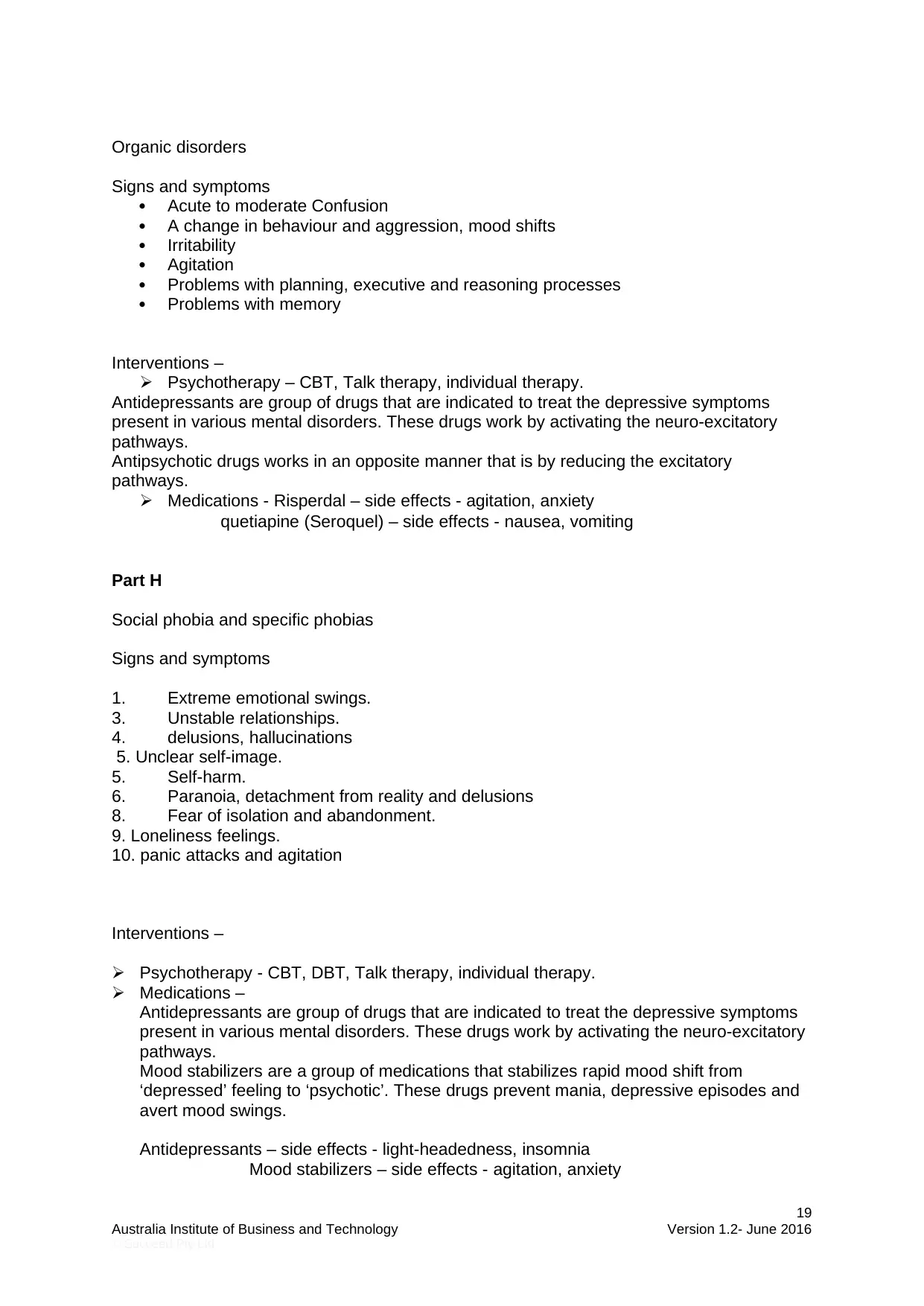
Organic disorders
Signs and symptoms
Acute to moderate Confusion
A change in behaviour and aggression, mood shifts
Irritability
Agitation
Problems with planning, executive and reasoning processes
Problems with memory
Interventions –
Psychotherapy – CBT, Talk therapy, individual therapy.
Antidepressants are group of drugs that are indicated to treat the depressive symptoms
present in various mental disorders. These drugs work by activating the neuro-excitatory
pathways.
Antipsychotic drugs works in an opposite manner that is by reducing the excitatory
pathways.
Medications - Risperdal – side effects - agitation, anxiety
quetiapine (Seroquel) – side effects - nausea, vomiting
Part H
Social phobia and specific phobias
Signs and symptoms
1. Extreme emotional swings.
3. Unstable relationships.
4. delusions, hallucinations
5. Unclear self-image.
5. Self-harm.
6. Paranoia, detachment from reality and delusions
8. Fear of isolation and abandonment.
9. Loneliness feelings.
10. panic attacks and agitation
Interventions –
Psychotherapy - CBT, DBT, Talk therapy, individual therapy.
Medications –
Antidepressants are group of drugs that are indicated to treat the depressive symptoms
present in various mental disorders. These drugs work by activating the neuro-excitatory
pathways.
Mood stabilizers are a group of medications that stabilizes rapid mood shift from
‘depressed’ feeling to ‘psychotic’. These drugs prevent mania, depressive episodes and
avert mood swings.
Antidepressants – side effects - light-headedness, insomnia
Mood stabilizers – side effects - agitation, anxiety
19
Australia Institute of Business and Technology Version 1.2- June 2016
© Succeed Pty Ltd
Signs and symptoms
Acute to moderate Confusion
A change in behaviour and aggression, mood shifts
Irritability
Agitation
Problems with planning, executive and reasoning processes
Problems with memory
Interventions –
Psychotherapy – CBT, Talk therapy, individual therapy.
Antidepressants are group of drugs that are indicated to treat the depressive symptoms
present in various mental disorders. These drugs work by activating the neuro-excitatory
pathways.
Antipsychotic drugs works in an opposite manner that is by reducing the excitatory
pathways.
Medications - Risperdal – side effects - agitation, anxiety
quetiapine (Seroquel) – side effects - nausea, vomiting
Part H
Social phobia and specific phobias
Signs and symptoms
1. Extreme emotional swings.
3. Unstable relationships.
4. delusions, hallucinations
5. Unclear self-image.
5. Self-harm.
6. Paranoia, detachment from reality and delusions
8. Fear of isolation and abandonment.
9. Loneliness feelings.
10. panic attacks and agitation
Interventions –
Psychotherapy - CBT, DBT, Talk therapy, individual therapy.
Medications –
Antidepressants are group of drugs that are indicated to treat the depressive symptoms
present in various mental disorders. These drugs work by activating the neuro-excitatory
pathways.
Mood stabilizers are a group of medications that stabilizes rapid mood shift from
‘depressed’ feeling to ‘psychotic’. These drugs prevent mania, depressive episodes and
avert mood swings.
Antidepressants – side effects - light-headedness, insomnia
Mood stabilizers – side effects - agitation, anxiety
19
Australia Institute of Business and Technology Version 1.2- June 2016
© Succeed Pty Ltd
Paraphrase This Document
Need a fresh take? Get an instant paraphrase of this document with our AI Paraphraser
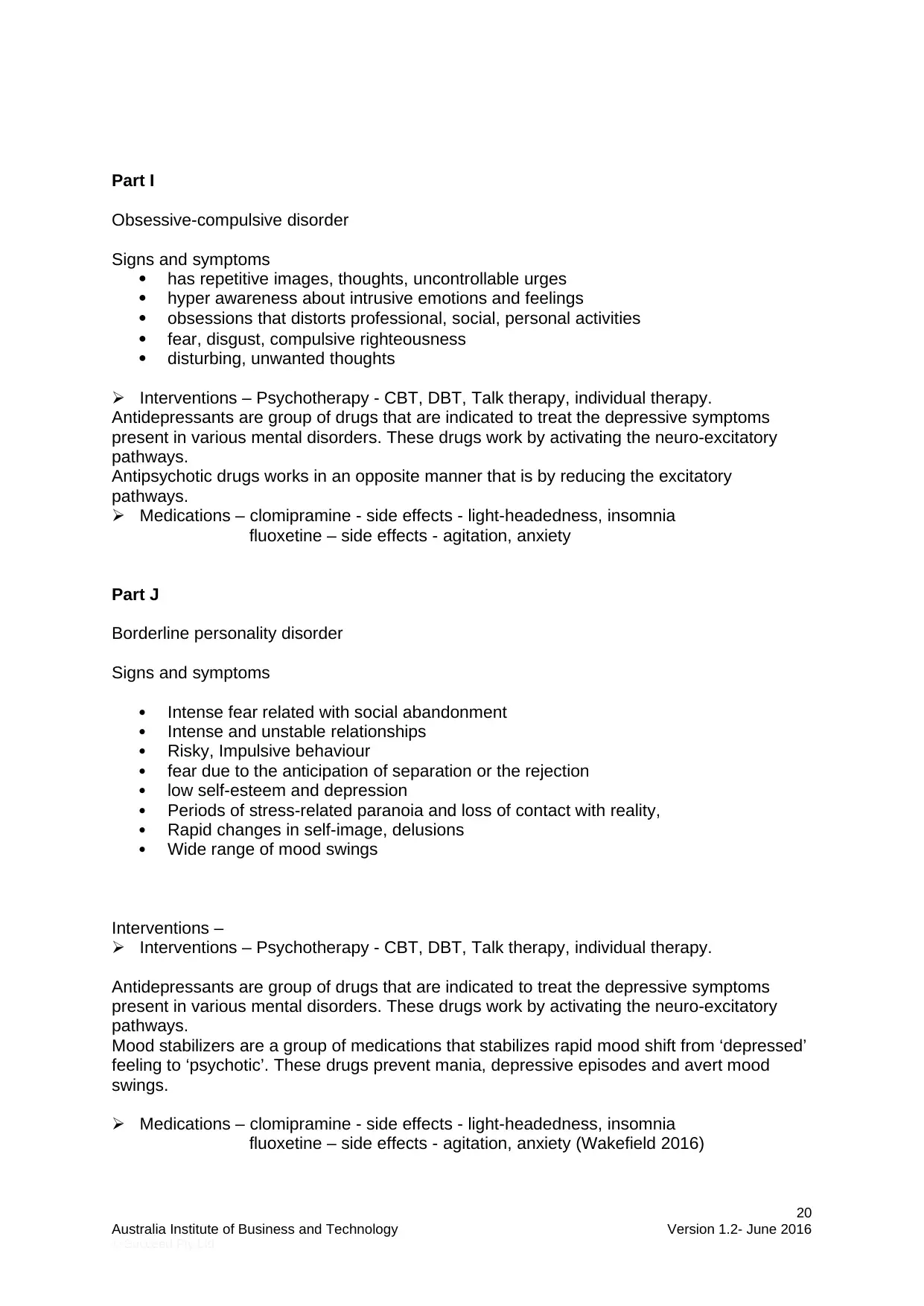
Part I
Obsessive-compulsive disorder
Signs and symptoms
has repetitive images, thoughts, uncontrollable urges
hyper awareness about intrusive emotions and feelings
obsessions that distorts professional, social, personal activities
fear, disgust, compulsive righteousness
disturbing, unwanted thoughts
Interventions – Psychotherapy - CBT, DBT, Talk therapy, individual therapy.
Antidepressants are group of drugs that are indicated to treat the depressive symptoms
present in various mental disorders. These drugs work by activating the neuro-excitatory
pathways.
Antipsychotic drugs works in an opposite manner that is by reducing the excitatory
pathways.
Medications – clomipramine - side effects - light-headedness, insomnia
fluoxetine – side effects - agitation, anxiety
Part J
Borderline personality disorder
Signs and symptoms
Intense fear related with social abandonment
Intense and unstable relationships
Risky, Impulsive behaviour
fear due to the anticipation of separation or the rejection
low self-esteem and depression
Periods of stress-related paranoia and loss of contact with reality,
Rapid changes in self-image, delusions
Wide range of mood swings
Interventions –
Interventions – Psychotherapy - CBT, DBT, Talk therapy, individual therapy.
Antidepressants are group of drugs that are indicated to treat the depressive symptoms
present in various mental disorders. These drugs work by activating the neuro-excitatory
pathways.
Mood stabilizers are a group of medications that stabilizes rapid mood shift from ‘depressed’
feeling to ‘psychotic’. These drugs prevent mania, depressive episodes and avert mood
swings.
Medications – clomipramine - side effects - light-headedness, insomnia
fluoxetine – side effects - agitation, anxiety (Wakefield 2016)
20
Australia Institute of Business and Technology Version 1.2- June 2016
© Succeed Pty Ltd
Obsessive-compulsive disorder
Signs and symptoms
has repetitive images, thoughts, uncontrollable urges
hyper awareness about intrusive emotions and feelings
obsessions that distorts professional, social, personal activities
fear, disgust, compulsive righteousness
disturbing, unwanted thoughts
Interventions – Psychotherapy - CBT, DBT, Talk therapy, individual therapy.
Antidepressants are group of drugs that are indicated to treat the depressive symptoms
present in various mental disorders. These drugs work by activating the neuro-excitatory
pathways.
Antipsychotic drugs works in an opposite manner that is by reducing the excitatory
pathways.
Medications – clomipramine - side effects - light-headedness, insomnia
fluoxetine – side effects - agitation, anxiety
Part J
Borderline personality disorder
Signs and symptoms
Intense fear related with social abandonment
Intense and unstable relationships
Risky, Impulsive behaviour
fear due to the anticipation of separation or the rejection
low self-esteem and depression
Periods of stress-related paranoia and loss of contact with reality,
Rapid changes in self-image, delusions
Wide range of mood swings
Interventions –
Interventions – Psychotherapy - CBT, DBT, Talk therapy, individual therapy.
Antidepressants are group of drugs that are indicated to treat the depressive symptoms
present in various mental disorders. These drugs work by activating the neuro-excitatory
pathways.
Mood stabilizers are a group of medications that stabilizes rapid mood shift from ‘depressed’
feeling to ‘psychotic’. These drugs prevent mania, depressive episodes and avert mood
swings.
Medications – clomipramine - side effects - light-headedness, insomnia
fluoxetine – side effects - agitation, anxiety (Wakefield 2016)
20
Australia Institute of Business and Technology Version 1.2- June 2016
© Succeed Pty Ltd
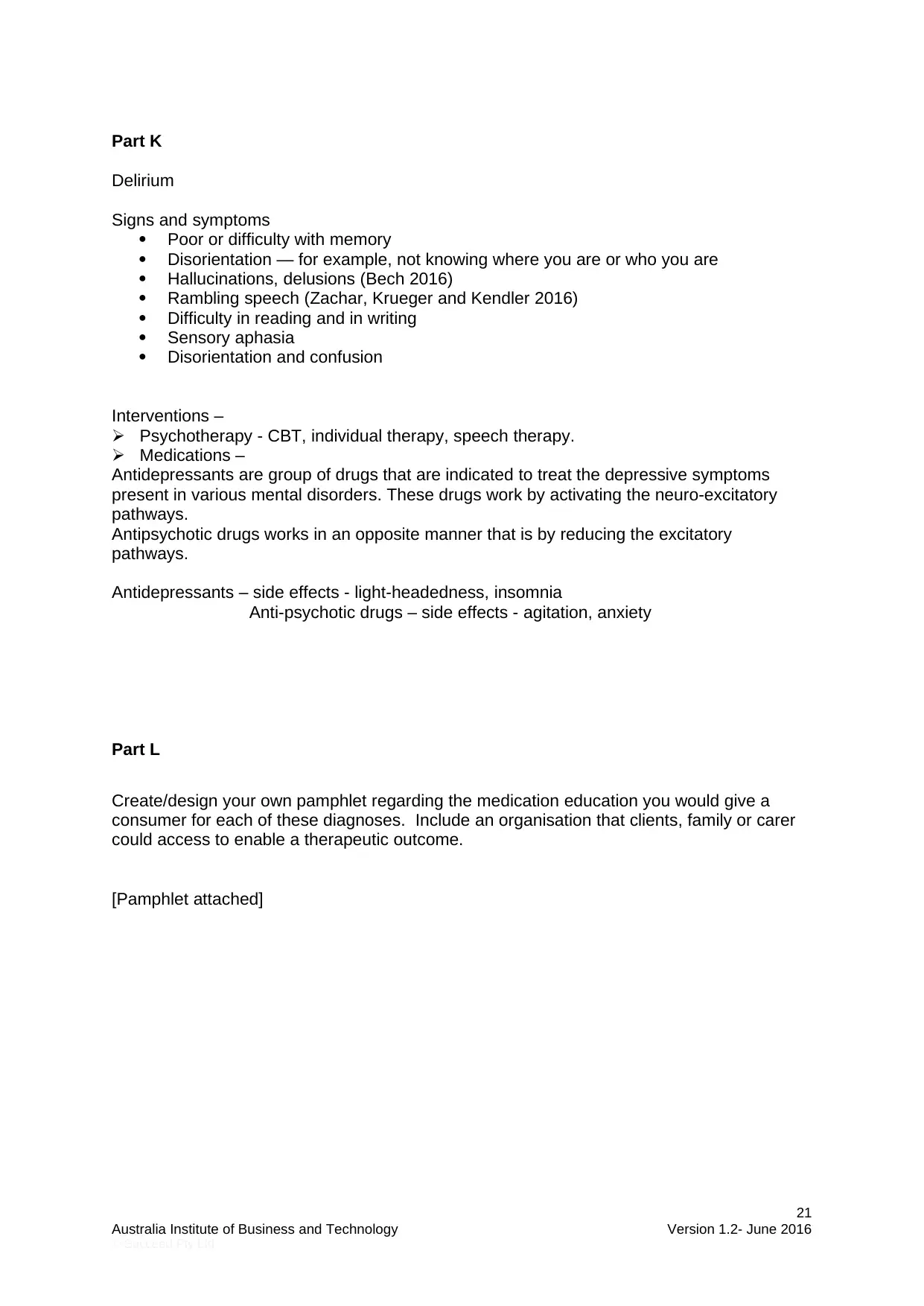
Part K
Delirium
Signs and symptoms
Poor or difficulty with memory
Disorientation — for example, not knowing where you are or who you are
Hallucinations, delusions (Bech 2016)
Rambling speech (Zachar, Krueger and Kendler 2016)
Difficulty in reading and in writing
Sensory aphasia
Disorientation and confusion
Interventions –
Psychotherapy - CBT, individual therapy, speech therapy.
Medications –
Antidepressants are group of drugs that are indicated to treat the depressive symptoms
present in various mental disorders. These drugs work by activating the neuro-excitatory
pathways.
Antipsychotic drugs works in an opposite manner that is by reducing the excitatory
pathways.
Antidepressants – side effects - light-headedness, insomnia
Anti-psychotic drugs – side effects - agitation, anxiety
Part L
Create/design your own pamphlet regarding the medication education you would give a
consumer for each of these diagnoses. Include an organisation that clients, family or carer
could access to enable a therapeutic outcome.
[Pamphlet attached]
21
Australia Institute of Business and Technology Version 1.2- June 2016
© Succeed Pty Ltd
Delirium
Signs and symptoms
Poor or difficulty with memory
Disorientation — for example, not knowing where you are or who you are
Hallucinations, delusions (Bech 2016)
Rambling speech (Zachar, Krueger and Kendler 2016)
Difficulty in reading and in writing
Sensory aphasia
Disorientation and confusion
Interventions –
Psychotherapy - CBT, individual therapy, speech therapy.
Medications –
Antidepressants are group of drugs that are indicated to treat the depressive symptoms
present in various mental disorders. These drugs work by activating the neuro-excitatory
pathways.
Antipsychotic drugs works in an opposite manner that is by reducing the excitatory
pathways.
Antidepressants – side effects - light-headedness, insomnia
Anti-psychotic drugs – side effects - agitation, anxiety
Part L
Create/design your own pamphlet regarding the medication education you would give a
consumer for each of these diagnoses. Include an organisation that clients, family or carer
could access to enable a therapeutic outcome.
[Pamphlet attached]
21
Australia Institute of Business and Technology Version 1.2- June 2016
© Succeed Pty Ltd
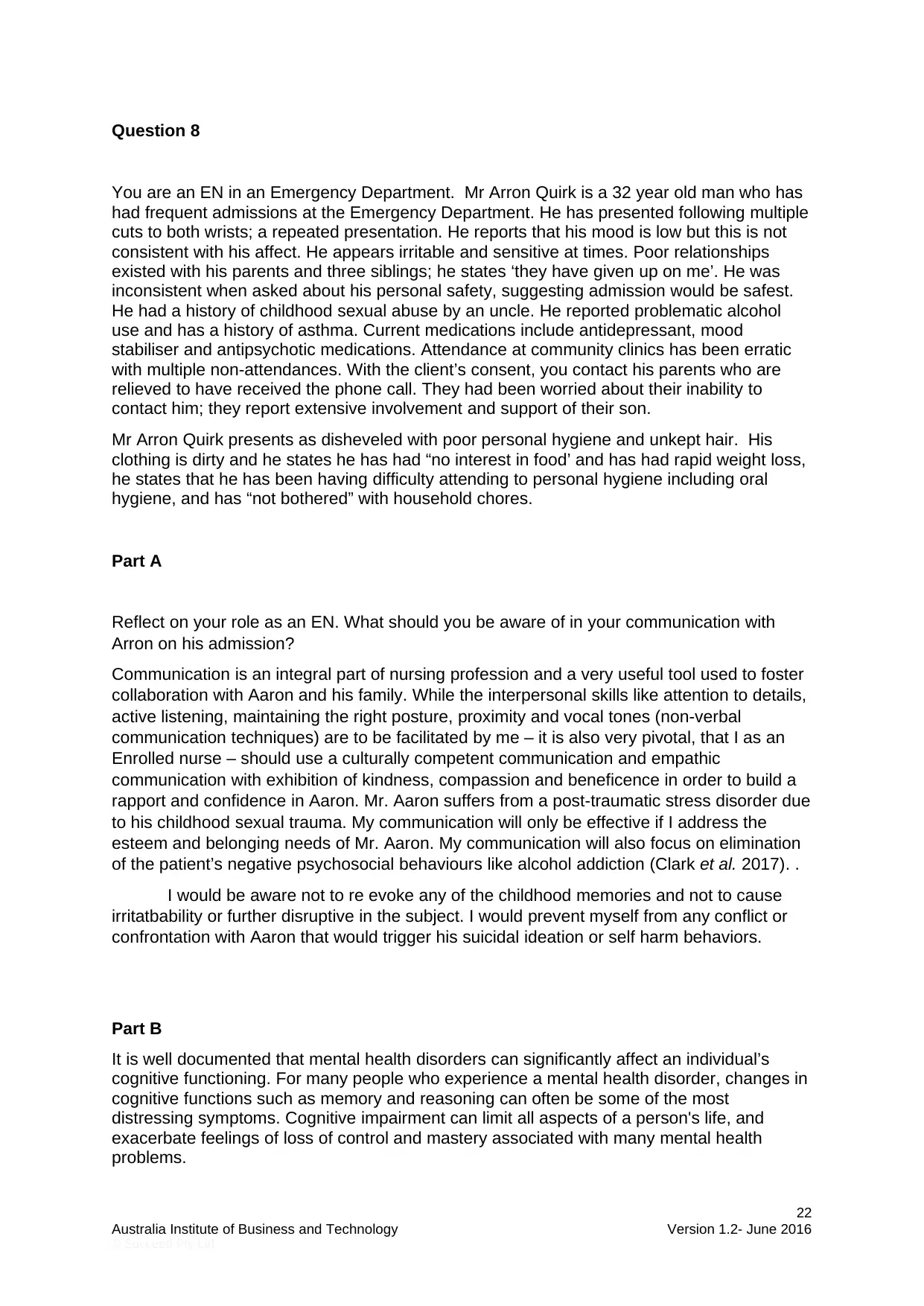
Question 8
You are an EN in an Emergency Department. Mr Arron Quirk is a 32 year old man who has
had frequent admissions at the Emergency Department. He has presented following multiple
cuts to both wrists; a repeated presentation. He reports that his mood is low but this is not
consistent with his affect. He appears irritable and sensitive at times. Poor relationships
existed with his parents and three siblings; he states ‘they have given up on me’. He was
inconsistent when asked about his personal safety, suggesting admission would be safest.
He had a history of childhood sexual abuse by an uncle. He reported problematic alcohol
use and has a history of asthma. Current medications include antidepressant, mood
stabiliser and antipsychotic medications. Attendance at community clinics has been erratic
with multiple non-attendances. With the client’s consent, you contact his parents who are
relieved to have received the phone call. They had been worried about their inability to
contact him; they report extensive involvement and support of their son.
Mr Arron Quirk presents as disheveled with poor personal hygiene and unkept hair. His
clothing is dirty and he states he has had “no interest in food’ and has had rapid weight loss,
he states that he has been having difficulty attending to personal hygiene including oral
hygiene, and has “not bothered” with household chores.
Part A
Reflect on your role as an EN. What should you be aware of in your communication with
Arron on his admission?
Communication is an integral part of nursing profession and a very useful tool used to foster
collaboration with Aaron and his family. While the interpersonal skills like attention to details,
active listening, maintaining the right posture, proximity and vocal tones (non-verbal
communication techniques) are to be facilitated by me – it is also very pivotal, that I as an
Enrolled nurse – should use a culturally competent communication and empathic
communication with exhibition of kindness, compassion and beneficence in order to build a
rapport and confidence in Aaron. Mr. Aaron suffers from a post-traumatic stress disorder due
to his childhood sexual trauma. My communication will only be effective if I address the
esteem and belonging needs of Mr. Aaron. My communication will also focus on elimination
of the patient’s negative psychosocial behaviours like alcohol addiction (Clark et al. 2017). .
I would be aware not to re evoke any of the childhood memories and not to cause
irritatbability or further disruptive in the subject. I would prevent myself from any conflict or
confrontation with Aaron that would trigger his suicidal ideation or self harm behaviors.
Part B
It is well documented that mental health disorders can significantly affect an individual’s
cognitive functioning. For many people who experience a mental health disorder, changes in
cognitive functions such as memory and reasoning can often be some of the most
distressing symptoms. Cognitive impairment can limit all aspects of a person's life, and
exacerbate feelings of loss of control and mastery associated with many mental health
problems.
22
Australia Institute of Business and Technology Version 1.2- June 2016
© Succeed Pty Ltd
You are an EN in an Emergency Department. Mr Arron Quirk is a 32 year old man who has
had frequent admissions at the Emergency Department. He has presented following multiple
cuts to both wrists; a repeated presentation. He reports that his mood is low but this is not
consistent with his affect. He appears irritable and sensitive at times. Poor relationships
existed with his parents and three siblings; he states ‘they have given up on me’. He was
inconsistent when asked about his personal safety, suggesting admission would be safest.
He had a history of childhood sexual abuse by an uncle. He reported problematic alcohol
use and has a history of asthma. Current medications include antidepressant, mood
stabiliser and antipsychotic medications. Attendance at community clinics has been erratic
with multiple non-attendances. With the client’s consent, you contact his parents who are
relieved to have received the phone call. They had been worried about their inability to
contact him; they report extensive involvement and support of their son.
Mr Arron Quirk presents as disheveled with poor personal hygiene and unkept hair. His
clothing is dirty and he states he has had “no interest in food’ and has had rapid weight loss,
he states that he has been having difficulty attending to personal hygiene including oral
hygiene, and has “not bothered” with household chores.
Part A
Reflect on your role as an EN. What should you be aware of in your communication with
Arron on his admission?
Communication is an integral part of nursing profession and a very useful tool used to foster
collaboration with Aaron and his family. While the interpersonal skills like attention to details,
active listening, maintaining the right posture, proximity and vocal tones (non-verbal
communication techniques) are to be facilitated by me – it is also very pivotal, that I as an
Enrolled nurse – should use a culturally competent communication and empathic
communication with exhibition of kindness, compassion and beneficence in order to build a
rapport and confidence in Aaron. Mr. Aaron suffers from a post-traumatic stress disorder due
to his childhood sexual trauma. My communication will only be effective if I address the
esteem and belonging needs of Mr. Aaron. My communication will also focus on elimination
of the patient’s negative psychosocial behaviours like alcohol addiction (Clark et al. 2017). .
I would be aware not to re evoke any of the childhood memories and not to cause
irritatbability or further disruptive in the subject. I would prevent myself from any conflict or
confrontation with Aaron that would trigger his suicidal ideation or self harm behaviors.
Part B
It is well documented that mental health disorders can significantly affect an individual’s
cognitive functioning. For many people who experience a mental health disorder, changes in
cognitive functions such as memory and reasoning can often be some of the most
distressing symptoms. Cognitive impairment can limit all aspects of a person's life, and
exacerbate feelings of loss of control and mastery associated with many mental health
problems.
22
Australia Institute of Business and Technology Version 1.2- June 2016
© Succeed Pty Ltd
Secure Best Marks with AI Grader
Need help grading? Try our AI Grader for instant feedback on your assignments.
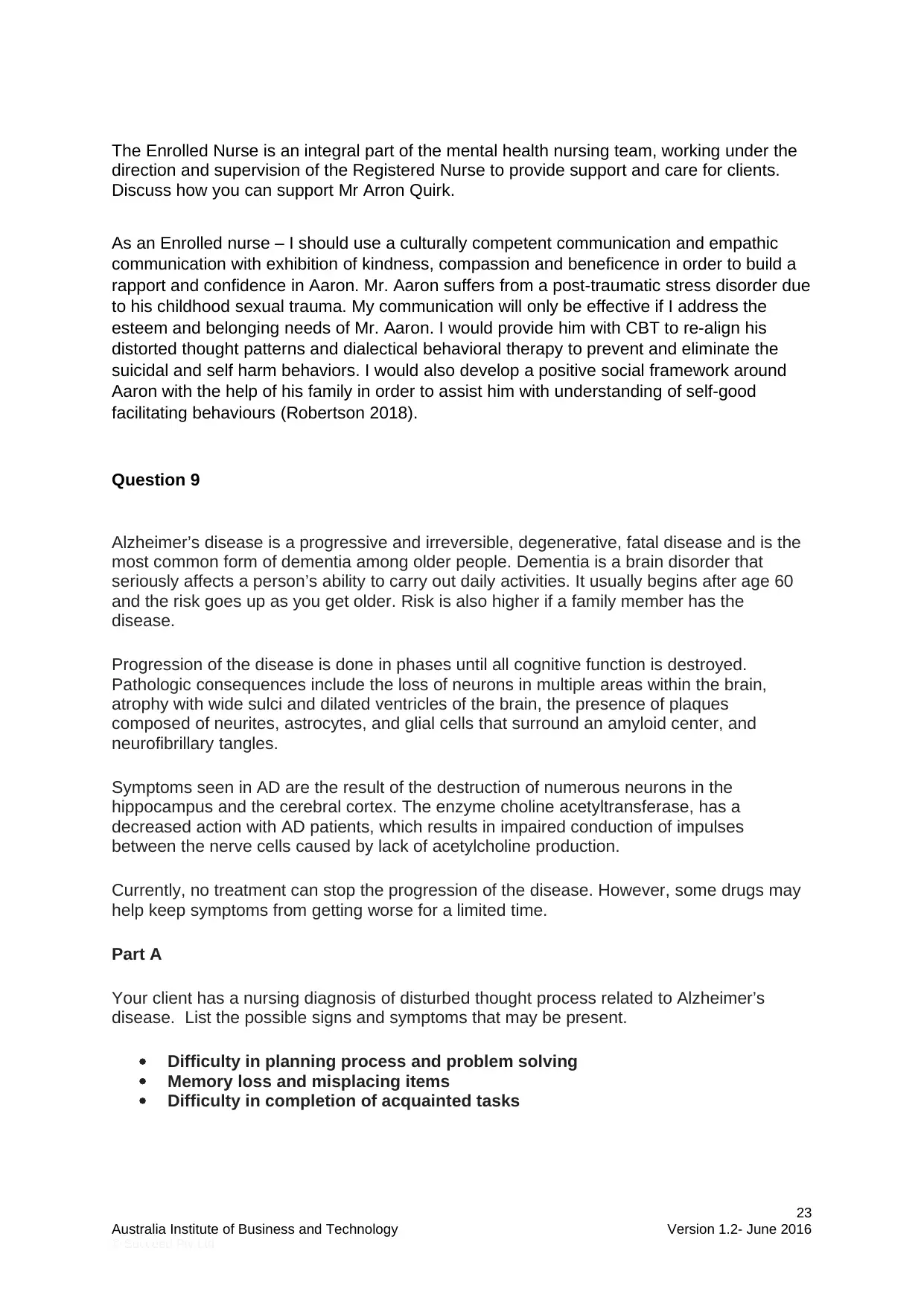
The Enrolled Nurse is an integral part of the mental health nursing team, working under the
direction and supervision of the Registered Nurse to provide support and care for clients.
Discuss how you can support Mr Arron Quirk.
As an Enrolled nurse – I should use a culturally competent communication and empathic
communication with exhibition of kindness, compassion and beneficence in order to build a
rapport and confidence in Aaron. Mr. Aaron suffers from a post-traumatic stress disorder due
to his childhood sexual trauma. My communication will only be effective if I address the
esteem and belonging needs of Mr. Aaron. I would provide him with CBT to re-align his
distorted thought patterns and dialectical behavioral therapy to prevent and eliminate the
suicidal and self harm behaviors. I would also develop a positive social framework around
Aaron with the help of his family in order to assist him with understanding of self-good
facilitating behaviours (Robertson 2018).
Question 9
Alzheimer’s disease is a progressive and irreversible, degenerative, fatal disease and is the
most common form of dementia among older people. Dementia is a brain disorder that
seriously affects a person’s ability to carry out daily activities. It usually begins after age 60
and the risk goes up as you get older. Risk is also higher if a family member has the
disease.
Progression of the disease is done in phases until all cognitive function is destroyed.
Pathologic consequences include the loss of neurons in multiple areas within the brain,
atrophy with wide sulci and dilated ventricles of the brain, the presence of plaques
composed of neurites, astrocytes, and glial cells that surround an amyloid center, and
neurofibrillary tangles.
Symptoms seen in AD are the result of the destruction of numerous neurons in the
hippocampus and the cerebral cortex. The enzyme choline acetyltransferase, has a
decreased action with AD patients, which results in impaired conduction of impulses
between the nerve cells caused by lack of acetylcholine production.
Currently, no treatment can stop the progression of the disease. However, some drugs may
help keep symptoms from getting worse for a limited time.
Part A
Your client has a nursing diagnosis of disturbed thought process related to Alzheimer’s
disease. List the possible signs and symptoms that may be present.
Difficulty in planning process and problem solving
Memory loss and misplacing items
Difficulty in completion of acquainted tasks
23
Australia Institute of Business and Technology Version 1.2- June 2016
© Succeed Pty Ltd
direction and supervision of the Registered Nurse to provide support and care for clients.
Discuss how you can support Mr Arron Quirk.
As an Enrolled nurse – I should use a culturally competent communication and empathic
communication with exhibition of kindness, compassion and beneficence in order to build a
rapport and confidence in Aaron. Mr. Aaron suffers from a post-traumatic stress disorder due
to his childhood sexual trauma. My communication will only be effective if I address the
esteem and belonging needs of Mr. Aaron. I would provide him with CBT to re-align his
distorted thought patterns and dialectical behavioral therapy to prevent and eliminate the
suicidal and self harm behaviors. I would also develop a positive social framework around
Aaron with the help of his family in order to assist him with understanding of self-good
facilitating behaviours (Robertson 2018).
Question 9
Alzheimer’s disease is a progressive and irreversible, degenerative, fatal disease and is the
most common form of dementia among older people. Dementia is a brain disorder that
seriously affects a person’s ability to carry out daily activities. It usually begins after age 60
and the risk goes up as you get older. Risk is also higher if a family member has the
disease.
Progression of the disease is done in phases until all cognitive function is destroyed.
Pathologic consequences include the loss of neurons in multiple areas within the brain,
atrophy with wide sulci and dilated ventricles of the brain, the presence of plaques
composed of neurites, astrocytes, and glial cells that surround an amyloid center, and
neurofibrillary tangles.
Symptoms seen in AD are the result of the destruction of numerous neurons in the
hippocampus and the cerebral cortex. The enzyme choline acetyltransferase, has a
decreased action with AD patients, which results in impaired conduction of impulses
between the nerve cells caused by lack of acetylcholine production.
Currently, no treatment can stop the progression of the disease. However, some drugs may
help keep symptoms from getting worse for a limited time.
Part A
Your client has a nursing diagnosis of disturbed thought process related to Alzheimer’s
disease. List the possible signs and symptoms that may be present.
Difficulty in planning process and problem solving
Memory loss and misplacing items
Difficulty in completion of acquainted tasks
23
Australia Institute of Business and Technology Version 1.2- June 2016
© Succeed Pty Ltd

Place, time disorientation
Difficulty in the making of decisions
Confusion, depression, anxiety, fearfulness
Social isolation (Grant & Chamberlain 2016).
Word search and selection problem.
Part B
Discuss the desired outcomes for a client with disturbed thought processes.
1. Functional independence – as in cognitive and physical independence has to
be developed in the subject.
2. Proper memory tracking – memory is a problem in individuals with cognitive
problems and hence – memory tracking exercises and reminders is critical to
aid the patient become functionally independent (Robertson 2018)
3. Toileting and activities of daily life independence. – ADL (Gross and
instrumental) activities should to re-educated to the subject.
4. Elimination or minimizing the self harm behaviors – keeping away sharp and
life threatening object from the patient is very important. CBT, recreational
activity and counseling is vital.
5. Mood elevation, engagement with recreational activities and meaningful
pursuit of life
Part C
Discuss the nursing interventions for a client with disturbed thought processes.
Cognitive behavioral therapy along with talk therapy and empathic, effective communication
with the patient is important. Developing functional and ADL independence in the patient is
critical. Memory tracking exercises has to be incorporated. Humanistic nursing approach
along with biomedical nursing approach has to be delivered. Medication administration
compliance has to be fostered. Promotion of safety behaviors and complying the patient with
recreational activities (Orthwein 2017).
Part D
Your client has a nursing diagnosis of self-care deficit: bathing/hygiene related to
Alzheimer’s disease. List the possible signs and symptoms that may be present.
The symptoms and signs are:-
1. Wetting the bed
2. Eating without dependency is a problem
3. Impaired ability with dressing and undressing
4. Unable to ambulate
5. Irritability and mood swings (Kendler 2016)
6. Inability to understand and feel water temperature leading to burns.
7. Disorderly and disheveled appearance.
8. Strong body odor.
9. Unable to groom in a self-help manner.
24
Australia Institute of Business and Technology Version 1.2- June 2016
© Succeed Pty Ltd
Difficulty in the making of decisions
Confusion, depression, anxiety, fearfulness
Social isolation (Grant & Chamberlain 2016).
Word search and selection problem.
Part B
Discuss the desired outcomes for a client with disturbed thought processes.
1. Functional independence – as in cognitive and physical independence has to
be developed in the subject.
2. Proper memory tracking – memory is a problem in individuals with cognitive
problems and hence – memory tracking exercises and reminders is critical to
aid the patient become functionally independent (Robertson 2018)
3. Toileting and activities of daily life independence. – ADL (Gross and
instrumental) activities should to re-educated to the subject.
4. Elimination or minimizing the self harm behaviors – keeping away sharp and
life threatening object from the patient is very important. CBT, recreational
activity and counseling is vital.
5. Mood elevation, engagement with recreational activities and meaningful
pursuit of life
Part C
Discuss the nursing interventions for a client with disturbed thought processes.
Cognitive behavioral therapy along with talk therapy and empathic, effective communication
with the patient is important. Developing functional and ADL independence in the patient is
critical. Memory tracking exercises has to be incorporated. Humanistic nursing approach
along with biomedical nursing approach has to be delivered. Medication administration
compliance has to be fostered. Promotion of safety behaviors and complying the patient with
recreational activities (Orthwein 2017).
Part D
Your client has a nursing diagnosis of self-care deficit: bathing/hygiene related to
Alzheimer’s disease. List the possible signs and symptoms that may be present.
The symptoms and signs are:-
1. Wetting the bed
2. Eating without dependency is a problem
3. Impaired ability with dressing and undressing
4. Unable to ambulate
5. Irritability and mood swings (Kendler 2016)
6. Inability to understand and feel water temperature leading to burns.
7. Disorderly and disheveled appearance.
8. Strong body odor.
9. Unable to groom in a self-help manner.
24
Australia Institute of Business and Technology Version 1.2- June 2016
© Succeed Pty Ltd
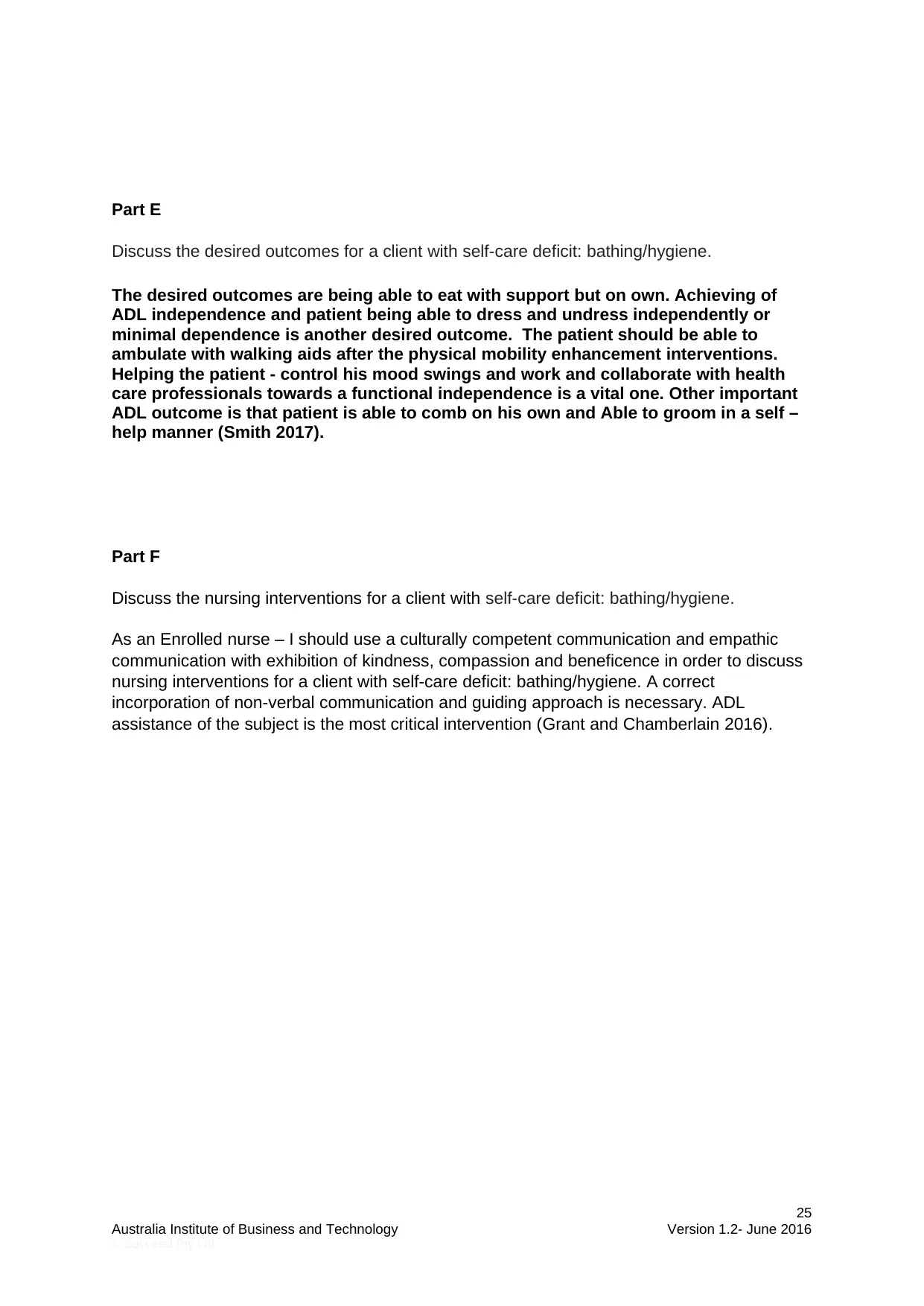
Part E
Discuss the desired outcomes for a client with self-care deficit: bathing/hygiene.
The desired outcomes are being able to eat with support but on own. Achieving of
ADL independence and patient being able to dress and undress independently or
minimal dependence is another desired outcome. The patient should be able to
ambulate with walking aids after the physical mobility enhancement interventions.
Helping the patient - control his mood swings and work and collaborate with health
care professionals towards a functional independence is a vital one. Other important
ADL outcome is that patient is able to comb on his own and Able to groom in a self –
help manner (Smith 2017).
Part F
Discuss the nursing interventions for a client with self-care deficit: bathing/hygiene.
As an Enrolled nurse – I should use a culturally competent communication and empathic
communication with exhibition of kindness, compassion and beneficence in order to discuss
nursing interventions for a client with self-care deficit: bathing/hygiene. A correct
incorporation of non-verbal communication and guiding approach is necessary. ADL
assistance of the subject is the most critical intervention (Grant and Chamberlain 2016).
25
Australia Institute of Business and Technology Version 1.2- June 2016
© Succeed Pty Ltd
Discuss the desired outcomes for a client with self-care deficit: bathing/hygiene.
The desired outcomes are being able to eat with support but on own. Achieving of
ADL independence and patient being able to dress and undress independently or
minimal dependence is another desired outcome. The patient should be able to
ambulate with walking aids after the physical mobility enhancement interventions.
Helping the patient - control his mood swings and work and collaborate with health
care professionals towards a functional independence is a vital one. Other important
ADL outcome is that patient is able to comb on his own and Able to groom in a self –
help manner (Smith 2017).
Part F
Discuss the nursing interventions for a client with self-care deficit: bathing/hygiene.
As an Enrolled nurse – I should use a culturally competent communication and empathic
communication with exhibition of kindness, compassion and beneficence in order to discuss
nursing interventions for a client with self-care deficit: bathing/hygiene. A correct
incorporation of non-verbal communication and guiding approach is necessary. ADL
assistance of the subject is the most critical intervention (Grant and Chamberlain 2016).
25
Australia Institute of Business and Technology Version 1.2- June 2016
© Succeed Pty Ltd
Paraphrase This Document
Need a fresh take? Get an instant paraphrase of this document with our AI Paraphraser
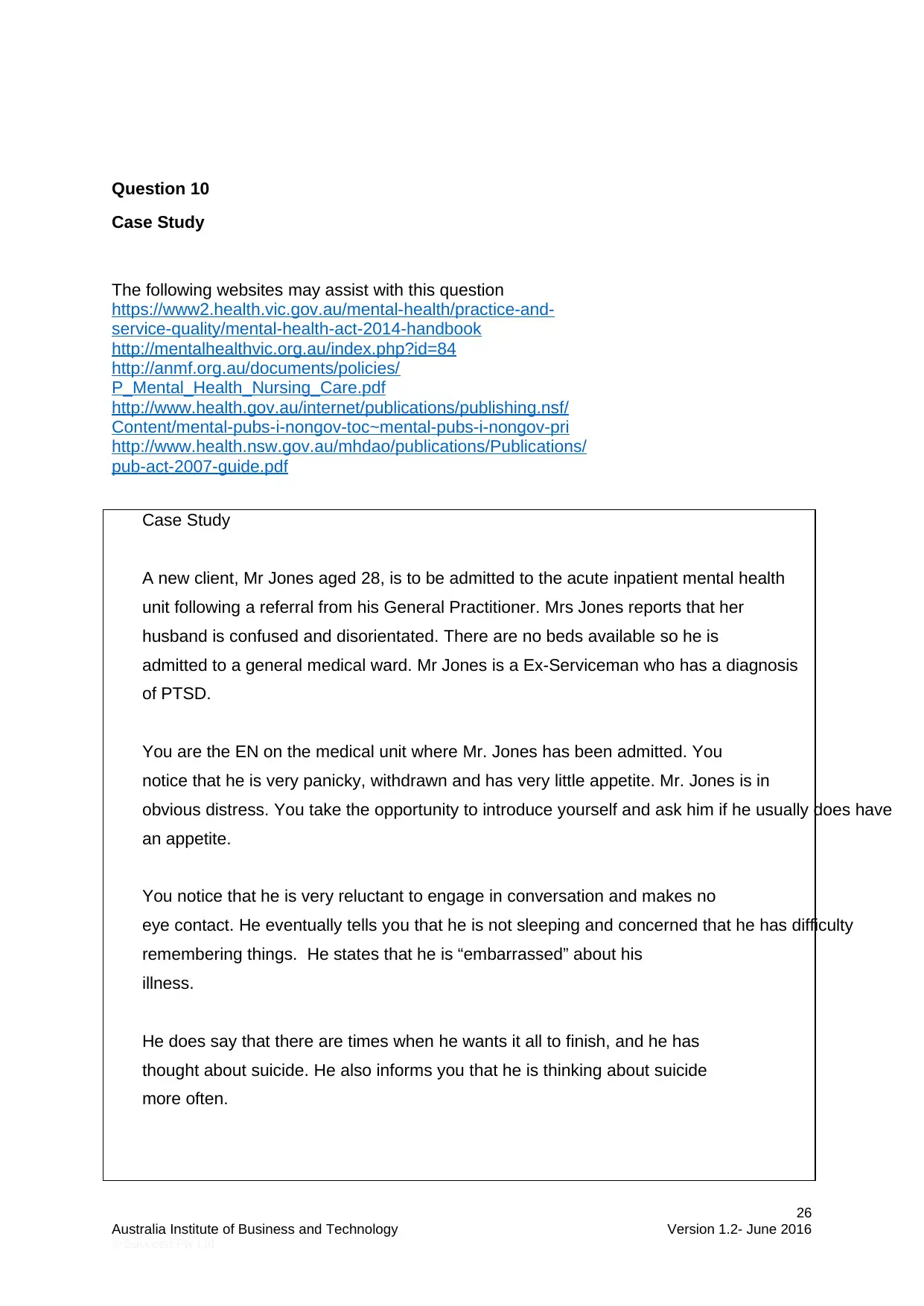
Question 10
Case Study
The following websites may assist with this question
https://www2.health.vic.gov.au/mental-health/practice-and-
service-quality/mental-health-act-2014-handbook
http://mentalhealthvic.org.au/index.php?id=84
http://anmf.org.au/documents/policies/
P_Mental_Health_Nursing_Care.pdf
http://www.health.gov.au/internet/publications/publishing.nsf/
Content/mental-pubs-i-nongov-toc~mental-pubs-i-nongov-pri
http://www.health.nsw.gov.au/mhdao/publications/Publications/
pub-act-2007-guide.pdf
Case Study
A new client, Mr Jones aged 28, is to be admitted to the acute inpatient mental health
unit following a referral from his General Practitioner. Mrs Jones reports that her
husband is confused and disorientated. There are no beds available so he is
admitted to a general medical ward. Mr Jones is a Ex-Serviceman who has a diagnosis
of PTSD.
You are the EN on the medical unit where Mr. Jones has been admitted. You
notice that he is very panicky, withdrawn and has very little appetite. Mr. Jones is in
obvious distress. You take the opportunity to introduce yourself and ask him if he usually does have
an appetite.
You notice that he is very reluctant to engage in conversation and makes no
eye contact. He eventually tells you that he is not sleeping and concerned that he has difficulty
remembering things. He states that he is “embarrassed” about his
illness.
He does say that there are times when he wants it all to finish, and he has
thought about suicide. He also informs you that he is thinking about suicide
more often.
26
Australia Institute of Business and Technology Version 1.2- June 2016
© Succeed Pty Ltd
Case Study
The following websites may assist with this question
https://www2.health.vic.gov.au/mental-health/practice-and-
service-quality/mental-health-act-2014-handbook
http://mentalhealthvic.org.au/index.php?id=84
http://anmf.org.au/documents/policies/
P_Mental_Health_Nursing_Care.pdf
http://www.health.gov.au/internet/publications/publishing.nsf/
Content/mental-pubs-i-nongov-toc~mental-pubs-i-nongov-pri
http://www.health.nsw.gov.au/mhdao/publications/Publications/
pub-act-2007-guide.pdf
Case Study
A new client, Mr Jones aged 28, is to be admitted to the acute inpatient mental health
unit following a referral from his General Practitioner. Mrs Jones reports that her
husband is confused and disorientated. There are no beds available so he is
admitted to a general medical ward. Mr Jones is a Ex-Serviceman who has a diagnosis
of PTSD.
You are the EN on the medical unit where Mr. Jones has been admitted. You
notice that he is very panicky, withdrawn and has very little appetite. Mr. Jones is in
obvious distress. You take the opportunity to introduce yourself and ask him if he usually does have
an appetite.
You notice that he is very reluctant to engage in conversation and makes no
eye contact. He eventually tells you that he is not sleeping and concerned that he has difficulty
remembering things. He states that he is “embarrassed” about his
illness.
He does say that there are times when he wants it all to finish, and he has
thought about suicide. He also informs you that he is thinking about suicide
more often.
26
Australia Institute of Business and Technology Version 1.2- June 2016
© Succeed Pty Ltd
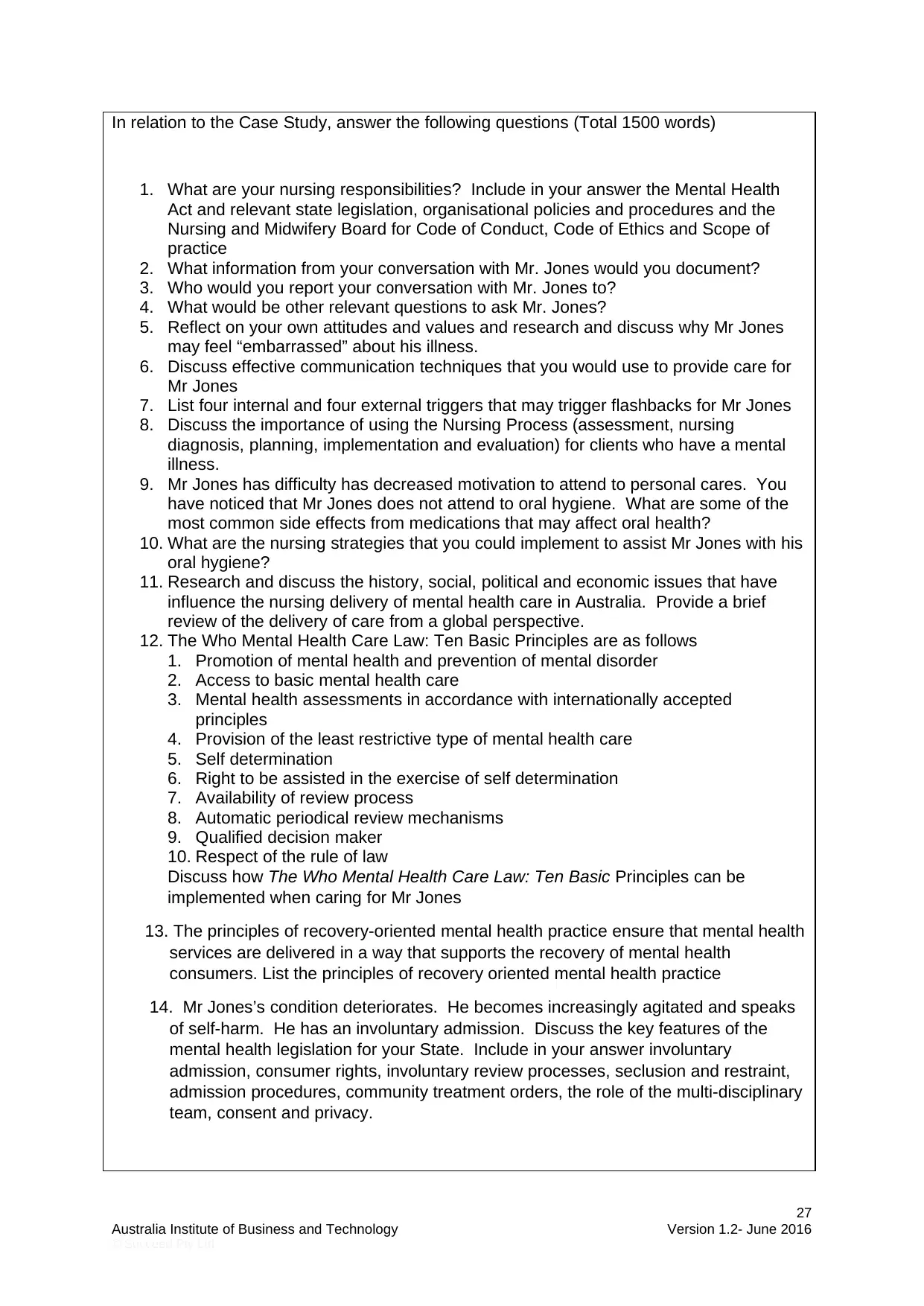
In relation to the Case Study, answer the following questions (Total 1500 words)
1. What are your nursing responsibilities? Include in your answer the Mental Health
Act and relevant state legislation, organisational policies and procedures and the
Nursing and Midwifery Board for Code of Conduct, Code of Ethics and Scope of
practice
2. What information from your conversation with Mr. Jones would you document?
3. Who would you report your conversation with Mr. Jones to?
4. What would be other relevant questions to ask Mr. Jones?
5. Reflect on your own attitudes and values and research and discuss why Mr Jones
may feel “embarrassed” about his illness.
6. Discuss effective communication techniques that you would use to provide care for
Mr Jones
7. List four internal and four external triggers that may trigger flashbacks for Mr Jones
8. Discuss the importance of using the Nursing Process (assessment, nursing
diagnosis, planning, implementation and evaluation) for clients who have a mental
illness.
9. Mr Jones has difficulty has decreased motivation to attend to personal cares. You
have noticed that Mr Jones does not attend to oral hygiene. What are some of the
most common side effects from medications that may affect oral health?
10. What are the nursing strategies that you could implement to assist Mr Jones with his
oral hygiene?
11. Research and discuss the history, social, political and economic issues that have
influence the nursing delivery of mental health care in Australia. Provide a brief
review of the delivery of care from a global perspective.
12. The Who Mental Health Care Law: Ten Basic Principles are as follows
1. Promotion of mental health and prevention of mental disorder
2. Access to basic mental health care
3. Mental health assessments in accordance with internationally accepted
principles
4. Provision of the least restrictive type of mental health care
5. Self determination
6. Right to be assisted in the exercise of self determination
7. Availability of review process
8. Automatic periodical review mechanisms
9. Qualified decision maker
10. Respect of the rule of law
Discuss how The Who Mental Health Care Law: Ten Basic Principles can be
implemented when caring for Mr Jones
13. The principles of recovery-oriented mental health practice ensure that mental health
services are delivered in a way that supports the recovery of mental health
consumers. List the principles of recovery oriented mental health practice
14. Mr Jones’s condition deteriorates. He becomes increasingly agitated and speaks
of self-harm. He has an involuntary admission. Discuss the key features of the
mental health legislation for your State. Include in your answer involuntary
admission, consumer rights, involuntary review processes, seclusion and restraint,
admission procedures, community treatment orders, the role of the multi-disciplinary
team, consent and privacy.
27
Australia Institute of Business and Technology Version 1.2- June 2016
© Succeed Pty Ltd
1. What are your nursing responsibilities? Include in your answer the Mental Health
Act and relevant state legislation, organisational policies and procedures and the
Nursing and Midwifery Board for Code of Conduct, Code of Ethics and Scope of
practice
2. What information from your conversation with Mr. Jones would you document?
3. Who would you report your conversation with Mr. Jones to?
4. What would be other relevant questions to ask Mr. Jones?
5. Reflect on your own attitudes and values and research and discuss why Mr Jones
may feel “embarrassed” about his illness.
6. Discuss effective communication techniques that you would use to provide care for
Mr Jones
7. List four internal and four external triggers that may trigger flashbacks for Mr Jones
8. Discuss the importance of using the Nursing Process (assessment, nursing
diagnosis, planning, implementation and evaluation) for clients who have a mental
illness.
9. Mr Jones has difficulty has decreased motivation to attend to personal cares. You
have noticed that Mr Jones does not attend to oral hygiene. What are some of the
most common side effects from medications that may affect oral health?
10. What are the nursing strategies that you could implement to assist Mr Jones with his
oral hygiene?
11. Research and discuss the history, social, political and economic issues that have
influence the nursing delivery of mental health care in Australia. Provide a brief
review of the delivery of care from a global perspective.
12. The Who Mental Health Care Law: Ten Basic Principles are as follows
1. Promotion of mental health and prevention of mental disorder
2. Access to basic mental health care
3. Mental health assessments in accordance with internationally accepted
principles
4. Provision of the least restrictive type of mental health care
5. Self determination
6. Right to be assisted in the exercise of self determination
7. Availability of review process
8. Automatic periodical review mechanisms
9. Qualified decision maker
10. Respect of the rule of law
Discuss how The Who Mental Health Care Law: Ten Basic Principles can be
implemented when caring for Mr Jones
13. The principles of recovery-oriented mental health practice ensure that mental health
services are delivered in a way that supports the recovery of mental health
consumers. List the principles of recovery oriented mental health practice
14. Mr Jones’s condition deteriorates. He becomes increasingly agitated and speaks
of self-harm. He has an involuntary admission. Discuss the key features of the
mental health legislation for your State. Include in your answer involuntary
admission, consumer rights, involuntary review processes, seclusion and restraint,
admission procedures, community treatment orders, the role of the multi-disciplinary
team, consent and privacy.
27
Australia Institute of Business and Technology Version 1.2- June 2016
© Succeed Pty Ltd
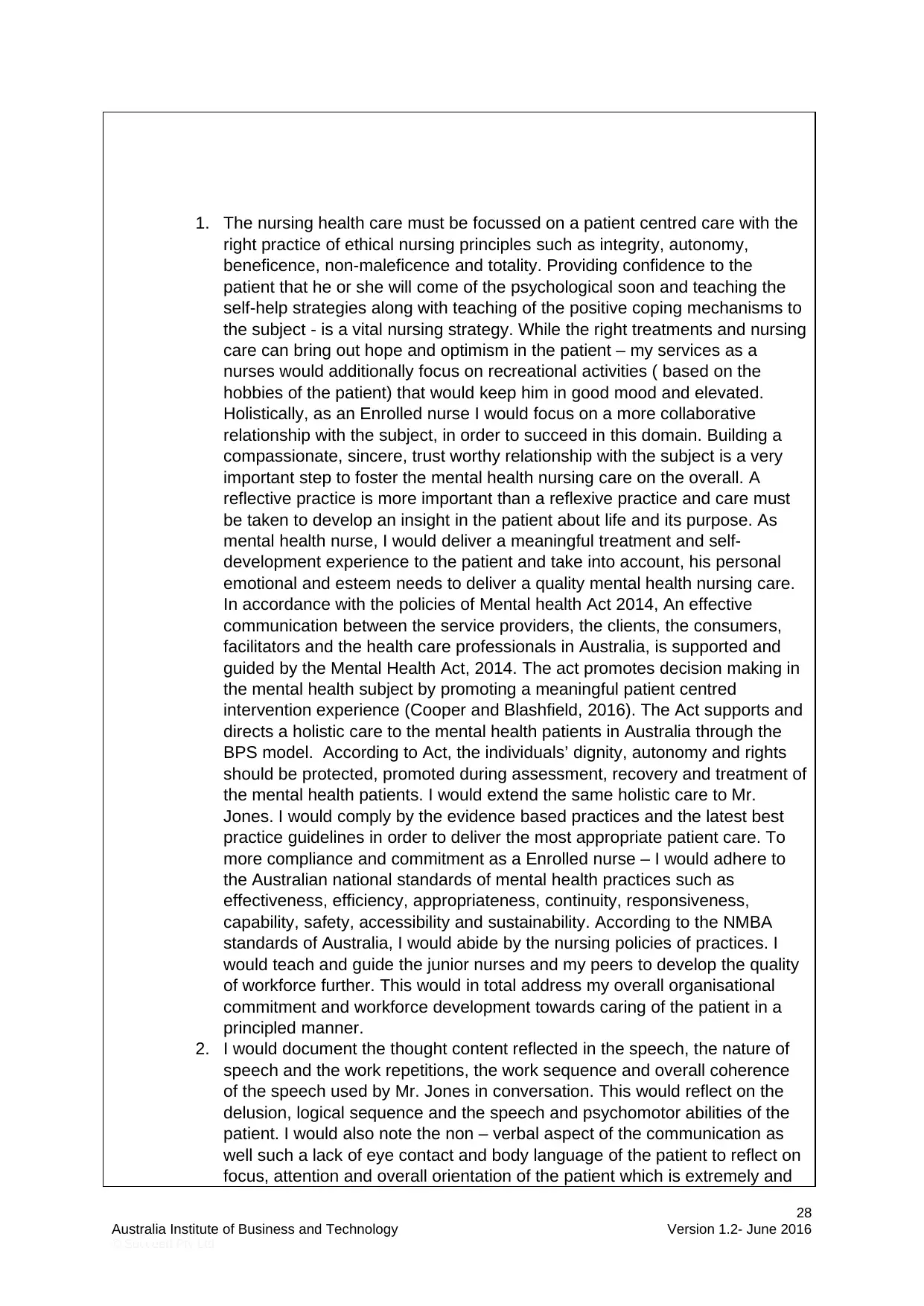
1. The nursing health care must be focussed on a patient centred care with the
right practice of ethical nursing principles such as integrity, autonomy,
beneficence, non-maleficence and totality. Providing confidence to the
patient that he or she will come of the psychological soon and teaching the
self-help strategies along with teaching of the positive coping mechanisms to
the subject - is a vital nursing strategy. While the right treatments and nursing
care can bring out hope and optimism in the patient – my services as a
nurses would additionally focus on recreational activities ( based on the
hobbies of the patient) that would keep him in good mood and elevated.
Holistically, as an Enrolled nurse I would focus on a more collaborative
relationship with the subject, in order to succeed in this domain. Building a
compassionate, sincere, trust worthy relationship with the subject is a very
important step to foster the mental health nursing care on the overall. A
reflective practice is more important than a reflexive practice and care must
be taken to develop an insight in the patient about life and its purpose. As
mental health nurse, I would deliver a meaningful treatment and self-
development experience to the patient and take into account, his personal
emotional and esteem needs to deliver a quality mental health nursing care.
In accordance with the policies of Mental health Act 2014, An effective
communication between the service providers, the clients, the consumers,
facilitators and the health care professionals in Australia, is supported and
guided by the Mental Health Act, 2014. The act promotes decision making in
the mental health subject by promoting a meaningful patient centred
intervention experience (Cooper and Blashfield, 2016). The Act supports and
directs a holistic care to the mental health patients in Australia through the
BPS model. According to Act, the individuals’ dignity, autonomy and rights
should be protected, promoted during assessment, recovery and treatment of
the mental health patients. I would extend the same holistic care to Mr.
Jones. I would comply by the evidence based practices and the latest best
practice guidelines in order to deliver the most appropriate patient care. To
more compliance and commitment as a Enrolled nurse – I would adhere to
the Australian national standards of mental health practices such as
effectiveness, efficiency, appropriateness, continuity, responsiveness,
capability, safety, accessibility and sustainability. According to the NMBA
standards of Australia, I would abide by the nursing policies of practices. I
would teach and guide the junior nurses and my peers to develop the quality
of workforce further. This would in total address my overall organisational
commitment and workforce development towards caring of the patient in a
principled manner.
2. I would document the thought content reflected in the speech, the nature of
speech and the work repetitions, the work sequence and overall coherence
of the speech used by Mr. Jones in conversation. This would reflect on the
delusion, logical sequence and the speech and psychomotor abilities of the
patient. I would also note the non – verbal aspect of the communication as
well such a lack of eye contact and body language of the patient to reflect on
focus, attention and overall orientation of the patient which is extremely and
28
Australia Institute of Business and Technology Version 1.2- June 2016
© Succeed Pty Ltd
right practice of ethical nursing principles such as integrity, autonomy,
beneficence, non-maleficence and totality. Providing confidence to the
patient that he or she will come of the psychological soon and teaching the
self-help strategies along with teaching of the positive coping mechanisms to
the subject - is a vital nursing strategy. While the right treatments and nursing
care can bring out hope and optimism in the patient – my services as a
nurses would additionally focus on recreational activities ( based on the
hobbies of the patient) that would keep him in good mood and elevated.
Holistically, as an Enrolled nurse I would focus on a more collaborative
relationship with the subject, in order to succeed in this domain. Building a
compassionate, sincere, trust worthy relationship with the subject is a very
important step to foster the mental health nursing care on the overall. A
reflective practice is more important than a reflexive practice and care must
be taken to develop an insight in the patient about life and its purpose. As
mental health nurse, I would deliver a meaningful treatment and self-
development experience to the patient and take into account, his personal
emotional and esteem needs to deliver a quality mental health nursing care.
In accordance with the policies of Mental health Act 2014, An effective
communication between the service providers, the clients, the consumers,
facilitators and the health care professionals in Australia, is supported and
guided by the Mental Health Act, 2014. The act promotes decision making in
the mental health subject by promoting a meaningful patient centred
intervention experience (Cooper and Blashfield, 2016). The Act supports and
directs a holistic care to the mental health patients in Australia through the
BPS model. According to Act, the individuals’ dignity, autonomy and rights
should be protected, promoted during assessment, recovery and treatment of
the mental health patients. I would extend the same holistic care to Mr.
Jones. I would comply by the evidence based practices and the latest best
practice guidelines in order to deliver the most appropriate patient care. To
more compliance and commitment as a Enrolled nurse – I would adhere to
the Australian national standards of mental health practices such as
effectiveness, efficiency, appropriateness, continuity, responsiveness,
capability, safety, accessibility and sustainability. According to the NMBA
standards of Australia, I would abide by the nursing policies of practices. I
would teach and guide the junior nurses and my peers to develop the quality
of workforce further. This would in total address my overall organisational
commitment and workforce development towards caring of the patient in a
principled manner.
2. I would document the thought content reflected in the speech, the nature of
speech and the work repetitions, the work sequence and overall coherence
of the speech used by Mr. Jones in conversation. This would reflect on the
delusion, logical sequence and the speech and psychomotor abilities of the
patient. I would also note the non – verbal aspect of the communication as
well such a lack of eye contact and body language of the patient to reflect on
focus, attention and overall orientation of the patient which is extremely and
28
Australia Institute of Business and Technology Version 1.2- June 2016
© Succeed Pty Ltd
Secure Best Marks with AI Grader
Need help grading? Try our AI Grader for instant feedback on your assignments.
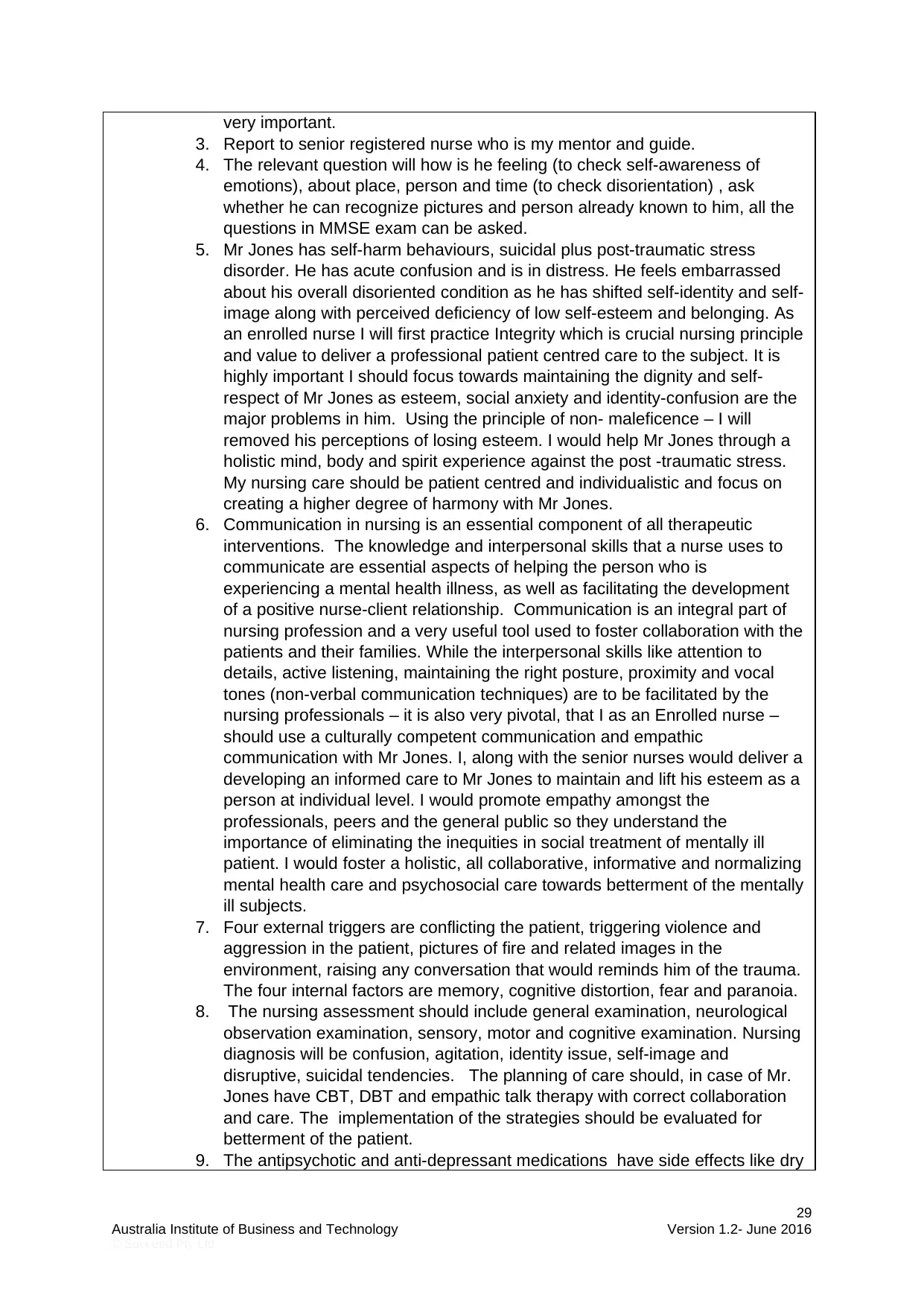
very important.
3. Report to senior registered nurse who is my mentor and guide.
4. The relevant question will how is he feeling (to check self-awareness of
emotions), about place, person and time (to check disorientation) , ask
whether he can recognize pictures and person already known to him, all the
questions in MMSE exam can be asked.
5. Mr Jones has self-harm behaviours, suicidal plus post-traumatic stress
disorder. He has acute confusion and is in distress. He feels embarrassed
about his overall disoriented condition as he has shifted self-identity and self-
image along with perceived deficiency of low self-esteem and belonging. As
an enrolled nurse I will first practice Integrity which is crucial nursing principle
and value to deliver a professional patient centred care to the subject. It is
highly important I should focus towards maintaining the dignity and self-
respect of Mr Jones as esteem, social anxiety and identity-confusion are the
major problems in him. Using the principle of non- maleficence – I will
removed his perceptions of losing esteem. I would help Mr Jones through a
holistic mind, body and spirit experience against the post -traumatic stress.
My nursing care should be patient centred and individualistic and focus on
creating a higher degree of harmony with Mr Jones.
6. Communication in nursing is an essential component of all therapeutic
interventions. The knowledge and interpersonal skills that a nurse uses to
communicate are essential aspects of helping the person who is
experiencing a mental health illness, as well as facilitating the development
of a positive nurse-client relationship. Communication is an integral part of
nursing profession and a very useful tool used to foster collaboration with the
patients and their families. While the interpersonal skills like attention to
details, active listening, maintaining the right posture, proximity and vocal
tones (non-verbal communication techniques) are to be facilitated by the
nursing professionals – it is also very pivotal, that I as an Enrolled nurse –
should use a culturally competent communication and empathic
communication with Mr Jones. I, along with the senior nurses would deliver a
developing an informed care to Mr Jones to maintain and lift his esteem as a
person at individual level. I would promote empathy amongst the
professionals, peers and the general public so they understand the
importance of eliminating the inequities in social treatment of mentally ill
patient. I would foster a holistic, all collaborative, informative and normalizing
mental health care and psychosocial care towards betterment of the mentally
ill subjects.
7. Four external triggers are conflicting the patient, triggering violence and
aggression in the patient, pictures of fire and related images in the
environment, raising any conversation that would reminds him of the trauma.
The four internal factors are memory, cognitive distortion, fear and paranoia.
8. The nursing assessment should include general examination, neurological
observation examination, sensory, motor and cognitive examination. Nursing
diagnosis will be confusion, agitation, identity issue, self-image and
disruptive, suicidal tendencies. The planning of care should, in case of Mr.
Jones have CBT, DBT and empathic talk therapy with correct collaboration
and care. The implementation of the strategies should be evaluated for
betterment of the patient.
9. The antipsychotic and anti-depressant medications have side effects like dry
29
Australia Institute of Business and Technology Version 1.2- June 2016
© Succeed Pty Ltd
3. Report to senior registered nurse who is my mentor and guide.
4. The relevant question will how is he feeling (to check self-awareness of
emotions), about place, person and time (to check disorientation) , ask
whether he can recognize pictures and person already known to him, all the
questions in MMSE exam can be asked.
5. Mr Jones has self-harm behaviours, suicidal plus post-traumatic stress
disorder. He has acute confusion and is in distress. He feels embarrassed
about his overall disoriented condition as he has shifted self-identity and self-
image along with perceived deficiency of low self-esteem and belonging. As
an enrolled nurse I will first practice Integrity which is crucial nursing principle
and value to deliver a professional patient centred care to the subject. It is
highly important I should focus towards maintaining the dignity and self-
respect of Mr Jones as esteem, social anxiety and identity-confusion are the
major problems in him. Using the principle of non- maleficence – I will
removed his perceptions of losing esteem. I would help Mr Jones through a
holistic mind, body and spirit experience against the post -traumatic stress.
My nursing care should be patient centred and individualistic and focus on
creating a higher degree of harmony with Mr Jones.
6. Communication in nursing is an essential component of all therapeutic
interventions. The knowledge and interpersonal skills that a nurse uses to
communicate are essential aspects of helping the person who is
experiencing a mental health illness, as well as facilitating the development
of a positive nurse-client relationship. Communication is an integral part of
nursing profession and a very useful tool used to foster collaboration with the
patients and their families. While the interpersonal skills like attention to
details, active listening, maintaining the right posture, proximity and vocal
tones (non-verbal communication techniques) are to be facilitated by the
nursing professionals – it is also very pivotal, that I as an Enrolled nurse –
should use a culturally competent communication and empathic
communication with Mr Jones. I, along with the senior nurses would deliver a
developing an informed care to Mr Jones to maintain and lift his esteem as a
person at individual level. I would promote empathy amongst the
professionals, peers and the general public so they understand the
importance of eliminating the inequities in social treatment of mentally ill
patient. I would foster a holistic, all collaborative, informative and normalizing
mental health care and psychosocial care towards betterment of the mentally
ill subjects.
7. Four external triggers are conflicting the patient, triggering violence and
aggression in the patient, pictures of fire and related images in the
environment, raising any conversation that would reminds him of the trauma.
The four internal factors are memory, cognitive distortion, fear and paranoia.
8. The nursing assessment should include general examination, neurological
observation examination, sensory, motor and cognitive examination. Nursing
diagnosis will be confusion, agitation, identity issue, self-image and
disruptive, suicidal tendencies. The planning of care should, in case of Mr.
Jones have CBT, DBT and empathic talk therapy with correct collaboration
and care. The implementation of the strategies should be evaluated for
betterment of the patient.
9. The antipsychotic and anti-depressant medications have side effects like dry
29
Australia Institute of Business and Technology Version 1.2- June 2016
© Succeed Pty Ltd

mouth.
10. Motivating regular brushing and cleaning of teeth, keeping the tooth brushes
in vicinity of the patient to help him remind the same. Keeping dental hygiene
pictures can also help and is a vital strategy. Assisting him in the process like
handing over the brush is useful.
11. . The history along with the influence from the sociocultural and socio-
political factors emphasized on the emergence of five major professions
which were actively involved in care and management of mental health
patients in Australia and from a global perspective. These professions were
psychology, occupational therapy, psychiatry, mental health nursing and
social work. With the passage of time in the history, more professions such
as art therapists, dieticians, music therapists, exercise physiologists, speech
and community rehabilitation nurses entered the field of mental health care
thus contributing to the care of patients suffering from mental illnesses.
12. In case of Mr Jones - the complete patient centred nursing with practice of
nursing principles and health care policies Mental health assessments in
accordance with internationally accepted principles can used to help Mr.
Jones with ‘Self-determination’ and right to be guided in practice of self -
determination. The nursing review processes has to be used in a Qualified
and quick decision making.
13. They are – 1. Domain 1: Promoting a culture and language of hope and
optimism. 2. Domain 2: Person 1st and holistic – helping the subject with a
holistic nursing care is my nursing priority. 3. Domain 3: Supporting personal
recovery – as a mental health nurse, I would promote autonomy, self-
determination in the patient. 4. Domain 4: Organisational commitment and
workforce development – as nursing professional, I would work towards more
collaboration with the other disciplinary expertise in order to deliver holistic,
patient centred care to the patient. 5. Domain 5: Action on social inclusion
and the social determinants of health, mental health and wellbeing – this is
an important domain pertaining to mental health care and profession.
14. The involuntary review process in New South Wales begins by taking into
consideration whether the subject has a serious mental illness and exhibits
violent and aggressive behaviours in social situations. As per the involuntary
review process – the person’s continuing condition, physical deterioration is
also considered. In the process, at first an involuntary patient order is given
by the magistrate in a mental health facility (for up to a 3 months period). The
service can be extended by magistrate from s35 to s37. The review, as per
the Australian law, has to be done every 3 months one first 12 months and
following that, once every six months in the next year. Mr. Jones will retain
his rights.
30
Australia Institute of Business and Technology Version 1.2- June 2016
© Succeed Pty Ltd
10. Motivating regular brushing and cleaning of teeth, keeping the tooth brushes
in vicinity of the patient to help him remind the same. Keeping dental hygiene
pictures can also help and is a vital strategy. Assisting him in the process like
handing over the brush is useful.
11. . The history along with the influence from the sociocultural and socio-
political factors emphasized on the emergence of five major professions
which were actively involved in care and management of mental health
patients in Australia and from a global perspective. These professions were
psychology, occupational therapy, psychiatry, mental health nursing and
social work. With the passage of time in the history, more professions such
as art therapists, dieticians, music therapists, exercise physiologists, speech
and community rehabilitation nurses entered the field of mental health care
thus contributing to the care of patients suffering from mental illnesses.
12. In case of Mr Jones - the complete patient centred nursing with practice of
nursing principles and health care policies Mental health assessments in
accordance with internationally accepted principles can used to help Mr.
Jones with ‘Self-determination’ and right to be guided in practice of self -
determination. The nursing review processes has to be used in a Qualified
and quick decision making.
13. They are – 1. Domain 1: Promoting a culture and language of hope and
optimism. 2. Domain 2: Person 1st and holistic – helping the subject with a
holistic nursing care is my nursing priority. 3. Domain 3: Supporting personal
recovery – as a mental health nurse, I would promote autonomy, self-
determination in the patient. 4. Domain 4: Organisational commitment and
workforce development – as nursing professional, I would work towards more
collaboration with the other disciplinary expertise in order to deliver holistic,
patient centred care to the patient. 5. Domain 5: Action on social inclusion
and the social determinants of health, mental health and wellbeing – this is
an important domain pertaining to mental health care and profession.
14. The involuntary review process in New South Wales begins by taking into
consideration whether the subject has a serious mental illness and exhibits
violent and aggressive behaviours in social situations. As per the involuntary
review process – the person’s continuing condition, physical deterioration is
also considered. In the process, at first an involuntary patient order is given
by the magistrate in a mental health facility (for up to a 3 months period). The
service can be extended by magistrate from s35 to s37. The review, as per
the Australian law, has to be done every 3 months one first 12 months and
following that, once every six months in the next year. Mr. Jones will retain
his rights.
30
Australia Institute of Business and Technology Version 1.2- June 2016
© Succeed Pty Ltd
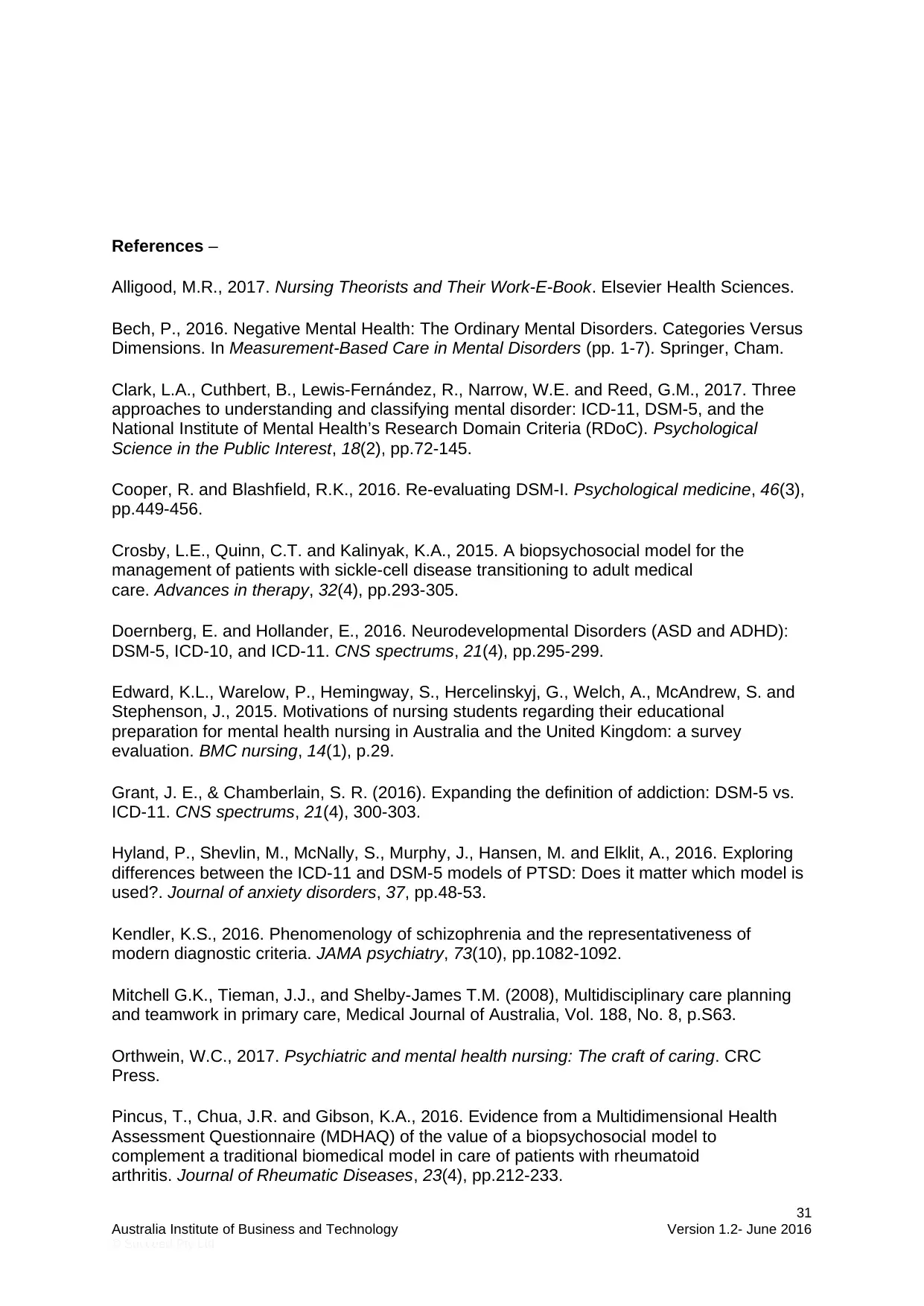
References –
Alligood, M.R., 2017. Nursing Theorists and Their Work-E-Book. Elsevier Health Sciences.
Bech, P., 2016. Negative Mental Health: The Ordinary Mental Disorders. Categories Versus
Dimensions. In Measurement-Based Care in Mental Disorders (pp. 1-7). Springer, Cham.
Clark, L.A., Cuthbert, B., Lewis-Fernández, R., Narrow, W.E. and Reed, G.M., 2017. Three
approaches to understanding and classifying mental disorder: ICD-11, DSM-5, and the
National Institute of Mental Health’s Research Domain Criteria (RDoC). Psychological
Science in the Public Interest, 18(2), pp.72-145.
Cooper, R. and Blashfield, R.K., 2016. Re-evaluating DSM-I. Psychological medicine, 46(3),
pp.449-456.
Crosby, L.E., Quinn, C.T. and Kalinyak, K.A., 2015. A biopsychosocial model for the
management of patients with sickle-cell disease transitioning to adult medical
care. Advances in therapy, 32(4), pp.293-305.
Doernberg, E. and Hollander, E., 2016. Neurodevelopmental Disorders (ASD and ADHD):
DSM-5, ICD-10, and ICD-11. CNS spectrums, 21(4), pp.295-299.
Edward, K.L., Warelow, P., Hemingway, S., Hercelinskyj, G., Welch, A., McAndrew, S. and
Stephenson, J., 2015. Motivations of nursing students regarding their educational
preparation for mental health nursing in Australia and the United Kingdom: a survey
evaluation. BMC nursing, 14(1), p.29.
Grant, J. E., & Chamberlain, S. R. (2016). Expanding the definition of addiction: DSM-5 vs.
ICD-11. CNS spectrums, 21(4), 300-303.
Hyland, P., Shevlin, M., McNally, S., Murphy, J., Hansen, M. and Elklit, A., 2016. Exploring
differences between the ICD-11 and DSM-5 models of PTSD: Does it matter which model is
used?. Journal of anxiety disorders, 37, pp.48-53.
Kendler, K.S., 2016. Phenomenology of schizophrenia and the representativeness of
modern diagnostic criteria. JAMA psychiatry, 73(10), pp.1082-1092.
Mitchell G.K., Tieman, J.J., and Shelby-James T.M. (2008), Multidisciplinary care planning
and teamwork in primary care, Medical Journal of Australia, Vol. 188, No. 8, p.S63.
Orthwein, W.C., 2017. Psychiatric and mental health nursing: The craft of caring. CRC
Press.
Pincus, T., Chua, J.R. and Gibson, K.A., 2016. Evidence from a Multidimensional Health
Assessment Questionnaire (MDHAQ) of the value of a biopsychosocial model to
complement a traditional biomedical model in care of patients with rheumatoid
arthritis. Journal of Rheumatic Diseases, 23(4), pp.212-233.
31
Australia Institute of Business and Technology Version 1.2- June 2016
© Succeed Pty Ltd
Alligood, M.R., 2017. Nursing Theorists and Their Work-E-Book. Elsevier Health Sciences.
Bech, P., 2016. Negative Mental Health: The Ordinary Mental Disorders. Categories Versus
Dimensions. In Measurement-Based Care in Mental Disorders (pp. 1-7). Springer, Cham.
Clark, L.A., Cuthbert, B., Lewis-Fernández, R., Narrow, W.E. and Reed, G.M., 2017. Three
approaches to understanding and classifying mental disorder: ICD-11, DSM-5, and the
National Institute of Mental Health’s Research Domain Criteria (RDoC). Psychological
Science in the Public Interest, 18(2), pp.72-145.
Cooper, R. and Blashfield, R.K., 2016. Re-evaluating DSM-I. Psychological medicine, 46(3),
pp.449-456.
Crosby, L.E., Quinn, C.T. and Kalinyak, K.A., 2015. A biopsychosocial model for the
management of patients with sickle-cell disease transitioning to adult medical
care. Advances in therapy, 32(4), pp.293-305.
Doernberg, E. and Hollander, E., 2016. Neurodevelopmental Disorders (ASD and ADHD):
DSM-5, ICD-10, and ICD-11. CNS spectrums, 21(4), pp.295-299.
Edward, K.L., Warelow, P., Hemingway, S., Hercelinskyj, G., Welch, A., McAndrew, S. and
Stephenson, J., 2015. Motivations of nursing students regarding their educational
preparation for mental health nursing in Australia and the United Kingdom: a survey
evaluation. BMC nursing, 14(1), p.29.
Grant, J. E., & Chamberlain, S. R. (2016). Expanding the definition of addiction: DSM-5 vs.
ICD-11. CNS spectrums, 21(4), 300-303.
Hyland, P., Shevlin, M., McNally, S., Murphy, J., Hansen, M. and Elklit, A., 2016. Exploring
differences between the ICD-11 and DSM-5 models of PTSD: Does it matter which model is
used?. Journal of anxiety disorders, 37, pp.48-53.
Kendler, K.S., 2016. Phenomenology of schizophrenia and the representativeness of
modern diagnostic criteria. JAMA psychiatry, 73(10), pp.1082-1092.
Mitchell G.K., Tieman, J.J., and Shelby-James T.M. (2008), Multidisciplinary care planning
and teamwork in primary care, Medical Journal of Australia, Vol. 188, No. 8, p.S63.
Orthwein, W.C., 2017. Psychiatric and mental health nursing: The craft of caring. CRC
Press.
Pincus, T., Chua, J.R. and Gibson, K.A., 2016. Evidence from a Multidimensional Health
Assessment Questionnaire (MDHAQ) of the value of a biopsychosocial model to
complement a traditional biomedical model in care of patients with rheumatoid
arthritis. Journal of Rheumatic Diseases, 23(4), pp.212-233.
31
Australia Institute of Business and Technology Version 1.2- June 2016
© Succeed Pty Ltd
Paraphrase This Document
Need a fresh take? Get an instant paraphrase of this document with our AI Paraphraser

Quinn, C., Platania‐Phung, C., Bale, C., Happell, B. and Hughes, E., 2018. Understanding
the current sexual health service provision for mental health consumers by nurses in mental
health settings: findings from a survey in Australia and England. International journal of
mental health nursing, 27(5), pp.1522-1534.
Robertson, D., 2018. The philosophy of cognitive-behavioural therapy (CBT): Stoic
philosophy as rational and cognitive psychotherapy. Routledge.
Ryan, T. and Hurley, J., 2018. Ability, sustainability and visibility: articulating, promoting and
enhancing mental health nursing psychotherapy in Australia. International Journal of Mental
Health Nursing, 27(S1), p.43.
Smith, J., 2017. Conducting generic talk therapy. In Psychotherapy (pp. 111-124). Springer,
Cham.
Wade, D.T. and Halligan, P.W., 2017. The biopsychosocial model of illness: a model whose
time has come.
Wakefield, J.C., 2015. DSM-5, psychiatric epidemiology and the false positives
problem. Epidemiology and Psychiatric Sciences, 24(3), pp.188-196.
Wakefield, J.C., 2016. Diagnostic issues and controversies in DSM-5: return of the false
positives problem. Annual review of clinical psychology, 12, pp.105-132.
Wynaden, D., Heslop, B., Heslop, K., Barr, L., Lim, E., Chee, G.L., Porter, J. and Murdock,
J., 2016. The chasm of care: Where does the mental health nursing responsibility lie for the
physical health care of people with severe mental illness?. International journal of mental
health nursing, 25(6), pp.516-525.
Zachar, P., Krueger, R.F. and Kendler, K.S., 2016. Personality disorder in DSM-5: An oral
history. Psychological Medicine, 46(1), pp.1-10.
32
Australia Institute of Business and Technology Version 1.2- June 2016
© Succeed Pty Ltd
the current sexual health service provision for mental health consumers by nurses in mental
health settings: findings from a survey in Australia and England. International journal of
mental health nursing, 27(5), pp.1522-1534.
Robertson, D., 2018. The philosophy of cognitive-behavioural therapy (CBT): Stoic
philosophy as rational and cognitive psychotherapy. Routledge.
Ryan, T. and Hurley, J., 2018. Ability, sustainability and visibility: articulating, promoting and
enhancing mental health nursing psychotherapy in Australia. International Journal of Mental
Health Nursing, 27(S1), p.43.
Smith, J., 2017. Conducting generic talk therapy. In Psychotherapy (pp. 111-124). Springer,
Cham.
Wade, D.T. and Halligan, P.W., 2017. The biopsychosocial model of illness: a model whose
time has come.
Wakefield, J.C., 2015. DSM-5, psychiatric epidemiology and the false positives
problem. Epidemiology and Psychiatric Sciences, 24(3), pp.188-196.
Wakefield, J.C., 2016. Diagnostic issues and controversies in DSM-5: return of the false
positives problem. Annual review of clinical psychology, 12, pp.105-132.
Wynaden, D., Heslop, B., Heslop, K., Barr, L., Lim, E., Chee, G.L., Porter, J. and Murdock,
J., 2016. The chasm of care: Where does the mental health nursing responsibility lie for the
physical health care of people with severe mental illness?. International journal of mental
health nursing, 25(6), pp.516-525.
Zachar, P., Krueger, R.F. and Kendler, K.S., 2016. Personality disorder in DSM-5: An oral
history. Psychological Medicine, 46(1), pp.1-10.
32
Australia Institute of Business and Technology Version 1.2- June 2016
© Succeed Pty Ltd
1 out of 32
Related Documents
Your All-in-One AI-Powered Toolkit for Academic Success.
+13062052269
info@desklib.com
Available 24*7 on WhatsApp / Email
![[object Object]](/_next/static/media/star-bottom.7253800d.svg)
Unlock your academic potential
© 2024 | Zucol Services PVT LTD | All rights reserved.





